

Titanic vs. Modern Cruise Ship: How Do They Compare?
- April 14, 2024
- Cruise Ships
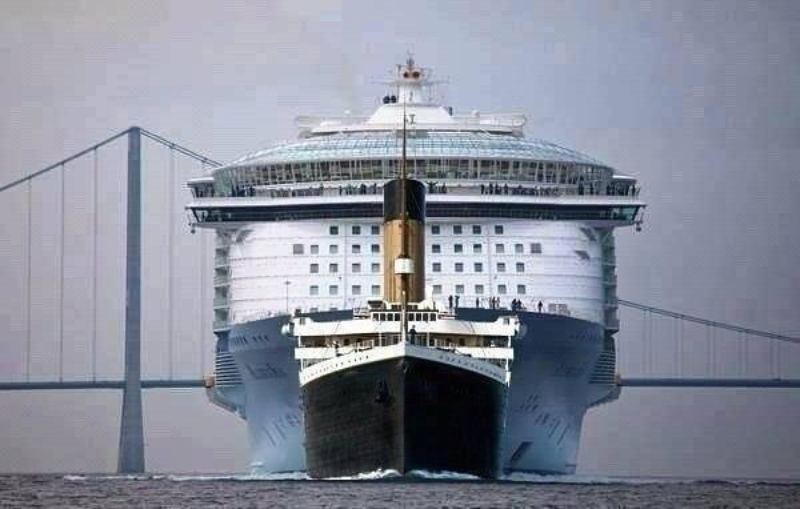
You might be wondering how the Titanic, once deemed the “unsinkable” ship, compares to the giant floating resorts we know today as modern cruise ships. When the Titanic embarked on its tragic maiden voyage in 1912, it represented the height of luxury and cutting-edge technology for ocean liners.
In contrast, today’s cruise ships are designed with ultimate luxury and passenger entertainment in mind, resembling more a miniature city than a simple ship. These modern giants of the sea offer everything from Broadway-style shows and elaborate water parks to gourmet dining experiences, prioritizing passenger comfort over all else.
This article will explore the similarities and differences between the RMS Titanic and current cruise ships, delving into aspects such as size, design, amenities, safety features, and the overall passenger experience.
The Titanic Wasn’t Actually a Cruise Ship
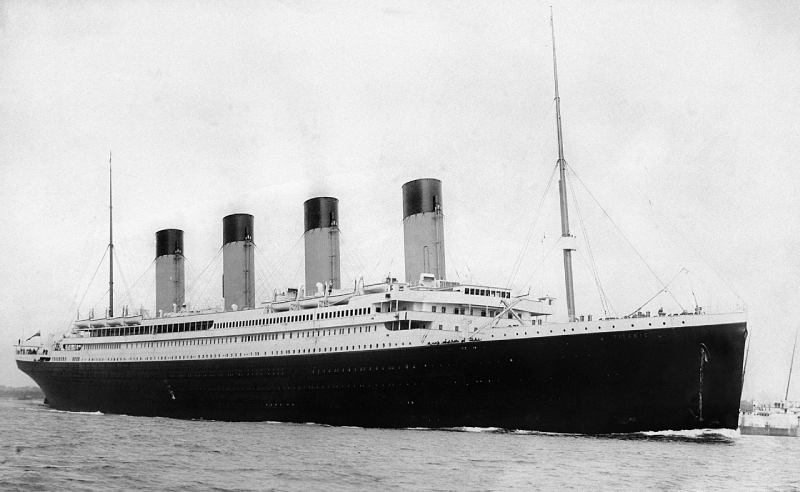
Despite its fame and the luxury it offered passengers, the Titanic wasn’t actually a cruise ship. Instead, it was an ocean liner, a type of ship designed for transporting people across the ocean from one point to another. Ocean liners usually have a stronger build and a deeper hull to handle rough sea conditions. They typically operate on fixed routes, like the transatlantic crossings between Europe and North America. Additionally, ocean liners are faster than cruise ships, with average speeds of about 25-30 knots (29 mph/47 kph).
In contrast, cruise ships are focused on leisure and entertainment, providing a vacation experience with stops at various ports of call. They are like floating resorts with numerous amenities such as swimming pools, theaters, restaurants, and sometimes even ice-skating rinks or climbing walls. The journey on a cruise ship is meant to be as enjoyable as the destinations themselves, with activities and entertainment available throughout the day and night.
Titanic vs. Modern Cruise Ship: Size
Gross tonnage.
The best way to compare the size of the Titanic vs. a modern cruise ship is by using GT (gross tonnage). GT is used to measure a ship’s overall internal volume. The Titanic, once the largest ship in the world, had a gross tonnage (GT) of 46,329. Today, that figure would not even place it within the top 64 largest cruise ships!
For comparison, Royal Caribbean’s Symphony of the Seas has a gross tonnage of around 228,081—nearly five times larger than the Titanic. The world’s largest cruise ship, the Icon of the Seas, has a gross tonnage of 248,663. Even Carnival’s smallest ship, the Carnival Elation, has a gross tonnage of 70,367, far surpassing the Titanic.

The Titanic was shorter than modern cruise ships, stretching around 882 ft. (269 m) in length. In comparison, the Icon of the Seas measures a notable 1,196 ft. (364 m) long, and the Wonder of the Seas isn’t far behind at 1,188 ft. (362 m). Both of these modern cruise ships exceed the length of the Titanic by over 300 ft. (about 91 m).
Despite the increase in ship sizes, the difference in length between the Titanic and many modern cruise ships isn’t as large as it seems. For example, Royal Caribbean’s smallest ship, the Majesty of the Seas, is 879 ft. long (268 m), which is 3 ft. shorter than the Titanic. The average length of a cruise ship today is around 1,000 ft. (304 m). This shows that despite modern ships being larger, the average length hasn’t increased by much since the Titanic.
The reason modern cruise ships are not much longer than the Titanic is mostly due to the limitations of port infrastructure. Most ports can’t accommodate ships beyond a certain length, which naturally caps how long these ships can be. As a result, cruise lines have adapted by designing taller ships with multiple decks, rather than extending their length.
Beam (Width)
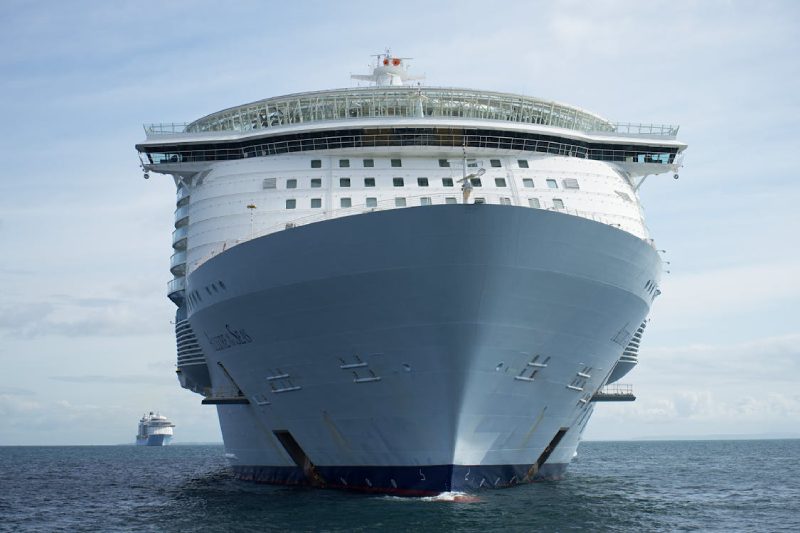
The Titanic had a beam (width) of 92 ft. (28 m). In comparison, modern cruise ships are much wider. For instance, Royal Caribbean’s Icon of the Seas has a beam of 159 ft (48 m), and the Wonder of the Seas measures slightly narrower at 155 ft. (47 m). Even Royal Caribbean’s smallest ship, the Majesty of the Seas, has a beam of 105 ft. (32 m), which still exceeds the Titanic’s width by quite a lot.
The draft of a ship measures the distance between the waterline and the lowest part of the ship’s hull. Surprisingly, the draft of large ships like the Titanic and modern cruise ships hasn’t changed significantly. For instance, the Titanic had a draft of 33 ft. (10 m), allowing it to navigate deep waters comfortably, whereas modern cruise ships like Icon of the Seas have a slightly lower draft of 30 ft. (9 m).
On average, cruise ships today have a draft of about 20 ft. (6 m), which is less than the Titanic’s. Smaller cruise ships, such as the Empress of the Seas and the Viking Star, have even shallower drafts of about 23 ft. (7.1 m) and 21 ft. (6.3 m). This allows them to access a wider range of ports and coastal areas.
The Titanic stood about 141 ft. (43 m) tall from the waterline. However, much of this height was due to its towering funnels, which were around 63 ft. (19 m) tall. Without the funnels, the height of the Titanic above the waterline was closer to 78 ft. (24 m). In contrast, the Icon of the Seas and Wonder of the Seas stand much taller at 196 ft. (60 m) and 155 ft. (47 m) above the waterline, respectively.
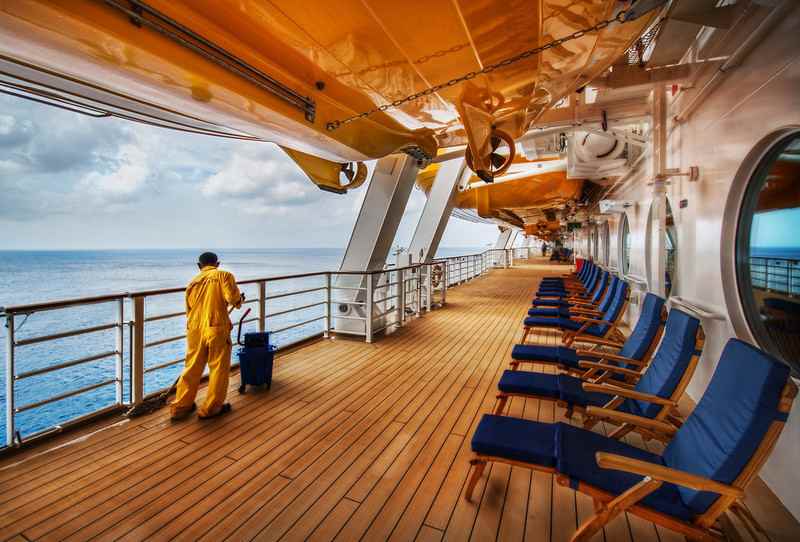
The Titanic had 9 decks. These decks included areas for first, second, and third-class passengers, each with different amenities and comfort levels. The Titanic’s decks featured extravagant facilities like a gymnasium, pools, and opulent dining rooms that catered to the elite, while the lower decks, which housed the majority of the passengers, were significantly more cramped and had fewer amenities.
In contrast, modern cruise ships usually have anywhere from 10 to 20 decks, with a standard being around 15. These decks have modern amenities that extend across all class divisions. The decks offer a wide range of amenities, such as water parks, theaters, multiple restaurants, and lounges accessible to all passengers.
Passenger capacity
The Titanic could carry up to 2,435 passengers. This number is quite low compared to the capacity of today’s cruise ships. For example, the Icon of the Seas has a passenger capacity of 7,600, while the Wonder of the Seas can accommodate 7,084 passengers. Even smaller modern ships like the Carnival Vista far surpass the Titanic with a maximum passenger capacity of 4,977.
Titanic vs. Modern Cruise Ship: Design & Aesthetics
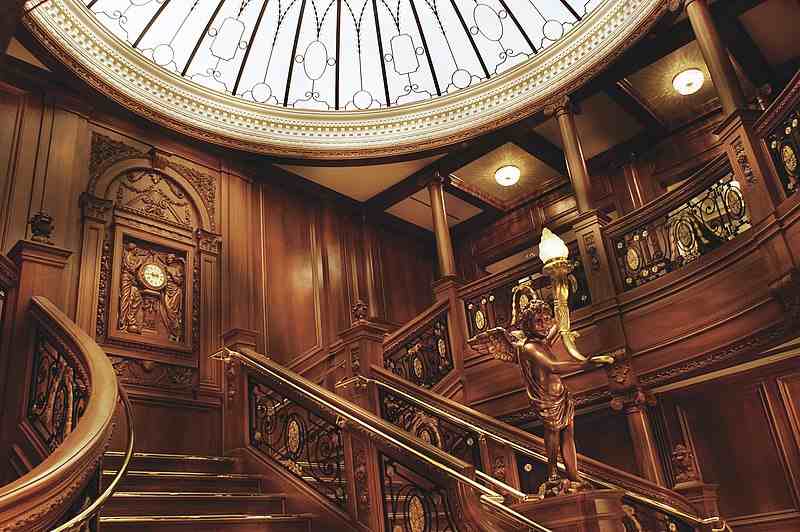
The Titanic was specifically designed to offer luxury and comfort. Its interior resembled that of a grand hotel, featuring lavish decorations, fine dining areas, and an iconic grand staircase. This design was intended to attract wealthy passengers with the elegance and opulence typical of high-end Edwardian architecture.
Modern cruise ships, on the other hand, aim to optimize space and provide a variety of amenities. The design is more focused on functional luxury, with features that accommodate thousands of passengers and include extensive entertainment options like theaters, spas, and pools.
Titanic vs. Modern Cruise Ship: Construction Materials and Techniques
Hull and compartments.
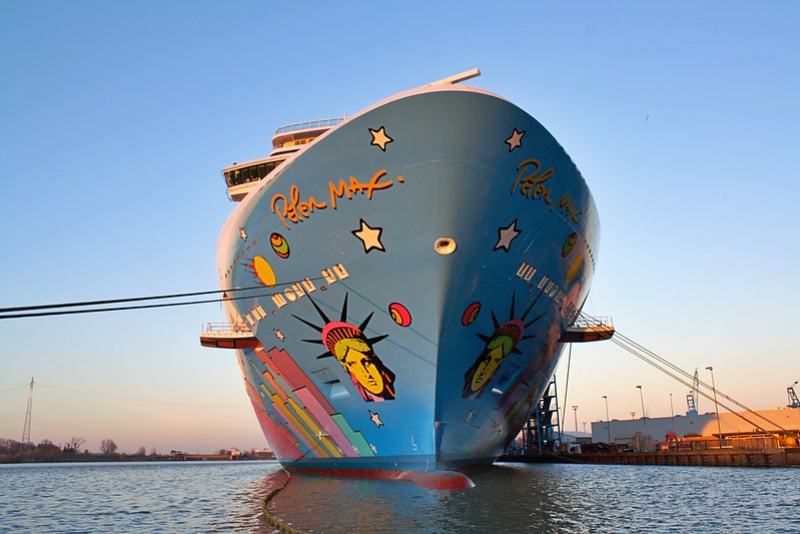
The Titanic was famously declared “unsinkable” due to its design, which included a double-bottom hull and 16 watertight compartments. The doors were designed to close manually or automatically at the water level. Despite this, the Titanic’s compartments were open at the top, which allowed water from the breached compartments to spill over into others as the ship tilted.
On the other hand, modern cruise ships are built with double-hull technology and multiple watertight compartments that extend up the side of the hull. These features provide better structural integrity and improve the ship’s ability to prevent flooding.
Welds vs. rivets
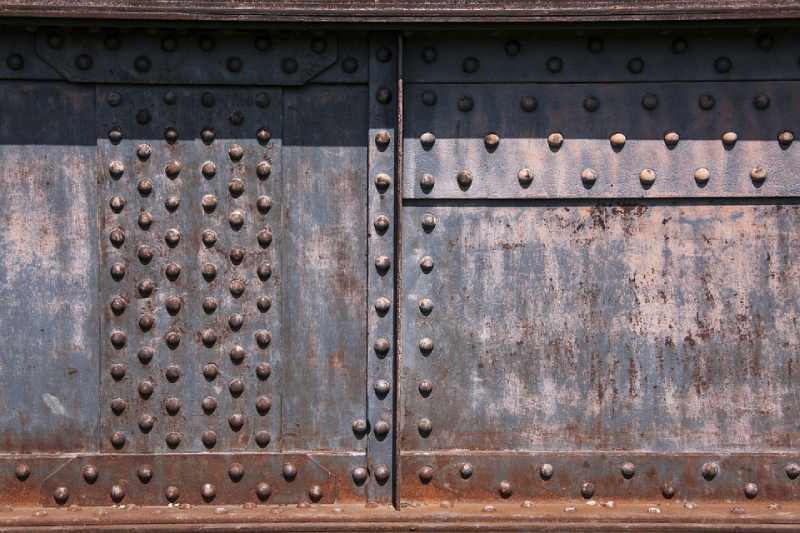
The Titanic was constructed using over three million rivets. Rivets, which are metal pins used to fasten together pieces of metal, were hammered into place all over the Titanic’s hull and upper decks. This method was not only time-consuming but also allowed for less flexibility in materials. The use of iron rivets poses a safety risk as they are more brittle and prone to snapping under extreme pressure or when they contract in cold temperatures. This brittleness contributed significantly to the catastrophic failure of the Titanic’s hull when it struck the iceberg.
Today, modern ships are constructed using welding technology rather than rivets. Welding creates a strong, seamless bond that is far more durable and long-lasting than rivets. This method involves melting the metal pieces together to form a single piece, which eliminates the weak spots that rivets can create at the joints. Additionally, welded seams are much better at withstanding extreme pressures and temperatures, greatly reducing the likelihood of structural failures similar to those experienced by the Titanic.
Titanic vs. Modern Cruise Ship: Safety Features

The Titanic, while deemed unsinkable in 1912, was equipped with safety features that were advanced for its time but are considered inadequate by today’s standards. It carried only 20 lifeboats, which could accommodate less than half of the vessel’s total number of passengers and crew. This was actually more than British law required at the time, which mandated enough lifeboats for 30% of a ship’s capacity.
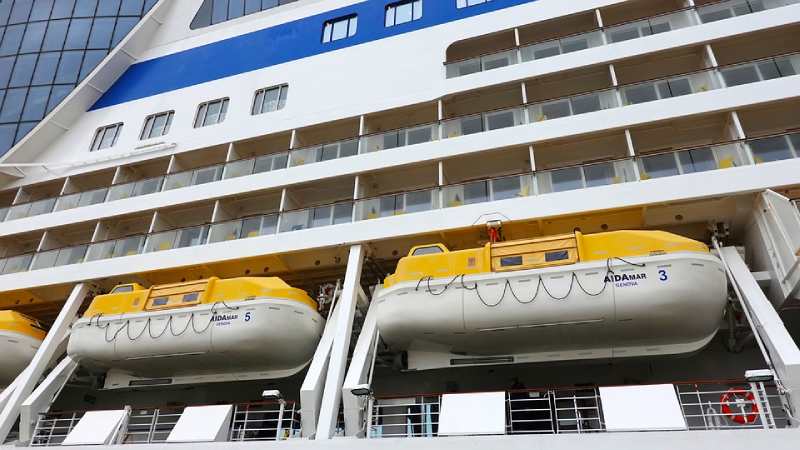
On the other hand, modern cruise ships adhere to strict international safety laws that require enough lifeboats for everyone on board. Additionally, these ships are equipped with advanced firefighting tools, water-tight compartments that can seal off a breached hull, sophisticated alarms, and sprinkler systems—all designed to handle emergencies more effectively.
Titanic vs. Modern Cruise Ship: Technology
Navigation technology.
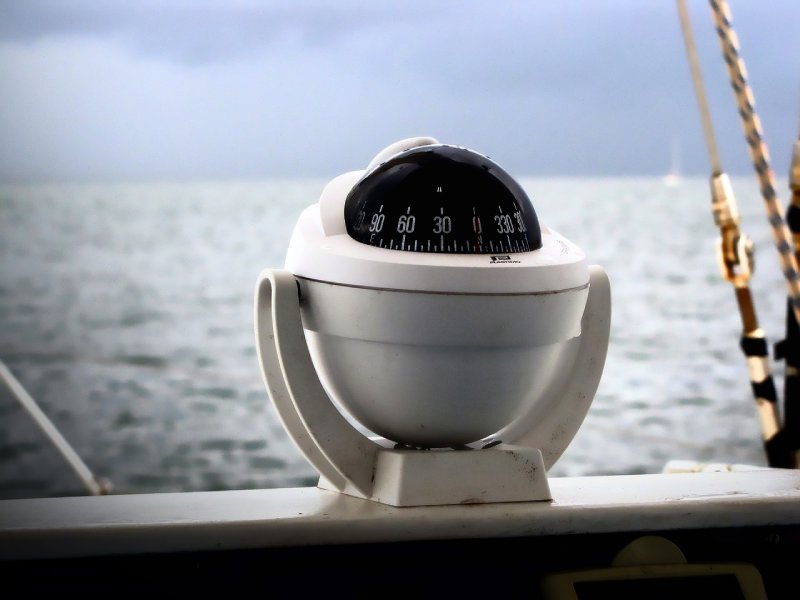
Navigation on the Titanic was heavily reliant on celestial navigation, using sextants and manual calculations based on the positions of stars and planets. This method, while effective at the time, lacked precision.
Today’s cruise ships use a combination of GPS (Global Positioning System) and other high-tech navigational aids like RADAR (Radio Detection and Ranging) and SONAR (Sound Navigation and Ranging), which allow for real-time, accurate tracking and positioning. This technology provides data on the ship’s location relative to icebergs, landmasses, and other vessels, reducing the risk of collision.
Communication technology
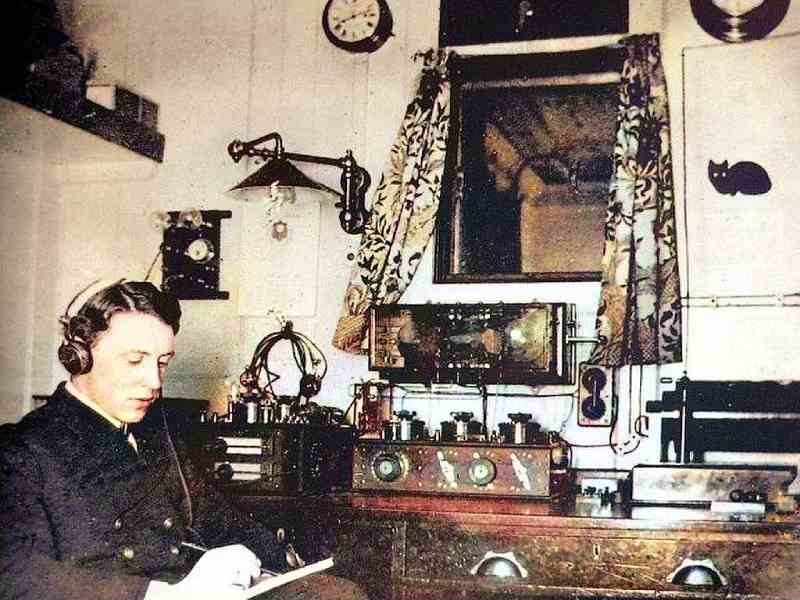
The Titanic had a wireless telegraph, which was state-of-the-art at the time and capable of sending distress signals and messages over long distances. However, the effectiveness of this system was limited by the technology of the era, which did not allow for continuous communication.
Modern cruise ships are equipped with satellite phones, Wi-Fi, and data links that enable continuous, worldwide communication. This not only improves safety by ensuring that ships are always in contact with coastal commands, weather stations, and other ships, but also improves overall management and coordination in emergency situations.
Weather forecasting and iceberg monitoring technology
In 1912, the Titanic received iceberg warnings but lacked the technology needed to accurately map their locations in real time. Modern cruise ships benefit from advanced meteorological forecasting tools that use satellite imagery and radar to provide accurate data. These systems enable ships to navigate safely through hazardous conditions by altering their course well in advance to avoid icebergs, storms, and other hazards.
Titanic vs. Modern Cruise Ship: Ticket Price

The cost of a ticket on the Titanic varied based on the class of service a passenger chose. A first class suite, the epitome of luxury aboard the Titanic, would cost a passenger about $4,350, equivalent to around $133,132 today. Those who opted for a regular first class berth would have paid significantly less, around $150, which translates to about $4,591 today.
For those traveling in second class, the experience was more modest but still comfortable, with tickets costing $60, or about $1,834 today. The most economical option was third class, which catered primarily to immigrants and lower-income passengers. A ticket in third class cost just $35, or about $1,071 today, providing basic accommodations.
The average cost of a week-long cruise on a mainstream cruise line like Royal Caribbean or Carnival depends on the type of cabin you choose. For an interior cabin, prices generally start at around $700 per person. If you prefer a room with a view, an ocean view cabin can cost about $800 to $900 per person. For those who want to enjoy their own private outdoor space, balcony cabins typically range from $1,000 to $1,200 per person. For a more luxurious experience, suites on these cruises start at around $1,500 per person and can go much higher depending on size and amenities.
Titanic vs. Modern Cruise Ship: Passenger Experience
Cabin facilities.
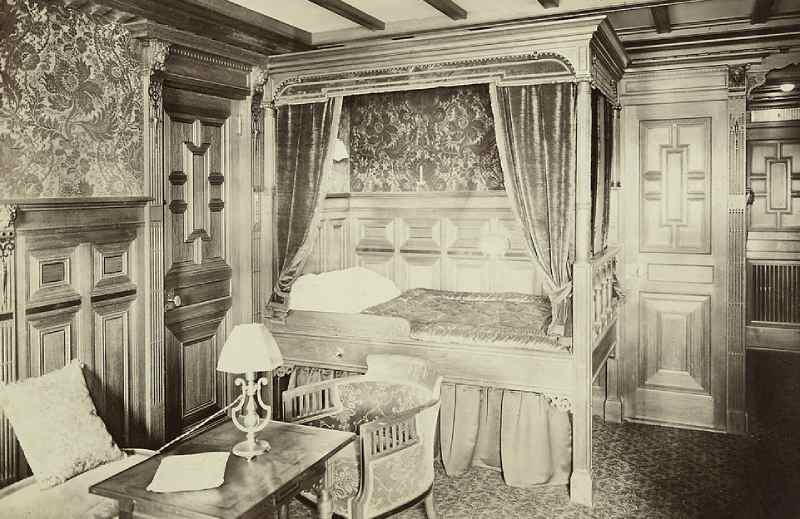
The cabin facilities on the Titanic varied significantly across its class system. First-class passengers enjoyed spacious, beautifully decorated rooms with fine furnishings that resembled luxury hotel rooms. Second-class cabins, while less opulent than those in first-class, still offered a good level of comfort with features such as oak paneling and private washbasins. In contrast, third-class accommodations were smaller, consisting primarily of bunk beds in small, cramped rooms without the luxurious amenities found in first-class.

In contrast, cruise ships are designed for leisure rather than transportation, so all types of cabins on modern cruise ships are relatively comfortable. Interior cabins are the most affordable option, located in the ship’s interior without windows, providing a cozy but compact space. Ocean view cabins feature a window or porthole with a view of the sea, giving a sense of space and connection to the outside. Cabins with balconies add a private outdoor area where passengers can enjoy fresh sea air and private views. At the top end, suites offer more space with separate living areas, luxurious amenities, and often enhanced services like priority boarding and concierge service.
Dining options
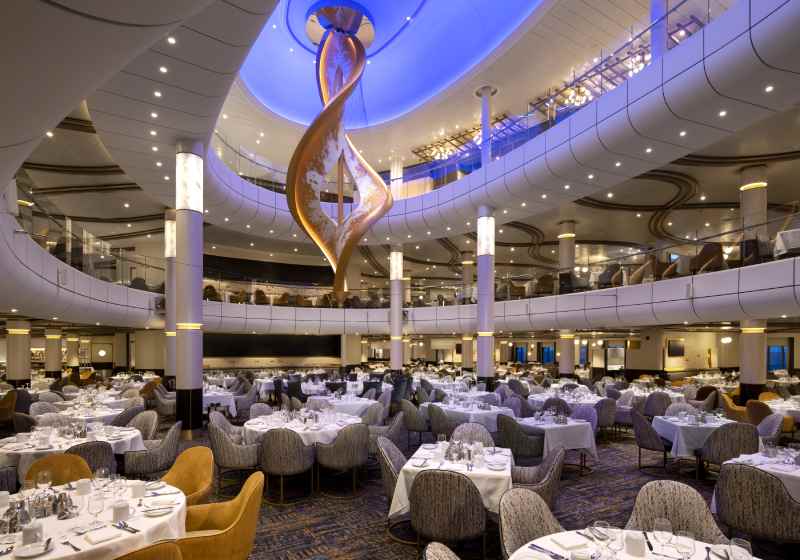
Dining aboard the Titanic was a reflection of social standing: first-class passengers dined in magnificence with menus featuring gourmet options such as filet mignon and lobster. Second-class guests enjoyed good quality meals that included roasted meats and baked fish, while third-class passengers had basic, hearty meals like stew and porridge.
Contrasting this, modern cruise ships offer various dining experiences that do not depend on passenger class. Guests can choose from many dining options, including buffet-style dining, specialty restaurants (Italian, Mexican, Asian cuisines, etc.), and even 24-hour eateries. For example, you could enjoy spaghetti carbonara at an Italian restaurant, sushi at an Asian bistro, or a late-night burger at a diner.
Entertainment and recreation
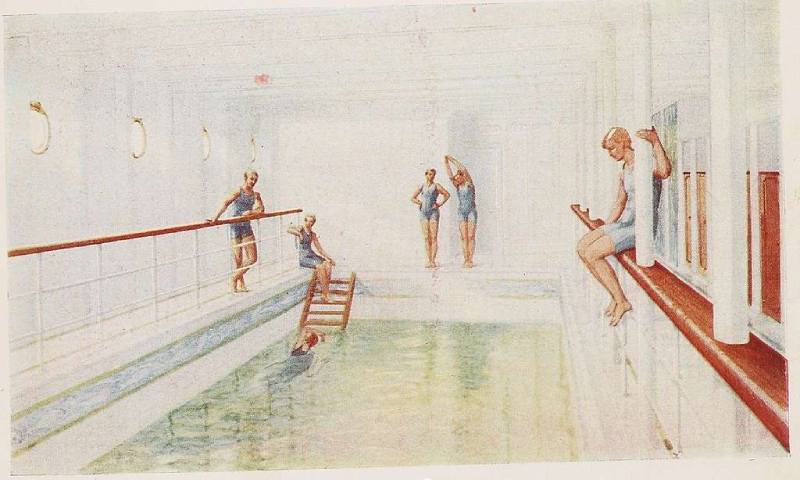
On the Titanic, first-class passengers enjoyed luxurious amenities, including a gymnasium, a heated swimming pool, a Turkish bath, a squash court, and a lavish library. Those in second class had access to comfortable lounges, a library, and spacious dining rooms, where they could enjoy good meals and participate in games or musical programs. Third-class passengers, though more limited in options, still found enjoyment in their designated smoking and common rooms where they could socialize and play games.
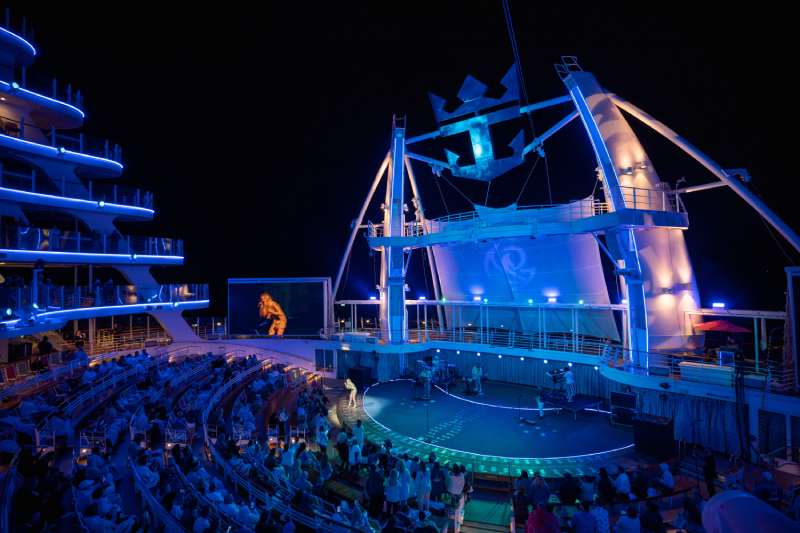
Today, the entertainment options on cruise ships are extensive and much more diverse. Passengers can enjoy Broadway-style shows, live music concerts, film screenings, an ice-skating rink, water slides, and even simulated surfing. Recreational facilities like rock climbing walls, mini-golf courses, and laser tag offer fun for all ages, ensuring that entertainment is a high point of the cruise experience.
Titanic vs. Modern Cruise Ship: Speed

When it comes to speed, the Titanic was a relatively fast ocean liner for its time. It had a maximum speed of 23-24 knots (26 mph/42 kph). This made it one of the faster ships of the early 20th century. Speed was an important factor for transatlantic liners like the Titanic, which aimed to reduce travel time between Europe and North America.
In contrast, modern cruise ships, while built for luxury and comfort, also have impressive speeds but prioritize a balance of efficiency and passenger experience over just speed. For instance, the Wonder of the Seas and the Icon of the Seas, two of the largest cruise ships currently in service, have top speeds of about 22 knots (25 mph/41 kph). These speeds, slightly lower than the Titanic’s, are standard for today’s cruise ships. However, some modern ships, such as the Norwegian Gem and Harmony of the Seas, still outpace the Titanic, reaching speeds up to 25 knots (29 mph/46 kph).
Titanic vs. Modern Cruise Ship: Environmental Impact
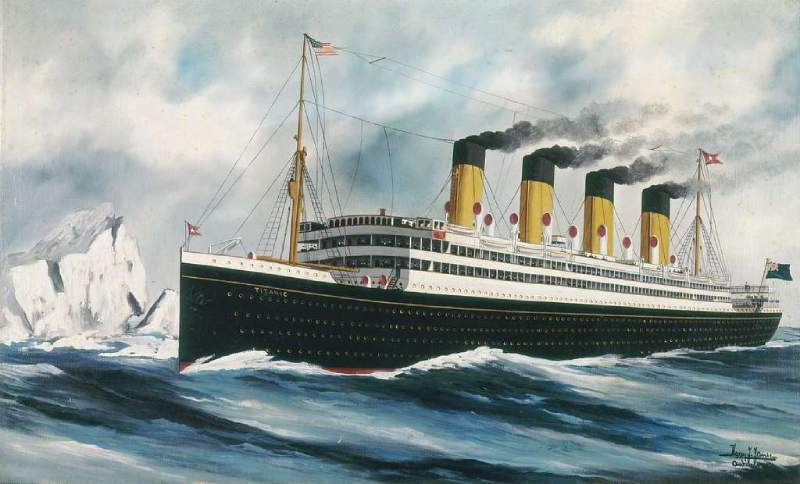
The Titanic had a high environmental impact, primarily due to its reliance on coal power. Coal-fired steam engines powered the massive vessel, releasing large amounts of soot into the atmosphere. Additionally, the inefficient combustion process and the lack of modern pollution controls meant that it also emitted a variety of pollutants, including sulfur compounds and ash.
Today’s cruise ships are primarily powered by diesel engines and, in some cases, by liquefied natural gas (LNG), which burns cleaner than coal. They are equipped with advanced emission control technologies, such as scrubbers and catalytic converters, to reduce pollution.
Final Words
Modern cruise ships have come a long way since the Titanic, with improvements in size, technology, and safety features that are truly remarkable. While the Titanic was impressive for its time, today’s cruise ships surpass it in size, capacity, and technological sophistication.
Modern cruise ships are equipped with state-of-the-art navigation systems, multiple safety measures such as lifeboats for all passengers, and luxurious facilities that cater to every need and comfort of the modern traveler. The evolution from the Titanic to current cruise ships not only reflects a century of innovation but also the transition from ocean liners focused on transportation to cruise ships designed for luxury and safety.
Titanic vs. Modern Cruise Ship – FAQ
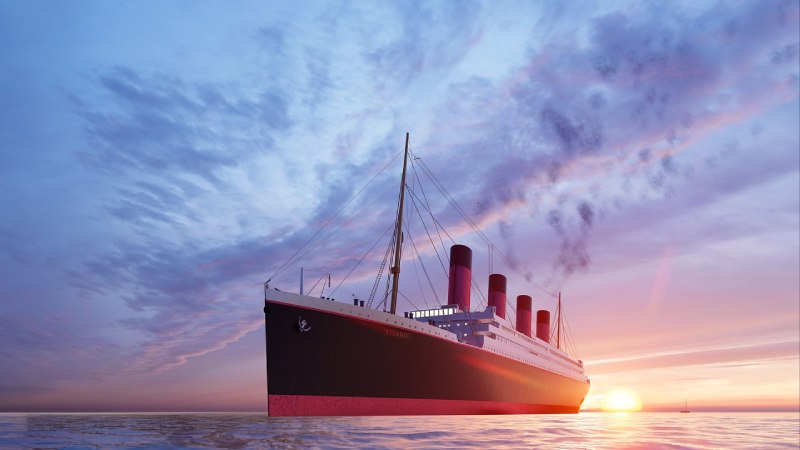
Are ships now safer than the Titanic?
Yes, ships today are much safer than the Titanic. Since the Titanic sank in 1912, there have been many advancements in ship design, safety regulations, and navigation technologies. Modern ships are built with better materials and have advanced safety features like improved lifeboats, better construction, and fire safety systems.
How many cruise ships have sunk since the Titanic?
Since the Titanic tragically sank over a century ago, more than 20 cruise ships and ocean liners have also sunk. Just like the Titanic, these ships faced various challenges and unfortunate circumstances that led to their sinking. However, it’s with today’s advanced technology and safety protocols, incidents of ships sinking are quite rare.
What cruise ship is 5 times bigger than the Titanic?
The cruise ship that is about five times bigger than the Titanic is the Icon of the Seas. With a gross tonnage (GRT) of approximately 248,663, the Icon of the Seas far surpasses the Titanic’s GRT of 46,329. This makes the Icon of the Seas around 5.3 times larger than the Titanic. As of 2024, the Icon of the Seas is the largest cruise ship in the world.
Has a modern cruise ship ever sunk?
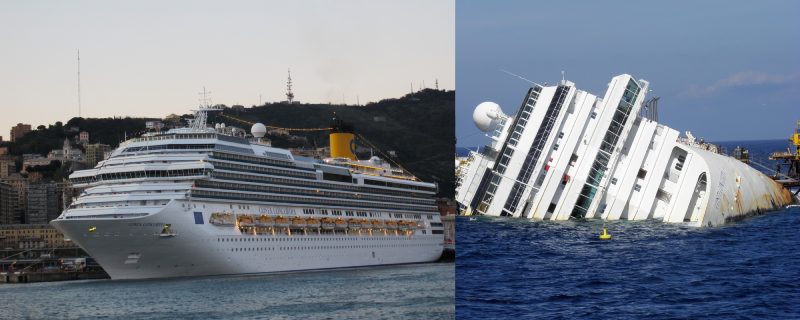
Yes, modern cruise ships have sunk , but it is a rare occurrence. One notable example is the Costa Concordia, which capsized off the coast of Italy in 2012 after hitting an underwater rock. This incident caused the deaths of 32 people. Another example is the MV Bulgaria, a Russian cruise ship that sank in the Volga River in 2011 due to overcrowding and poor maintenance, killing 122 people.
Despite these tragic incidents, cruising remains a relatively safe form of travel, especially when compared to historical standards. Modern ships are equipped with advanced safety features and navigation systems that significantly reduce the likelihood of such disasters.
What is the worlds largest cruise ship?
As of 2024, the Icon of the Seas holds the title of the world’s largest cruise ship. It stretches a massive 1,196 ft (364 m) in length and stands at 196 ft. (60 m) tall. It has a gross tonnage of 248,663 and a passenger capacity of 7,600. The ship embarked on its maiden voyage on January 27, 2024 from PortMiami.
Could a cruise ship hit an iceberg today?
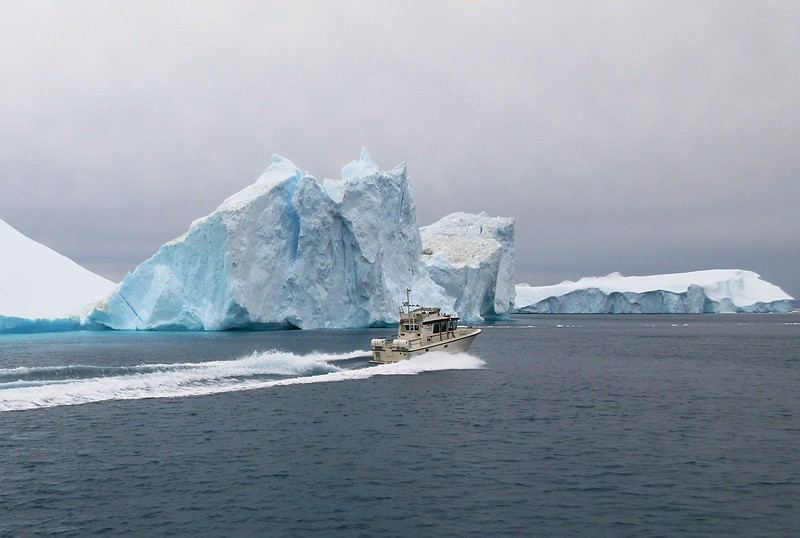
Yes, a cruise ship could still potentially hit an iceberg today, especially if it navigates through icy waters near the poles or along routes like the North Atlantic, where icebergs are commonly found.
However, the likelihood of a modern cruise ship sinking due to an iceberg collision is extremely low. Today’s ships are equipped with advanced radar and sonar systems that help detect icebergs from a great distance, giving them plenty of time to navigate safely. Additionally, cruise ships are built with stronger, more resilient hulls compared to what was available a century ago during the Titanic era.
Modern ships also benefit from sophisticated weather forecasting and GPS navigation, which help avoid dangerous conditions. Additionally, strict international regulations now require thorough safety checks and drills. All these improvements have made sea travel considerably safer than it was during the time of the Titanic.
Adam Stewart
Adam Stewart is the founder of Cruise Galore. He is a passionate traveler who loves cruising. Adam's goal is to enhance your cruising adventures with practical tips and insightful advice, making each of your journeys unforgettable.
Leave a Reply Cancel Reply
Your email address will not be published. Required fields are marked *
Name *
Email *
Add Comment *
Save my name, email, and website in this browser for the next time I comment.
Post Comment

Today’s Cruise Ship Compared to Titanic: An In-depth Review
Posted on Last updated: February 9, 2024
Embark on a journey through maritime history as we delve into an intricate comparison between the legendary Titanic and today’s modern cruise ships.

Comparative Analysis
Direct comparison of key aspects: size, safety, amenities, technology.
- Titanic: Approximately 882 feet in length and 46,328 gross tonnage.
- Modern Cruise Ships: Often exceed 1,000 feet with some over 200,000 gross tonnage.
- Titanic: Limited lifeboats, relying on visual spotting for navigation, lacked modern communication tools.
- Modern Cruise Ships: Sufficient lifeboat capacity for all, advanced navigation systems like GPS and radar, comprehensive safety drills and protocols.
- Titanic: Luxury focused on first-class passengers, with limited amenities for lower classes.
- Modern Cruise Ships: Wide range of amenities accessible to all passengers, including diverse dining options, entertainment, and recreational activities.
- Titanic: Advanced for its time with features like watertight compartments and wireless telegraph.
- Modern Cruise Ships: State-of-the-art navigation systems, sophisticated safety features, and environmentally friendly technologies.

Lessons Learned from the Titanic and Their Application in Modern Ship Design
The Titanic tragedy brought about crucial lessons that have been integral in shaping modern maritime safety and design:
- Life-Saving Equipment : The importance of sufficient life-saving equipment, leading to regulations ensuring enough lifeboats and safety equipment for everyone on board.
- Safety Protocols: The need for regular safety drills and stringent safety protocols to prepare both crew and passengers for emergencies.
- Design and Construction: Advancements in ship design for improved safety and stability, such as double-hulled bottoms and improved compartmentalization.
- Navigation and Communication: The evolution of navigation and communication technology to prevent collisions and improve response times in emergencies.

Historical Context
The era of the titanic: technological and social milieu of the early 20th century.
The RMS Titanic , often heralded as the “unsinkable” ship, was a product of the early 20th century, a period rife with industrial advancements and social stratification.
Launched in 1912, the Titanic was not just a feat of engineering; it was a symbol of the era’s technological ambition and luxury. This period was marked by a surge in industrialization, which brought about significant advancements in transportation, including shipbuilding.
The Titanic represented the pinnacle of this progress, boasting the most advanced maritime technology of its time.
Simultaneously, the social structure aboard the Titanic mirrored the class divisions prevalent in the early 1900s. The ship was a microcosm of society, with luxurious accommodations for the wealthy and modest third-class quarters for immigrants and lower-income passengers.
This distinction was not just in amenities but also in the access to safety measures, a point tragically underscored by the disaster that ensued.

Evolution of Cruise Ships: From the Titanic to the Present Day
The evolution of cruise ships since the Titanic has been marked by exponential growth in size, luxury, and technological sophistication.
Modern cruise ships are floating cities, equipped with state-of-the-art facilities, advanced navigation systems, and comprehensive safety protocols. This transformation can be attributed to several factors:
- Technological Advancements: The progression in maritime technology has been monumental. Today’s ships are powered by cutting-edge propulsion systems, have sophisticated navigation aids, and utilize innovative materials for enhanced safety and efficiency.
- Changing Social Dynamics: Unlike the rigid class system of the Titanic era, modern cruise ships cater to a more diverse demographic. They emphasize inclusivity, with amenities and activities designed for a wide range of ages, interests, and budgets.
- Shift in Purpose: The Titanic was primarily a transatlantic liner, transporting passengers from point A to B. Modern cruise ships, however, are more about the journey than the destination. They offer a holistic travel experience with a focus on leisure, entertainment, and exploration.
- Safety Regulations: The Titanic disaster led to significant changes in maritime safety regulations. Modern cruise ships are built with stringent safety standards, including enough lifeboats for all passengers, advanced fire protection systems, and rigorous safety drills.

Design and Construction
Titanic: design features, construction details, and technological innovations.
The RMS Titanic, constructed by Harland and Wolff in Belfast, was an epitome of early 20th-century engineering. It was the largest ship afloat at its time, measuring approximately 882 feet in length and 92 feet in breadth.
The design of the Titanic was a blend of luxury and practicality, featuring opulent staterooms, grand staircases, and an array of dining rooms and social areas.
Technologically, it was equipped with advanced features for its time, such as a double-bottomed hull and watertight compartments, intended to enhance its survivability in the event of a hull breach.
Despite these innovations, the design also had its flaws. The watertight compartments did not extend high enough, and the ship lacked an adequate number of lifeboats, a decision driven by aesthetic and regulatory standards of the time.

Modern Cruise Ships: Advances in Shipbuilding and Design Since the Titanic
Contemporary cruise ships are marvels of modern engineering, dwarfing the Titanic in size and capability.
They typically exceed 1,000 feet in length, with some able to accommodate over 6,000 passengers. Modern design prioritizes not just safety and efficiency but also environmental sustainability. Features often include:
- Advanced Hull Designs: Today’s ships boast hulls designed for greater stability and fuel efficiency.
- Sophisticated Safety Systems: Modern ships are equipped with advanced fire suppression systems, redundant power systems, and state-of-the-art navigation technology.
- Eco-friendly Technologies: Many cruise ships now incorporate systems for energy efficiency, waste reduction, and minimizing ecological footprints, like scrubbers for exhaust cleaning and solar panels.
Additionally, the aesthetic and functional aspects of cruise ships have evolved. They feature expansive atriums, multiple dining venues, entertainment complexes, and a variety of onboard activities, offering a comprehensive vacation experience.
The contrast in design and construction between the Titanic and modern cruise ships reflects over a century of maritime innovation and shifting priorities.
Where the Titanic was a symbol of luxury and technological might of its era, modern cruise ships represent a holistic approach to maritime travel, balancing luxury, safety, and sustainability.

Size and Capacity
Comparing the size: length, width, and tonnage.
The RMS Titanic, at the time of its launch, was one of the largest man-made moving objects on Earth. It measured approximately 882 feet in length, 92 feet in breadth, and had a gross tonnage of about 46,328 tons. This massive size was a source of public fascination and symbolized the technological advancements of the era.
In contrast, modern cruise ships have significantly surpassed these dimensions. Some of the largest cruise ships today measure over 1,200 feet in length and have a gross tonnage exceeding 200,000 tons. This increase in size reflects advancements in engineering and a growing demand for more expansive onboard facilities.
Passenger and Crew Capacity: Then and Now
The Titanic could accommodate up to 2,435 passengers and a crew of about 900, totaling around 3,335 people. The ship’s accommodations were divided into three classes, reflecting the social stratifications of the time. Each class had its own dining and social areas, with the first-class passengers enjoying the most luxurious settings.
Modern cruise ships, owing to their larger size , can accommodate a much higher number of passengers and crew. Some of the largest cruise ships can carry more than 6,000 passengers and a crew of over 2,000.
This significant increase in capacity has been facilitated by advanced design and better utilization of space. Unlike the Titanic, modern ships offer a more egalitarian approach to accommodation, with a wide range of options catering to different preferences and budgets.
This comparison in size and capacity highlights not just the technological progress in shipbuilding but also a shift in the concept of sea travel. While the Titanic was a symbol of opulence and a showcase of engineering, modern cruise ships emphasize providing a comprehensive and inclusive vacation experience to a broader audience.

Luxury and Amenities
Titanic’s luxury features: accommodations, dining, and entertainment.
The RMS Titanic set new standards for luxury at sea. Its first-class accommodations were akin to a floating five-star hotel, featuring opulent cabins, lavish dining rooms, and elegant social spaces.
First-class passengers enjoyed gourmet dining, a grand staircase, a swimming pool, a gymnasium, and even a Turkish bath. The second and third-class accommodations, while less luxurious, were still above the standards of other ships at the time.
Modern Cruise Ship Amenities: How They Have Expanded and Evolved
Modern cruise ships have taken the concept of luxury to a new level, offering amenities that rival the best resorts. These include:
- Diverse Dining Options: From buffet-style to fine dining restaurants, modern ships offer a range of culinary experiences, often including options by celebrity chefs.
- Entertainment and Recreation: State-of-the-art theaters, aqua parks, rock climbing walls, ice skating rinks, and even virtual reality experiences are common.
- Wellness and Relaxation: Spas, multiple swimming pools, hot tubs, and fitness centers are standard on most ships.
- Accommodation Variety: A wide range of cabins, from budget-friendly interior rooms to luxurious suites with private balconies and butler service.
Modern cruise ships are designed to cater to a wide range of preferences and ages, offering something for everyone, a concept that was largely absent in the Titanic’s era.
Comparative Analysis: Then and Now
The contrast in amenities between the Titanic and modern cruise ships illustrates a significant shift in maritime travel. Where the Titanic was a symbol of luxury for the few, modern cruise ships are floating cities designed to provide an all-inclusive vacation experience.
The focus has shifted from merely transporting passengers from one place to another to offering a rich, immersive experience with a plethora of activities and amenities.
This evolution reflects broader changes in society and travel preferences over the past century. While the Titanic was a showcase of early 20th-century opulence and social stratification, modern cruise ships are a testament to technological advancement, inclusivity, and the democratization of luxury travel.

Safety Features and Protocols
Safety measures on the titanic: what was available and what was lacking.
The Titanic, despite being touted as “unsinkable,” had several safety shortcomings that contributed to the magnitude of the disaster. It was equipped with watertight compartments and remotely activated watertight doors, which were advanced features for its time.
However, these measures were insufficient. Notably, the ship carried only 20 lifeboats, enough for about half of the passengers and crew, based on outdated maritime safety regulations. This lack of adequate lifeboat capacity, coupled with a lack of rigorous safety drills and procedures, had dire consequences.
Advances in Maritime Safety: Modern Safety Features and Protocols
Since the Titanic tragedy, maritime safety standards have undergone a complete overhaul. Modern cruise ships are now equipped with comprehensive safety systems and protocols, including:
- Sufficient Lifeboat Capacity: Ships are required to have enough lifeboats for all passengers and crew, with regular maintenance and safety drills.
- Advanced Navigation Systems: Modern technology, like radar and GPS, helps in avoiding hazards and ensures safer navigation.
- Improved Ship Design and Stability: Enhanced hull design and stabilizers improve ship stability and safety in rough seas.
- Stringent Safety Regulations: Regular inspections, adherence to international safety standards, and crew training in emergency procedures are mandatory.
- Emergency Communication and Medical Facilities: Ships are equipped with advanced communication systems for emergencies and have onboard medical facilities staffed by professionals.
These advancements reflect a significant shift in the approach to maritime safety, moving from reactive measures to proactive, comprehensive safety planning and implementation.
The comparison in safety features and protocols between the Titanic and modern cruise ships is stark. While the Titanic’s safety measures were based on the standards of its time, they were insufficient for the scale of the disaster that occurred. Modern cruise ships, on the other hand, are built with safety as a paramount concern, incorporating lessons learned from past tragedies like the Titanic.
This evolution in safety standards is not only a technical advancement but also a cultural shift in the maritime industry. The emphasis is now on preventing disasters, ensuring the safety and wellbeing of every passenger and crew member on board.

Navigation and Technology
Navigational tools and techniques on the titanic.
The Titanic, for its time, was equipped with the best available navigational tools, but these were primitive by today’s standards. Navigation was mainly based on celestial navigation, using sextants to measure the angle between specific stars and the horizon.
The ship also had a wireless telegraph, which was a cutting-edge technology at the time. This system was used for communicating with other ships and shore stations, but it was not primarily intended for emergency use.
However, the lack of radar and other modern navigation aids meant that the Titanic’s crew had limited ability to detect icebergs or other hazards directly in their path.
Contemporary Navigational Technology and Its Advancements
Modern cruise ships are equipped with an array of advanced navigational tools that greatly enhance safety and efficiency. These include:
- Global Positioning System (GPS): Provides precise location data, crucial for navigation and for emergency situations.
- Radar Systems: Allow for the detection of obstacles, including other vessels and natural hazards, at great distances and in poor visibility conditions.
- Automated Identification Systems (AIS): Enable ships to exchange a variety of information, including identification, position, course, and speed, with other nearby ships and coastal authorities.
- Sonar Technology: Used for underwater detection, helping to navigate safely in shallow waters.
- Integrated Bridge Systems: Combine all navigational information onto one or more displays, allowing for more efficient monitoring and decision-making.
The comparison in navigational technology between the Titanic and modern cruise ships underscores the dramatic advancements in maritime navigation.
While the Titanic relied on manual navigation techniques and visual observations, modern ships utilize a suite of electronic tools that provide comprehensive data and automated systems for navigation and safety.
These advancements not only make modern cruising safer but also more efficient and reliable. They represent a shift from the reliance on human skill and judgement to a more technology-driven approach, where human expertise is supported and enhanced by sophisticated equipment.

Voyages and Destinations
Titanic’s intended route and popular routes of that era.
The Titanic’s maiden voyage was a transatlantic crossing, a popular route in the early 20th century. It was intended to travel from Southampton to New York City, with stops in Cherbourg, France, and Queenstown (now Cobh), Ireland.
Transatlantic crossings were the primary mode of long-distance international travel at the time, serving not just the wealthy but also immigrants seeking new lives in America.
These routes were less about leisure and more about transportation, reflecting the limited means of global travel available during that period.
Popular Routes and Destinations of Modern Cruise Ships
Today, cruise ships offer a vast array of routes that span the globe, catering to leisure and exploration rather than mere transportation. Some of the popular modern cruise destinations and routes include:
- Caribbean Cruises: Known for their beautiful beaches, clear waters, and vibrant cultures.
- Mediterranean Cruises: Offering a mix of history, culture, and scenic beauty, with stops at various European ports.
- Alaskan Cruises: Providing breathtaking views of glaciers, wildlife, and rugged landscapes.
- Asian Cruises: Exploring diverse cultures, cuisines, and historical sites across different Asian countries.
- World Cruises: These are longer voyages that circumnavigate the globe, allowing passengers to experience a multitude of countries and cultures.
Additionally, themed cruises and expedition cruises have become popular, focusing on specific interests like wildlife, gastronomy, or adventure activities.
The contrast in voyages and destinations between the Titanic and modern cruise ships highlights a fundamental shift in the purpose of sea travel.
The Titanic’s journey was representative of the primary role of ocean liners in the early 20th century, which was to transport passengers across the Atlantic. Modern cruise ships, in contrast, are designed for leisure, offering diverse experiences that combine relaxation, adventure, and cultural exploration.
This evolution reflects changes in societal leisure patterns, advancements in shipbuilding, and the globalization of travel. Modern cruising allows passengers to explore multiple destinations in comfort and style, a concept that was largely unimaginable in the era of the Titanic.

The Titanic Tragedy: Causes and Consequences
Analysis of the titanic disaster: iceberg collision and other contributing factors.
The sinking of the Titanic on April 15, 1912, remains one of the most infamous maritime disasters in history. The ship collided with an iceberg during its maiden voyage, leading to the loss of over 1,500 lives. Key factors contributing to the tragedy included:
- Inadequate Safety Measures: The Titanic did not have enough lifeboats for all passengers and crew, a consequence of outdated safety regulations and design choices prioritizing aesthetics.
- Iceberg Detection and Response: The lack of radar technology meant reliance on visual spotting, which was hampered by the lack of binoculars and the calm, moonless night.
- Material and Design Flaws: Investigations revealed that the steel used in the ship’s hull and the design of the rivets might have been vulnerable at freezing temperatures, contributing to the severity of the damage from the iceberg collision.
- Speed and Course Decisions: The Titanic was traveling near its full speed despite ice warnings, and the maneuver taken to avoid the iceberg might have worsened the impact.
Impact of the Titanic Disaster on Maritime Laws and Ship Design
The Titanic disaster had a profound and lasting impact on maritime safety regulations and ship design:
- Lifeboat Requirements: One of the most immediate changes was the requirement for ships to carry enough lifeboats for all passengers and crew.
- International Ice Patrol: Established to monitor iceberg dangers in the North Atlantic, reducing the risk of similar accidents.
- International Convention for the Safety of Life at Sea (SOLAS): Formulated in 1914, this set of maritime safety standards has been regularly updated to incorporate the latest safety technologies and practices.
- Advancements in Ship Design: The tragedy led to improvements in hull design, watertight compartments, and emergency protocols.
The Titanic’s sinking was a catalyst for sweeping changes in maritime safety, emphasizing the need for comprehensive regulations, proactive safety measures, and technological advancements.
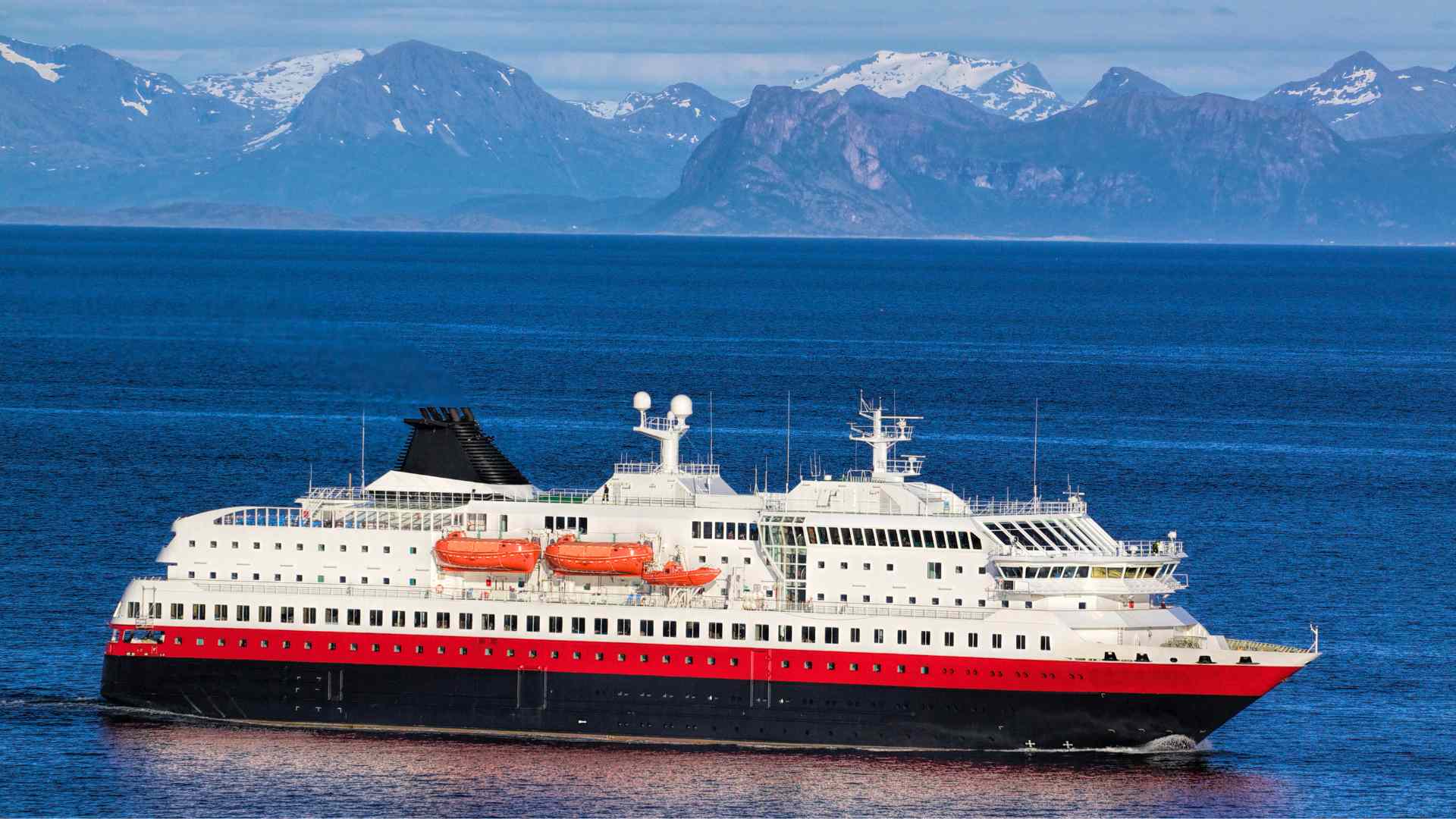
Cultural Impact
The titanic in popular culture: films, books, and memorials.
The Titanic has captivated public imagination like few other events in history. Its story has been retold across various media, reflecting the enduring fascination with the tragedy.
- Films: The most notable is James Cameron’s 1997 film “Titanic,” which became a cultural phenomenon, blending historical detail with a fictional love story. Other films have also depicted the event, each offering a unique perspective on the disaster.
- Books: Numerous books, both fiction and non-fiction, have explored the Titanic’s story, examining everything from the passengers’ experiences to the technical aspects of the ship.
- Memorials: Memorials for the Titanic are found around the world, with notable ones in Belfast, Southampton, and Halifax. These memorials pay homage to the lives lost and the impact of the tragedy.
Modern Cruise Ships in the Media and Public Imagination
Modern cruise ships, while often featured in media, evoke a different cultural response. They are symbols of leisure, luxury, and the accessibility of global travel. The cultural representation of these ships is often tied to:
- Travel and Lifestyle Media: Showcasing the luxurious amenities, exotic destinations, and the appeal of a cruise vacation.
- News Stories: Occasionally, cruise ships make headlines due to events like technological innovations, record-breaking sizes, or, less frequently, incidents at sea.
- Environmental Discourse: There is growing public and media attention on the environmental impact of cruise ships, leading to discussions about sustainable travel.
The Titanic’s cultural legacy is largely defined by its dramatic story and tragic end, symbolizing human ambition and its limitations. It represents a historical moment frozen in time, often viewed through a lens of nostalgia and tragedy.
In contrast, modern cruise ships are seen as symbols of present-day technological achievement and the democratization of luxury travel. They represent the ongoing evolution of maritime travel, highlighting advancements in safety, comfort, and global connectivity.
This contrast in cultural impact underscores how maritime disasters like the Titanic have shaped perceptions of sea travel, and how modern cruise ships have redefined these perceptions by offering safe, luxurious, and accessible vacation experiences.
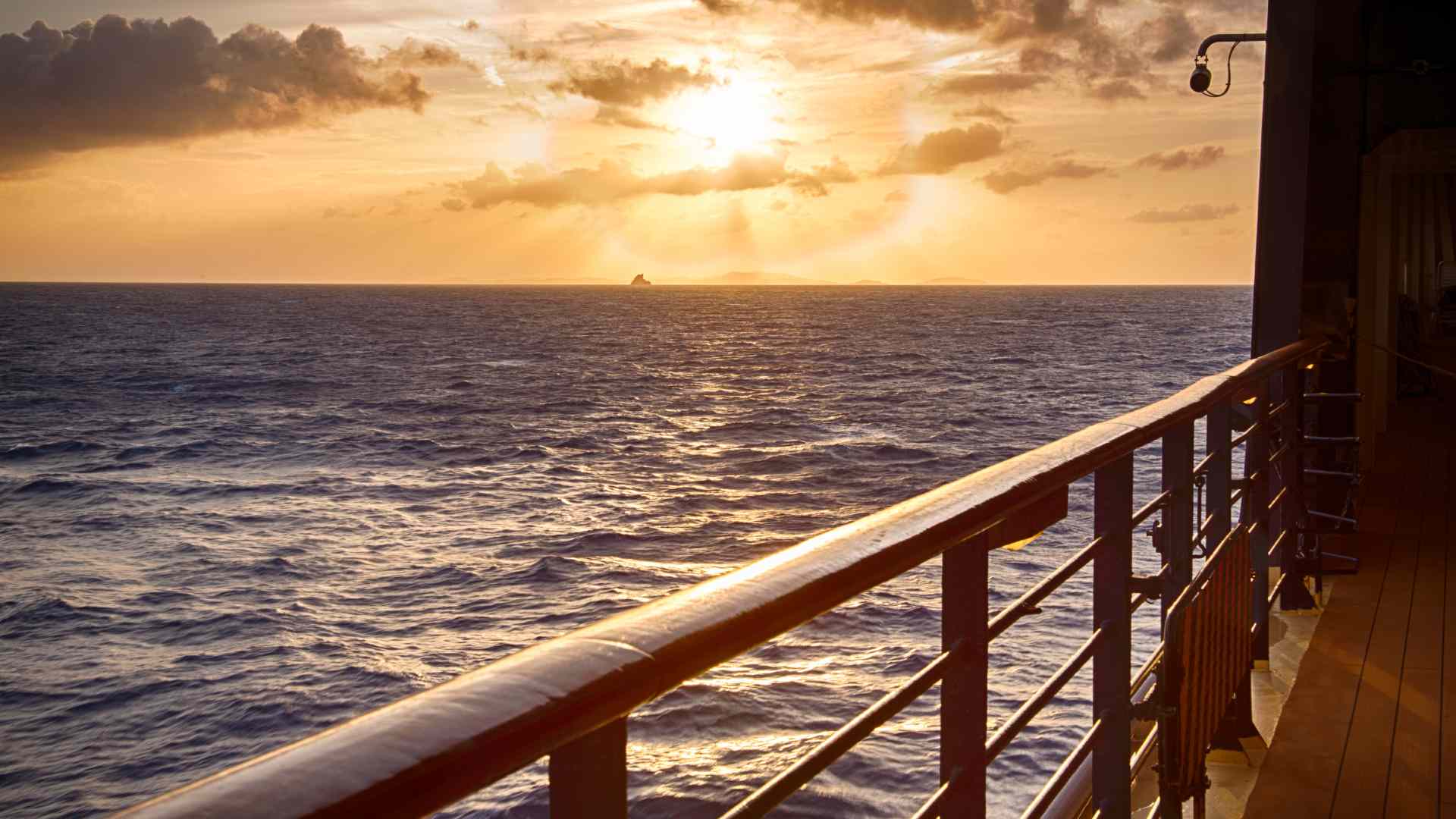
Environmental Considerations
Environmental impact of the titanic and early 20th-century ships.
The Titanic, like other ocean liners of its time, was powered by coal-fired steam engines, which had a significant environmental footprint. The burning of coal not only emitted large amounts of greenhouse gases but also resulted in the release of other pollutants.
However, environmental concerns in the early 20th century were not as prominent in public discourse or ship design as they are today. The impact of maritime travel on the environment was largely an unconsidered aspect.
Environmental Challenges and Solutions for Modern Cruise Ships
Modern cruise ships face various environmental challenges, primarily due to their size and the number of people they accommodate. These challenges include:
- Emissions: Cruise ships traditionally run on heavy fuel oil, which produces high levels of sulfur dioxide, nitrogen oxides, and greenhouse gases.
- Waste Management: The disposal of waste, including sewage, food, and plastic, is a significant concern, given the large volumes produced.
- Marine Life Impact: Ship operations can disturb marine ecosystems through noise, waste, and physical presence.
However, the cruise industry has been taking steps to mitigate these impacts:
- Cleaner Fuels and Propulsion: Adoption of liquefied natural gas (LNG) and hybrid systems to reduce emissions.
- Advanced Waste Treatment: Implementing sophisticated waste management systems to minimize pollution and promote recycling.
- Energy Efficiency: Utilizing technologies like LED lighting, energy-efficient appliances, and solar panels to reduce energy consumption.
- Environmental Regulations Compliance: Adhering to international regulations like the International Maritime Organization (IMO) standards.
The Titanic’s era did not significantly account for the environmental impact of maritime travel, reflecting the industrial mindset of the time. In contrast, modern cruise ships operate in an era increasingly aware of environmental issues. This awareness has driven significant changes in ship design, fuel use, and waste management practices.
While the cruise industry still faces challenges in becoming truly sustainable, the shift towards environmentally conscious practices marks a significant change from the early days of ocean liners.
This evolution reflects a broader societal shift towards recognizing and addressing the environmental impacts of human activities, including leisure travel.

Economic Aspects
The economics of operating the titanic: costs, revenues, and business model.
The construction and operation of the Titanic were a major financial undertaking at the time. Built for an estimated $7.5 million (equivalent to around $200 million today), the Titanic represented a significant investment for its owners, the White Star Line.
The business model was based on the prestige of the ship and its appeal to wealthy passengers, with the first-class tickets priced to reflect this exclusivity. Additionally, the ship catered to immigrants and travelers of lower economic classes, who provided a steady source of revenue despite the lower ticket prices.
The financial success of the Titanic and its sister ships was predicated on their ability to consistently carry full passenger loads across the Atlantic.
Economic Scale of Modern Cruise Ship Operations
The economics of modern cruise ships are vastly different, reflecting the changes in scale, technology, and market:
- Higher Costs and Investments: Modern cruise ships can cost over $1 billion to build, with expenses covering advanced technology, luxurious amenities, and compliance with environmental and safety regulations.
- Diverse Revenue Streams: Revenue is generated not just from ticket sales but also from onboard spending on dining, entertainment, shopping, and additional services. This diversification is crucial to the economic model of modern cruising.
- Broader Market Reach: Unlike the Titanic, which primarily served transatlantic passengers, modern cruise ships target a global market, offering various itineraries and experiences to appeal to a diverse customer base.
- Operational Efficiency: Advances in technology and management practices have enabled cruise lines to operate more efficiently, managing costs while maximizing passenger capacity and onboard spending.
The economic comparison between the Titanic and modern cruise ships highlights the evolution of maritime travel from a transportation-focused industry to a comprehensive leisure industry.
While the Titanic relied on ticket sales from passengers traveling across the Atlantic, modern cruise ships operate as floating resorts, generating revenue from a wide array of services and experiences.
This shift in economic strategy reflects broader changes in consumer behavior and the travel industry. Modern cruise lines have successfully tapped into the growing demand for all-inclusive, diverse vacation experiences, transforming sea travel into a multi-faceted and lucrative industry.

Passenger Experience
Life onboard the titanic: daily life, social classes, and activities.
The passenger experience on the Titanic was heavily influenced by social class, which determined the level of luxury and types of activities available.
First-class passengers enjoyed exceptional luxury, akin to the finest hotels, with access to elegant dining rooms, opulent lounges, a grand staircase, and a range of recreational activities like a gymnasium, squash court, and a swimming pool.
Second and third-class passengers had more modest accommodations and amenities, but they were still superior to those of other ships at the time.
The daily life for passengers varied greatly based on class, with first-class passengers partaking in lavish dinners, social events, and leisure activities, while third-class passengers had more limited options for dining and entertainment.
Modern Cruise Ship Experience: Activities, Entertainment, and Social Aspects
Modern cruise ships offer a vastly different experience, characterized by a wide array of activities and amenities designed to cater to diverse tastes and preferences:
- Inclusive and Varied Dining: Multiple dining options ranging from casual buffets to fine dining and specialty restaurants.
- Entertainment and Activities: A broad range of entertainment options, including Broadway-style shows, live music, casinos, movie theaters, and clubs.
- Recreational Facilities: Facilities like water parks, sports courts, rock climbing walls, and mini-golf courses.
- Wellness and Relaxation: Spa services, fitness centers, and various wellness activities.
- Social Interaction: Activities and spaces designed for socializing, meeting new people, and community-building activities, suitable for all age groups.
The modern cruise experience is more democratized, with facilities and activities accessible to passengers of all ticket levels, contrasting with the class-based distinctions of the Titanic era.
The comparison of passenger experiences between the Titanic and modern cruise ships highlights a significant shift in the concept of sea travel.
While the Titanic offered different levels of luxury and experiences based on social class, modern cruise ships emphasize inclusivity, offering a variety of experiences that cater to a wide range of interests and ages.
This evolution reflects changes in societal values and the democratization of leisure travel. Today’s cruise ships are designed to provide an immersive and enjoyable experience to all passengers, with a focus on leisure, entertainment, and creating memorable experiences.
This comparative analysis underscores the profound transformations in cruise ship design, safety, and passenger experience over the past century. From the tragic lessons of the Titanic, the maritime industry has evolved to prioritize safety, embrace technological advancements, and democratize luxury travel.
Modern cruise ships are not only larger and safer but also more inclusive and environmentally conscious, reflecting the dynamic changes in technology, society, and travel preferences.
The legacy of the Titanic continues to influence maritime practices, ensuring that the luxury and romance of sea travel are underpinned by a commitment to safety and innovation.
FAQ Section: Cruise Ship Compared to Titanic
Q1: How do the sizes of modern cruise ships compare to the Titanic?
Modern cruise ships are significantly larger than the Titanic. The Titanic was about 882 feet in length and had a gross tonnage of 46,328. In contrast, many modern cruise ships exceed 1,000 feet in length with some having a gross tonnage of over 200,000.
Q2: What safety advancements have been made since the Titanic?
Since the Titanic, there have been major advancements in maritime safety. These include sufficient lifeboat capacity for all passengers and crew, advanced navigation systems like GPS and radar, comprehensive safety drills, and improved ship design for enhanced safety and stability.
Q3: Were there different classes on the Titanic like on modern cruise ships?
Yes, the Titanic had distinct class divisions – first, second, and third class, each with varying levels of luxury and amenities. Modern cruise ships, while offering different types of cabins and suites, generally provide more inclusive access to amenities and facilities for all passengers.
Q4: How have navigational capabilities improved since the Titanic’s era?
Navigational capabilities have greatly improved. The Titanic used celestial navigation and visual spotting, while modern ships are equipped with sophisticated technology like GPS, radar, sonar, and Automated Identification Systems (AIS) for safer and more precise navigation.
Q5: What kind of amenities can be found on modern cruise ships that weren’t on the Titanic?
Modern cruise ships offer a wide range of amenities not available on the Titanic, including multiple dining options, Broadway-style shows, water parks, rock climbing walls, spas, fitness centers, and various themed activities and entertainment.
Q6: How do the environmental impacts of modern cruise ships compare to the Titanic?
The Titanic, powered by coal-fired engines, had a different environmental impact compared to modern ships. Today’s cruise ships face challenges like emissions and waste management, but advancements include cleaner fuels like LNG, improved waste treatment systems, and energy-efficient technologies.
Q7: What has changed in the way cruise ships handle emergencies since the Titanic?
Emergency handling has evolved significantly. Modern cruise ships conduct regular safety drills, have advanced communication systems for emergencies, and are equipped with sophisticated medical facilities. Crew training in emergency procedures is also far more rigorous.
Q8: How does the passenger experience on modern cruise ships differ from that on the Titanic?
Unlike the class-based experience on the Titanic, modern cruise ships offer a more democratized experience with activities, dining, and entertainment options available to all passengers, regardless of their cabin type.
Q9: What lessons were learned from the Titanic disaster that affect cruise ships today?
Key lessons include the importance of sufficient life-saving equipment, the need for regular safety drills, advancements in ship design for safety and stability, and the development of better navigation and communication technologies.
Q10: How has the cultural significance of cruise ships changed since the Titanic?
The Titanic is often remembered for its tragedy and as a symbol of early 20th-century luxury and ambition. Modern cruise ships, however, are seen as symbols of leisure, technological advancement, and the accessibility of global travel, reflecting a shift in societal values and travel preferences.
Q11: Can modern cruise ships withstand an iceberg collision like the Titanic?
Modern cruise ships are designed with enhanced safety features, including reinforced hulls and improved compartmentalization, making them more resilient to damage. While an iceberg collision remains a serious incident, today’s ships are better equipped to handle such emergencies, and advanced navigation systems greatly reduce the likelihood of such occurrences.
Q12: How do the speeds of modern cruise ships compare with the Titanic?
The Titanic could reach speeds up to 24 knots (about 28 mph). Modern cruise ships typically cruise at 20-22 knots but are capable of reaching higher speeds. However, operational speed is often lower to optimize fuel efficiency and passenger comfort.
Q13: Are modern cruise ships more environmentally friendly than the Titanic?
While modern cruise ships have a larger environmental footprint due to their size, the industry has made strides in adopting more environmentally friendly practices, such as using cleaner fuels, implementing advanced waste management systems, and incorporating energy-saving technologies.
Q14: How have communication capabilities on cruise ships changed since the Titanic?
The Titanic had a wireless telegraph for communication, a cutting-edge technology at the time. Modern cruise ships have satellite-based internet and communications, providing constant connectivity for both operational purposes and passenger use.
Q15: What kind of medical facilities are available on modern cruise ships compared to the Titanic?
Modern cruise ships have advanced medical facilities, often including full-service clinics with doctors and nurses capable of handling a wide range of medical issues. This is a significant advancement from the limited medical capabilities on the Titanic.
Q16: How has the approach to designing passenger cabins changed since the Titanic?
The Titanic’s cabins varied significantly by class, with luxurious accommodations for first-class passengers and very basic facilities for third-class. Modern cruise ships offer a wider range of cabin options but generally provide a higher standard of comfort and amenities across all classes.
Q17: What is the average lifespan of a modern cruise ship compared to the Titanic?
The Titanic tragically sank on its maiden voyage. Modern cruise ships, on the other hand, have an average operational lifespan of 20-30 years, depending on maintenance, upgrades, and changes in industry standards and passenger expectations.
Q18: How do the entertainment options on modern cruise ships compare to those on the Titanic?
Entertainment on the Titanic was limited to live music, social gatherings, and a few recreational activities. Modern cruise ships, however, offer a vast array of entertainment options, including live theater shows, movies, nightclubs, and various onboard activities catering to all ages.
Q19: Has the role of cruise ships in global travel changed since the time of the Titanic?
Yes, the role has significantly changed. The Titanic was primarily a means of transatlantic transportation with an emphasis on luxury for the wealthy. Modern cruise ships are primarily leisure-oriented, offering inclusive vacation experiences with a focus on exploring multiple destinations and enjoying onboard amenities.
Q20: What emergency evacuation procedures are in place on modern cruise ships that weren’t on the Titanic?
Modern cruise ships have comprehensive emergency evacuation procedures, including mandatory safety drills for passengers, well-marked evacuation routes, lifeboats and life rafts with capacity for all onboard, and crew trained in emergency management, a significant advancement from the procedures in place on the Titanic.
Icon of the Seas vs. Titanic: 7 Ways These Ships Are Not the Same

Titanic vs. cruise ships: an almost inevitable comparison, especially when a new cruise ship hits the open seas. That's because the Titanic is one of the most popular frames of reference for many when it comes to cruising. So, when Icon of the Seas , currently the world's largest cruise ship, took its maiden voyage on Jan. 27, 2024, people began wondering, how does this massive ship compare to the Titanic?
Fortunately, the infamous White Star Line vessel is, in fact, a far cry from Royal Caribbean International ’s new Icon of the Seas -- in more ways than one.
Here's our breakdown of Icon of the Seas vs. Titanic, specifically the seven most "iconic" ways the largest ship in the world (at the moment) is profoundly different from the most notorious cruise ship of all time.
1. Icon of the Seas vs. Titanic: Size (Matters)
When the ten-deck-tall Titanic set sail in 1912, the ship was widely known as the biggest man-made moving object of all time. But, by current measurements, it was relatively small. At a gross tonnage of 46,329, length of 883 feet and width of 92 feet, it was not long before its dimensions were surpassed.
For instance, those who have cruised from Long Beach , California and seen the original Queen Mary permanently docked adjacent to Carnival Cruise Line ’s berth might recognize the Cunard flagship was already quite a bit bigger when it launched in 1936. At the time, it was 80,774 gross tons, just exceeding 1,000 feet in length.
The 20-deck-tall Icon of the Seas, by comparison, measures in at a whopping 250,800 gross tons, stretching 1,198 feet long and 213 feet wide. That makes the new ship twice as tall (excluding Titanic’s towering funnels) and over twice as wide, as well as nearly 5.5 times larger volumetrically. If anything, it’s the two vessels’ lengths that are the closest to one another. In summation, 2024’s Icon mostly dwarfs 1912’s Titanic.
2. Icon of the Seas vs. Titanic: Passenger Space Ratio
The total capacity of the ships and amount of space there was and is for each guest to go around are also significant statistics. While not full at the time of its first and only sailing, Titanic had a guest capacity of around 2,600, and Icon lists a maximum of 5,610 (at double occupancy). This mathematically amounts to a surprisingly tight passenger space ratio of 17.8 on the ocean liner versus 44.71 -- and loads more resulting elbow room -- on the cruise ship.
3. Icon of the Seas vs. Titanic: A Cruise Ship and an Ocean Liner
Besides their dramatic size and space differences, Icon and Titanic were built for two very different purposes as well. The classic White Star ship was an ocean liner , and the contemporary Royal Caribbean one is a cruise ship. That is to say Titanic was primarily a means of transportation to cross the Atlantic Ocean from point A to point B while Icon is a tourist vessel designed to visit multiple ports and serve as a destination unto itself.
Since Titanic predated widespread air travel, it was the premier means of departing Europe (from Southampton , England) for America (to New York City , New York) with no calls in between -- that is besides Cherbourg , France and Cobh , Ireland to briefly pick up additional passengers on its ill-fated maiden voyage. Comparatively, Icon is scheduled to frequent Caribbean destinations , like Royal Caribbean’s own CocoCay private island, roundtrip from Florida.
For the nuts and bolts crowd, that also means Titanic had a bigger draft than Icon. The amount of hull that descends below the waterline was greater on the former (34 feet) than the latter (30 feet). This is a function of an ocean liner’s increased stability while frequently crossing rougher open seas versus a cruise ship’s ability to reach multiple shallower harbors while traversing calmer waters overall.
4. Icon of the Seas vs. Titanic: Safety (of Life at Sea)
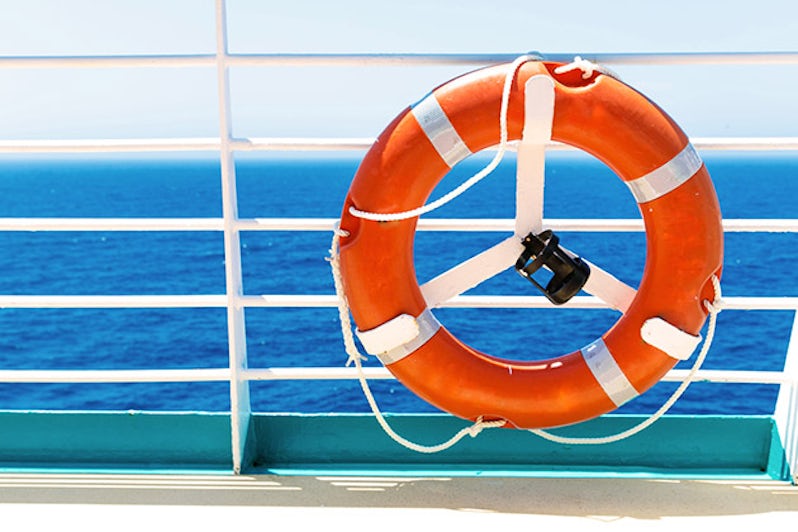
The above is not an indication that an ocean liner is inherently any safer than a cruise ship, only that a liner is less likely to list (or heel) from side to side in windy weather than a comparable cruise ship, at least technically.
In practice, the aforementioned Queen Mary was dubbed the "rolling Mary” due to its tendency to dramatically list despite its 39-foot draft. The truth is hydrodynamic hull design and testing have advanced to a point that a cruise ship with a shallower draft today should roll less than vessels of yesteryear. Besides, Icon’s considerable width is another dimension certain to further reduce rolling.
More to the point of safety equipment, Icon is far more well outfitted than Titanic was. Preventively, state-of-the-art radar (versus limited human lookouts) can pick up any potential intrusions, such as an iceberg, long before a cruise ship would ever encounter them and thus avoid them entirely.
But if there ever was a breach on Icon, double hull structures and enhanced watertight compartments could better defend against flooding. However, if worse came to worst and it ever had to be evacuated, for whatever reason, modern cruise ships have far more lifeboats , rafts and other flotation devices that exceed a vessel’s passenger capacity, let alone Titanic’s devastating deficit.
If anything, we have the historic ocean liner disaster to thank for SOLAS (Safety Of Life at Sea) provisions since it actually prompted such modern standards.
5. Icon of the Seas vs. Titanic: Edwardian Era and Class
Another hallmark of Titanic was its Edwardian-era style and respective first-, second- and third-class distinctions. While the wealthiest travelers could afford the sheer opulence of first, it was the poorest immigrants that could only pay for the most minimal third (or so-called steerage, named after its proximity to steering equipment).
Icon of the Seas is considerably more equitable, but it does sport its own ship-within-a-ship complex. Of its noted “neighborhoods,” the Suite Neighborhood and its double-decker sun deck, pair of private restaurants and VIP lounge are accessible exclusively by guests occupying the ship’s most top-tier accommodations.
But otherwise, Icon passengers have free rein of the rest of the vessel, which was certainly not the case on Titanic and across its rigidly enforced passenger spaces.
6. Icon of the Seas vs. Titanic: Public Amenities
Speaking of which, its Icon’s relaxed vacation amenities where the newest cruise ship most departs from the formal lifestyle of the outdated Titanic.
The ocean liner was a simpler ship with fewer, but still grand, public venues: a swimming pool, Turkish bath (spa), squash court, gymnasium, library, reception and smoking lounges, Parisian cafe, a singular a la carte restaurant and only one main dining room per class.
Compare that to Icon’s staggering countdown of 20-plus dining venues , 10 entertainment offerings, nine whirlpools, eight neighborhoods, seven pools and six waterslides, and you have yourself quite the maritime juxtaposition.
7. Icon of the Seas vs. Titanic: Private Suites
Even having a look at private accommodations, Icon manages to beat Titanic. The ocean liner’s two largest Deluxe Parlor Suites were known to encompass 50 feet worth of promenade deck all to themselves.
However, the cruise ship’s three-story Ultimate Family Townhouse for up to eight guests surely supersedes them at 1,770 square feet, a wraparound 750-square-foot balcony, multiple bedrooms and bathrooms, living and dining space, in-suite cinema, interior dry slide, Royal Genie service and much more.
So fear not: Icon of the Seas is not only safer than Titanic, it is far superior in every way.
© 1995— 2024 , The Independent Traveler, Inc.
Titanic vs Cruise Ship Comparison (Size, Cabins, and More)
Disclosure: This post may contain affiliate links. We may receive compensation when you purchase via my links at no cost to you. See my disclosure for more information.
The story of the Titanic has fascinated people for over a century, leaving many to wonder how this historic ocean liner compares to today’s modern cruise ships.
But how does the Titanic compare to a modern cruise ship?
Modern cruise ships are, on average, 20% longer than the Titanic and twice as tall . Icon of the Seas is the largest cruise ship in the world and is five times the size of the Titanic, with an internal volume of 250,800 GT.
In 1912, the Titanic was hailed as the largest and most luxurious ship of its time, but it doesn’t come close to modern cruise ships. Let’s look at the Titanic compared to modern cruise ships: size, passenger count, activities, dining, cabins, and safety features.
Table of Contents
Titanic vs Cruise Ship Size Comparison
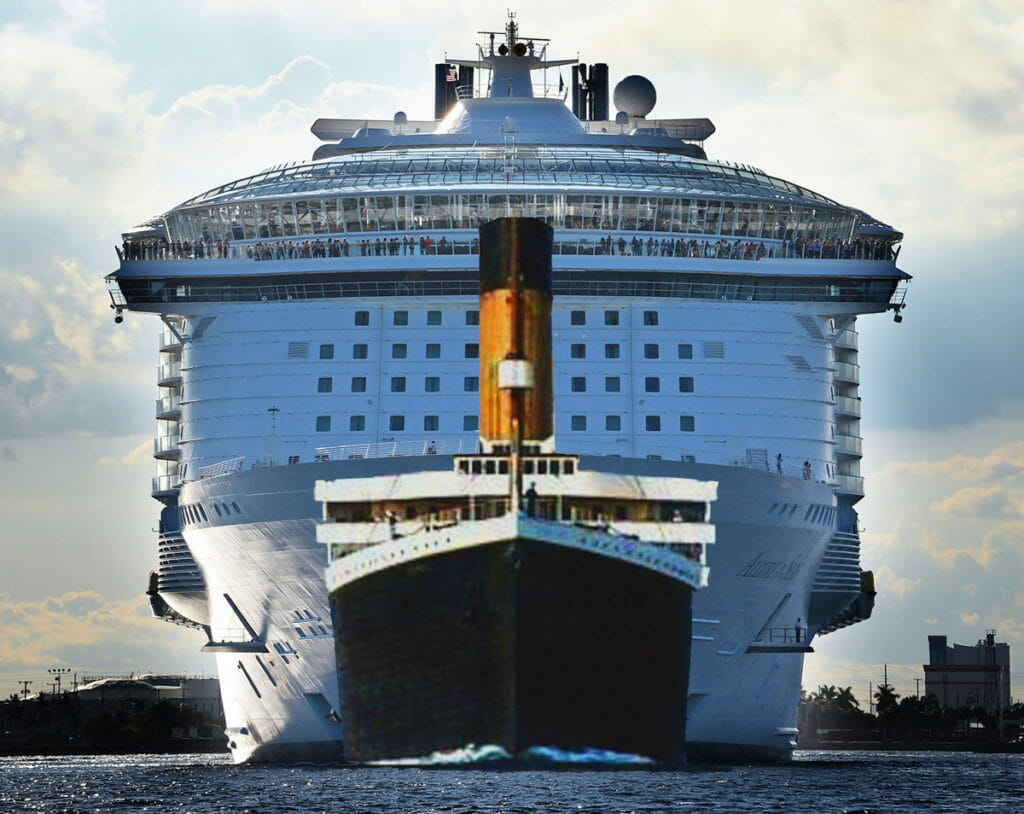
Built by White Star Line, the Titanic was the largest ship in the world upon its debut on April 10, 1912. The ship was the world’s largest and is still romanticized for its size and luxury.

How big was the Titanic?
The RMS Titanic had a gross register tonnage of 46,329 tons, 882 feet 9 inches long (269 meters), and 92 feet wide (28 meters). The Titanic’s gross registered tonnage was 46,329 GRT.
Modern ships are much larger than the Titanic. Modern cruise ships are on average 20% longer and twice as wide as the Titanic .
Today’s largest cruise ship is Royal Caribbean’s Icon of the Seas, with a gross tonnage of 250,800 GT . Icon of the Seas measures 1,188 feet long and is 210 feet wide
When measuring internal volume, Icon of the Seas is more than five times larger than the Titanic.
- Length: 882 feet 9 inches
- Gross tonnage: 46,329 GRT
- Width: 92 feet 6 inches
- Passenger Capacity: 2,453
- Length: 1,194 feet
- Gross tonnage: 250,800 GRT
- Width: 213 feet
- Passenger Capacity: 7,600
- Crew: 2,350
Below is a size comparison between the Titanic and several modern cruise ships:
Gross Tonnage

The Titanic had a gross registered tonnage of 46,000 GRT. By today’s standards, the Titanic wouldn’t even make the top 100 cruise ships in the world .
The Titanic’s gross registered tonnage is smaller than all of the cruise ships in the Royal Caribbean fleet . As well as the fleets of Carnival Cruise Line, Princess Cruises, Norwegian Cruise Line, and Virgin Voyages.

The Titanic was 882 feet 9 inches long (269 meters). Average cruise ships are around 1,000 feet in length.
Although cruise ships are much larger in every way, they’re not that much longer than Titanic.
That’s because modern ships still need to be able to dock in older ports that don’t receive frequent upgrades and expansions. The process of docking and maneuvering cruise ships means that although they can easily increase their height and width, they are limited in how long they can be built.
Passenger Capacity

The Titanic could carry 2,435 passengers and a crew of 885, for a total capacity of 3,320 people.
Modern passenger ships have an average passenger capacity of around 3,000 passengers and 1,200 crew members.
Meanwhile, Icon of the Seas has a maximum passenger capacity of 7,600 and a crew of 2,394, for a total of 9,382 people.
Thanks to its massive size, Icon of the Seas can hold three times as many people as the Titanic.
Deck Count (Height)
The Titanic had a total of 10 decks, with eight of those accessible to passengers.
Modern cruise ships have around 15 decks, with 13 accessible to passengers. While Icon of the Seas has 20 decks, with 18 passenger decks.
Construction Costs

The Titanic, built in 1912, had an estimated price tag of $7.5 million, equating to around $400 million in today’s dollars.
That may sound like a lot of money, but it pales compared to how much it costs to build a cruise ship .
An average-sized cruise ship costs around $1 billion to build. According to Royal Caribbean, the construction costs for Icon of the Seas are estimated at $2 billion.
Cruise Fares on Titanic Compared to Cruise Ship
Tickets to sail on the Titanic were not cheap. In 1912, a third-class ticket on the Titanic cost 7 pounds ($35), while a first-class suite cost 870 pounds ($4,000).
Adjusted for inflation, it would’ve cost 850 pounds ($1,071) for a third-class ticket and 105,000 pounds ($133,132) for a first-class suite.
I was surprised to learn that when adjusted for inflation, tickets to sail on the Titanic are similar to modern cruise ship fares.
While you can find 7-night cruise fares below $420 per person, tickets to sail on a new cruise ship are around $750 to $1,000 per person. The price of a suite on a modern ship is much lower than Titanic’s first-class cabins, at about $25,000 for a 7-night itinerary.
Cabin Comparison

Perhaps the most striking difference between the Titanic and modern cruise, apart from the sheer difference in size, is the quality of cabins and the range of activities and entertainment.
Passengers on the Titanic were divided into first, second, and third-class statuses based on wealth.
In total, Titanic featured approximately 350 first-class staterooms. The luxurious staterooms could be used for second-class passengers if needed.
The Titanic didn’t have any balcony cabins.
First-class cabins were the epitome of luxury on the Titanic. With about 905 passenger spots, first-class staterooms offer ornate decorations and lavish furniture. First-class guests could also access exclusive amenities such as the Parisian café, grand staircase, elegant dining areas, and spacious lounges.
Despite their luxury accommodation, many first-class passengers shared communal bathroom facilities. Additionally, freshwater aboard the vessel was scarce, meaning guests of all classes bathed in seawater.
Because of the limited freshwater, there was no laundry service aboard the Titanic. However, first-class passengers had their linens changed daily.

On the other hand, second-class staterooms provided a relatively comfortable experience with small cabins and basic decor. The rooms were more modest than the first-class cabins but provided a comfortable stay for middle-class passengers.
Second-class passengers slept on bunk beds, with two or four cabins per stateroom. Bunk beds are still standard on cruise ships , especially in family-sized staterooms.

Finally, the third class comprised the largest group of passengers with an estimated capacity of 974. Third-class cabins were more congested, with passengers sharing space in bunk-style accommodations. Despite the simpler living conditions, travelers in this class still enjoyed a decent level of service.
Third-class passengers shared two bathrooms on the ship, one for men and another for women.
Like the Titanic, today’s cruise ships model their cabins after high-end hotels. Fortunately for today’s cruise ship passengers, every stateroom has a full bathroom, air-conditioning, TVs, and even private balconies.

Modern cruise ships provide far more choices in cabin styles, including interior, ocean view, balcony, and suite accommodations.

Although passengers are no longer divided into classes, many cruise ships offer added benefits to guests staying in higher-priced staterooms and suites. These benefits may include access to a VIP lounge, show reservations, exclusive discounts, and more.
So maybe things aren’t so different after all.
Activities and Entertainment

There was very little formal entertainment onboard the Titanic. The ship’s entertainment consisted of an eight-man orchestra for the upper classes and a piano in the first-class dining room.

First-class passengers also had access to an indoor swimming pool and Turkish bath.
Passengers in the lower classes weren’t provided with any entertainment. Third-class passengers had access to the poop deck on deck B, a recreational space.
Fortunately, Titanic offered some onboard activities to keep passengers occupied. The ship had a squash court, smoking room, lounge, Turkish bath, steam room, pool, and gymnasium.

By comparison, the ships offered by modern cruise lines are basically floating resorts. Modern cruise ships boast numerous entertainment facilities, including multiple swimming pools, a spa, rock-climbing walls, ice-skating rinks, zip lines, and surf simulators.
Cruise ships also host live performances in grand theaters and smaller, more intimate venues that might cater to specific musical or comedic tastes.

The scope and scale of activities on modern cruise ships have expanded significantly since the Titanic’s maiden voyage.
Passengers on today’s cruise ships enjoy an extensive range of options, ensuring entertainment choices suit virtually every preference and age group. The level of luxury and comfort available on modern cruises ensures passengers have a memorable and indulgent experience while on vacation.
Dining Comparison

The Titanic had four onboard restaurants: A la Carte Restaurant, the Dining Saloon, the Verandah Cafe, and the Cafe Parisien.
A la Carte Restaurant was exclusive to first-class passengers. The restaurant is one of the earliest examples of extra-cost dining on a cruise ship. It was smaller than the main dining room but styled with elegant French decor.
Like specialty restaurants on modern cruise ships, there was an added fee to eat at the A la Carte Restaurant. The food consisted of “caviar, lobster, quail from Egypt, plovers’ eggs, and hothouse grapes and fresh peaches.”

The Dining Saloon was the equivalent of today’s main dining room. Passengers had assigned seating arrangements, and food was only served at specific times.
The Verandah Cafe and the Cafe Parisian were located near the promenade and offered a more intimate and casual dining experience.
Although cruise ship food has historically had a bad reputation, modern cruise lines have greatly improved the dining experience. Nearly every cruise line has fine dining experiences and dozens of onboard restaurants.
Virgin Voyages has eliminated buffets and the main dining room in favor of over 20 restaurants, each with a unique menu and dining experience. They’ve even enlisted the help of Michelin-starred chefs to create outstanding meals for passengers.
Safety Precautions It’sarison

It’s no secret that the Titanic didn’t have enough lifeboats for everyone. The ship was equipped with 20 lifeboats carrying up to 1,178 people, less than half the vessel’s capacity.
Surprisingly, the ship had enough space to carry many more lifeboats, which would be stored on the top deck. However, the ship’s operator decided that the added lifeboats would give the vessel a cluttered appearance and removed the lifeboats to preserve the Titanic’s luxury aesthetic.
The vessel was outfitted with approximately 3,500 cork-filled life jackets and 48 life rings. Unfortunately, they were of little use at the time of the disaster, given the temperature of the North Atlantic Ocean and the quick onset of hypothermia.

One significant change that has occurred is regulating the number of lifeboats onboard.
Today, modern cruise ships must have sufficient lifeboats and life-saving equipment for all passengers and crew on board, as mandated by the International Convention for the Safety of Life at Sea (SOLAS).
SOLAS is a set of international safety regulations established in response to the Titanic catastrophe to ensure maritime safety. These regulations encompass not only lifeboats but also emergency procedures, safety features, and robust design requirements.
Compliance with SOLAS is crucial for any cruise ship, and regular inspections are conducted to verify adherence.
One key safety measure now prioritized on cruise ships is the lifeboat drill.
The Titanic’s captain, Edward Smith, canceled the scheduled lifeboat drill the day the ship encountered the iceberg. In contrast, modern cruise ships routinely conduct lifeboat drills shortly after embarkation, familiarizing passengers with evacuation procedures and mustering points in the event of an emergency.
If you’ve been on a cruise ship, you’re familiar with the muster drill all guests must perform on embarkation day. It’s the law that the drill must be performed by every passenger prior to sailing to enhance emergency preparedness.
Additionally, modern ships have a suite of safety features to avoid disasters before they even occur. Advanced radar detection systems, fire suppression systems, advancements in steering technology, and more help make today’s cruise ships safer than ever.
While it is impossible to guarantee absolute safety, advancements in building methods, safety technology, and crew training have made disasters such as the Titanic rare.
Was the Titanic a Cruise Ship or Ocean Liner?

The RMS Titanic was an ocean liner that sank in 1912 after hitting an iceberg on its maiden voyage across the Atlantic Ocean.
Although many people consider the Titanic to be a cruise ship, the Titanic is actually an ocean liner .
It’s an important distinction.
Ocean liners serve the primary purpose of transporting passengers or goods from one destination to another. Unlike cruise ships which are often a destination in and of themselves, ocean liners serve as a means of transportation.

The Titanic’s operator, White Star Line, designed the Titanic to be both luxurious and comfortable to distinguish the ship from its competitors.
White Star Line’s biggest competitor, Cunard Line, focused on making its ships faster. Cunard Line prided itself on how fast it could transport passengers across the Atlantic.
White Star Line hoped that making their ships more comfortable for passengers would help differentiate themselves and attract more guests.

Ocean liners like the Titanic are all but a thing of the past.
Only one ocean liner is still in service; the Queen Mary 2 . This famous luxury ship has a top speed of 30 knots, compared to the average cruising speed of a cruise ship at 18-22 knots .
The Queen Mary 2 continues to offer traditional trans-Atlantic sailings from Southampton to New York.
Click here to learn more about ocean liners vs. cruise ships.
How Fast was the Titanic Compared to a Modern Cruise Ship?
The Titanic had a cruising speed of only 21 knots (39 kilometers per hour, 24 miles per hour) and could achieve a top speed of 24 knots (44 kilometers per hour, 28 miles per hour).
Ocean liners, like the Titanic, were built for speed and luxury to make regularly scheduled crossings.
The Titanic was powered by two four-cylinder triple-expansion steam engines as well as a low-pressure Parsons turbine.
Modern cruise ships have nearly the same maximum speed as the Titanic!
Compared to Titanic’s maximum speed, the Oasis of the Seas’ top speed is 24.5 knots , while 2020’s Mardi Gras ‘ is around 23 knots.
Some modern cruise ships can reach a top speed of 30 knots. But cruise ships rarely ever travel at top speed for safety and fuel efficiency. Most cruise ships travel at an operating speed of 18-20 knots.
Modern day cruise ship ships are built much larger than the Titanic; they are equipped with the latest propulsion technology. But the sheer size of today’s mega cruise ships means that extra horsepower doesn’t translate into faster speed.
But that’s okay because cruise ships aren’t designed to be fast.
Unlike ocean liners which travel long distances over periods of days, cruise ships don’t usually require fast speeds as they typically travel short distances between ports over the span of days.

Dane, K. (2019, July 4). Titanic dining . Titanic. Retrieved November 29, 2022, from https://www.titanic-titanic.com/titanic-dining/
Encyclopædia Britannica, inc. (n.d.). Titanic . Encyclopædia Britannica. Retrieved November 29, 2022, from https://www.britannica.com/topic/Titanic
First class dining saloon . Titanic Wiki. (n.d.). Retrieved November 29, 2022, from https://titanic.fandom.com/wiki/First_Class_Dining_Saloon
First class staterooms . Titanic Wiki. (n.d.). Retrieved November 29, 2022, from https://titanic.fandom.com/wiki/First_Class_Staterooms
History.com Editors. (2009, November 9). Titanic . History.com. Retrieved November 29, 2022, from https://www.history.com/topics/early-20th-century-us/titanic
Titanic lifeboats • titanic facts . Titanic Facts. (2020, July 13). Retrieved November 29, 2022, from https://titanicfacts.net/titanic-lifeboats/
Solas . International Maritime Organization. (n.d.). Retrieved August 15, 2023, from https://www.imo.org/en/KnowledgeCentre/ConferencesMeetings/Pages/S
Marcello De Lio
Leave a Reply Cancel Reply
Your email address will not be published. Required fields are marked *
Name *
Email *
Add Comment *
Save my name, email, and website in this browser for the next time I comment.
Post Comment
This site uses Akismet to reduce spam. Learn how your comment data is processed .
I think itś funny how everyone thinks that Titanic is just another ship. And now everyone thinks that the new ships are the gods of the seas. I mean yes there have been bigger and better ships built since the Titanic, but no ship will ever be as luxurious as the Titanic. Even though she’s sitting 2 1/2 miles under the water, she is always going to be the most beautiful ship ever built by the hand of humanity.
I’ve got to admit that I love the design of new cruise ships, but there’s something about the Titanic’s luxury and elegance that modern cruise ships simply cannot match. Cunard Line is the closest there is to traditional luxury sailing.
Trending now


Home » Cruise » Cruise Features » How the Titanic Compares to Modern Cruise Ships
How the Titanic Compares to Modern Cruise Ships
In case you've ever wondered, we share some surprising facts and figures about the Titanic vs modern cruise ships.
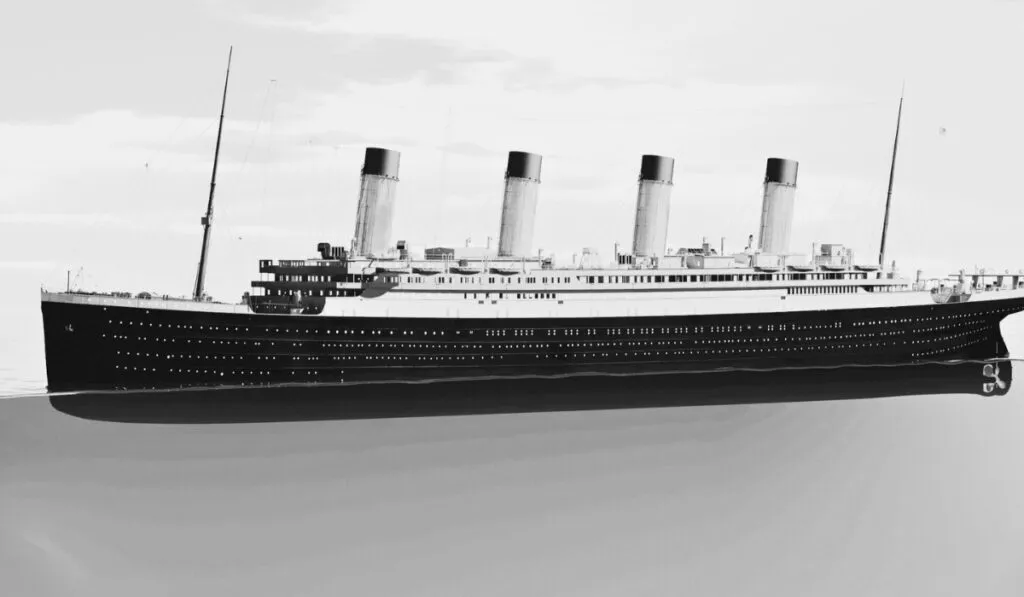
Share this post:
The most famous passenger ship of all time is a title that still belongs to the Titanic, more than a century after its maiden voyage in 1912. Unfortunately, it’s because the sinking of the Titanic is still one of the worst maritime disasters in history, immortalized forever in museums, books, film and pop culture.
It’s understandable, then, why so many wonder how the Titanic compares to modern cruise ships sailing today. It might be baffling to imagine, but while cruise ships have leapt in size since the world called Titanic the largest ship of its time, they have also drastically reduced their chances of sinking .
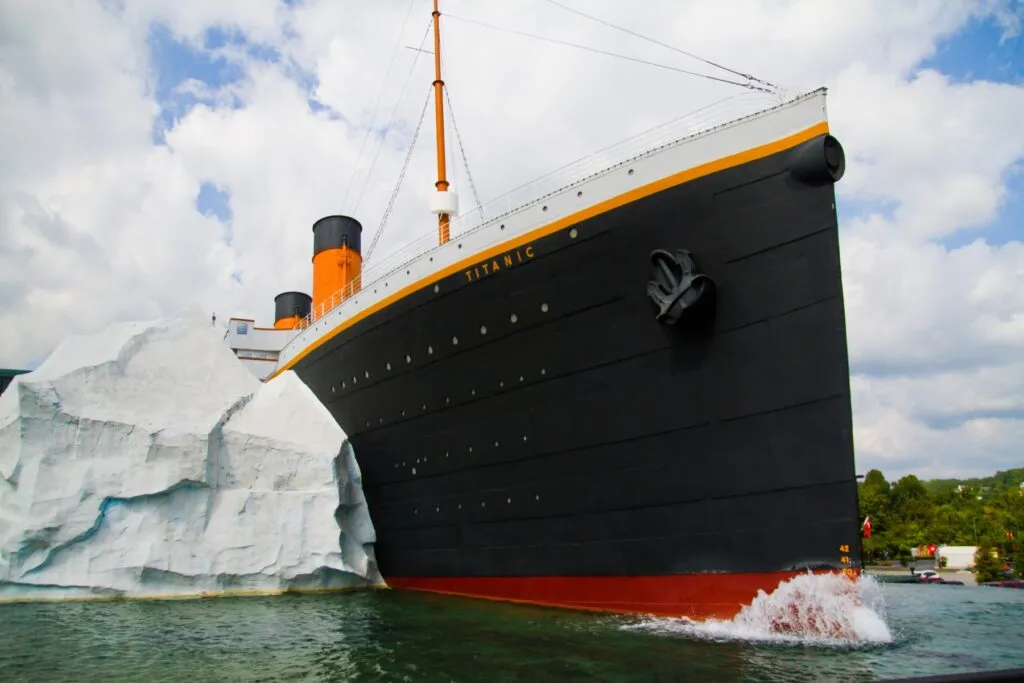
Current technology and enhanced safety features all but ensure that any major malfunctions are prevented when it comes to the integrity of a ship’s hull and structure. And of course, all cruise ships must have enough lifeboats to accommodate everyone onboard — a very glaring oversight that contributed to the Titanic’s avoidable death toll.
What else is there to know about the Titanic vs modern cruise ships? Read on for some surprising facts and figures.
Call to Book Your Next Cruise Now: 1-855-228-5584!
Titanic Vs Modern Cruise Ships
What is the size difference between the titanic and modern cruise ships.
The Titanic was technically an ocean liner, operated by the White Star Line. This means it was designed to transport passengers across the ocean (in this case, Southampton to New York). When built at the turn of the 20 th century, the Titanic was a feat of modern engineering. It measured 882 feet long and 46,328 gross registered tons (GRT), which is a measurement that incorporates the ship’s total enclosed volume. It featured 10 total decks.
In comparison, the modern cruise ship version of the Titanic — aka the world’s largest passenger vessel — is Royal Caribbean’s Icon of the Seas at the time of publication. It is 1,198 feet long and measures 250,800 GRT — a staggering five times the size of the Titanic by volume. It also boasts more than twice the number of decks, with 20.
While it only sailed one fateful voyage, the Titanic had a passenger capacity of 3,353 people (2,453 guests and 900 crew) while Icon of the Seas is capable of carrying 2,350 crew members alone, along with up to 7,600 guests.
Average Size of Modern Cruise Ships
It’s important to remember that while cruise ships are remarkably bigger, Royal Caribbean’s mega-ships are an exceptional example. The average size of a cruise ship is much closer to that of the Titanic in length and capacity, though gross tonnage has grown.
Another recent build, Norwegian Viva , measures 965 feet long and carries 3,099 passengers (plus crew). However, at 142,500 GRT, even Norwegian Viva is three times the size of the Titanic.
The only ocean liner sailing as a cruise ship today is Cunard’s Queen Mary 2, which offers a similar and historic transatlantic route . Actually, Cunard Line purchased the White Star Line (which built the Titanic) in 1950. In comparison, the QM2 is 1,132 feet in length, 148,528 GRT and consists of 18 total decks. The liner carries up to 2,691 guests and 1,292 crew members.
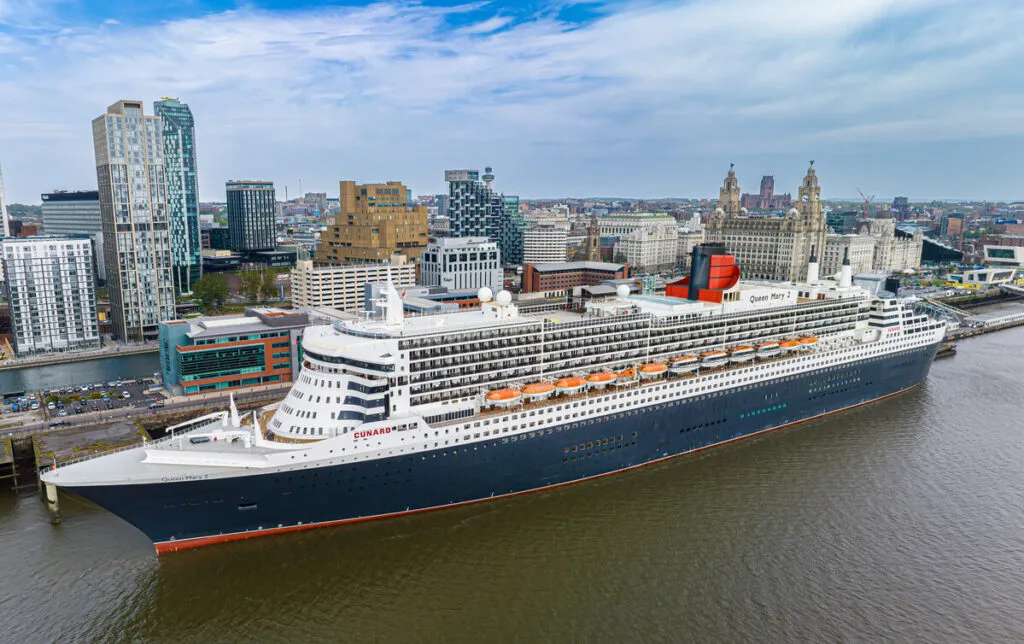
EXCLUSIVE SAVINGS: Get Deals on Your Next Cruise Now!
How do modern cruise ships compare to the Titanic?
Size isn’t everything, although it was a significant part of what made the Titanic so noteworthy for its time. The passenger experience on cruise ships is significantly different now than it was more than 110 years ago — to say the least.
For starters, while there are cabin categories (like suites) that earn passengers additional perks, all paying passengers onboard a cruise ship today have access to most of the ship’s public spaces and services, including restaurants and entertainment.
This was not the case aboard the Titanic. There were first-, second- and third-class cabins with separate dining rooms, shared bathrooms, and little else to occupy those not in first class. Most passengers were relegated to third class, and cabins — often in unsavory locations like near the engine room in the bowels of the ship — accommodated up to 10 people!
The “first class” you might be imagining was also far from the plush staterooms available these days. Even though they had up to two bedrooms, a parlor, and an all-important ensuite bathroom (for the very top tier), there were no balconies in any cabin.
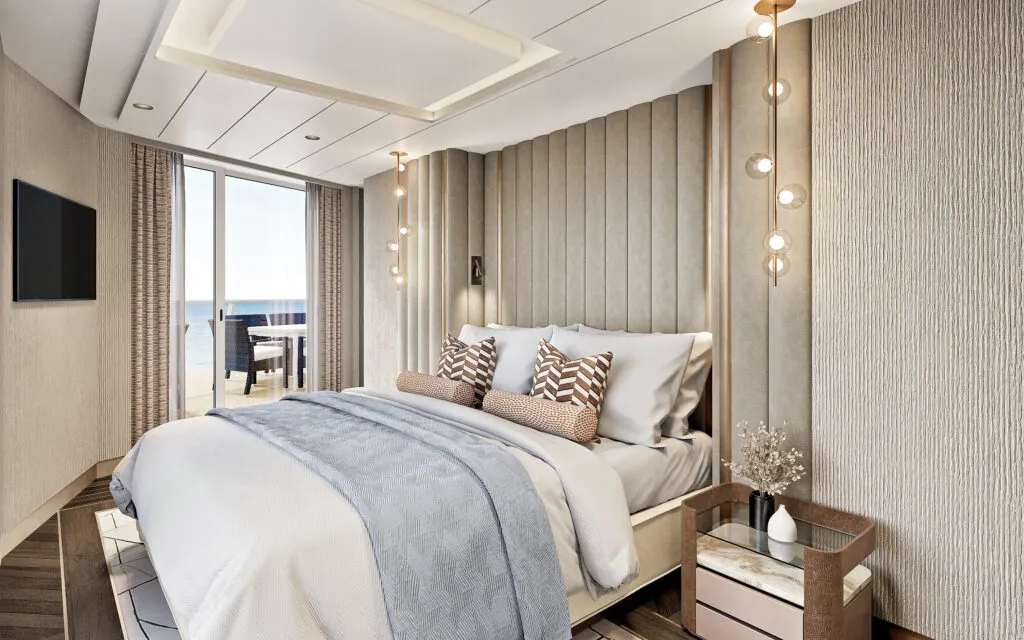
Titanic Vs Modern Cruise Ships’ Amenities
Despite everything aboard cruise ships today , from waterslides and racetracks to multi-story theaters, the Titanic was actually the most comfortable and amenity-packed ocean liner when it debuted. Some of that glamour can be seen in the 1997 film “Titanic,” which dramatized the ship’s first and only journey. Décor included ornately carved woodwork, European furnishings, and gilded touches.
While it was far from the sprawling spas and fitness centers found at sea today, Titanic did feature a gym with workout gear of the time, as well as a Turkish-style bath, steam room, and treatment room. Other diversions included a pool, promenade, reading/writing room, smoking lounge, and squash court.
While companies over the years have tried and failed to replicate the Titanic as a modern cruising attraction, the classic design of Cunard Line’s ships is about as close as you might come to the experience of formal dress and traditional decor — albeit in a bit more comfort.
Like Titanic did for its time, modern cruise ships are mostly concerned with staying on top of trends, whether it’s the newest fad in dining or design, to keep passengers happy. But, most importantly of all, they are also well equipped to avoid icebergs and keep passengers safe.
BOOK NOW: Get Exclusive Rates on Your Next Cruise!
Do you have anything to add when comparing the Titanic vs modern cruise ships? Do you enjoy geeking out over these engineering marvels? Drop us an anchor below to share your upcoming cruise plans.
Related Posts

Cruiseline module – Remove Title
1 comment on how the titanic compares to modern cruise ships, leave a reply cancel reply.
Your email address will not be published. Required fields are marked *
Sign up to our newsletter!
Titanic was not a cruise ship. It was an ocean liner.
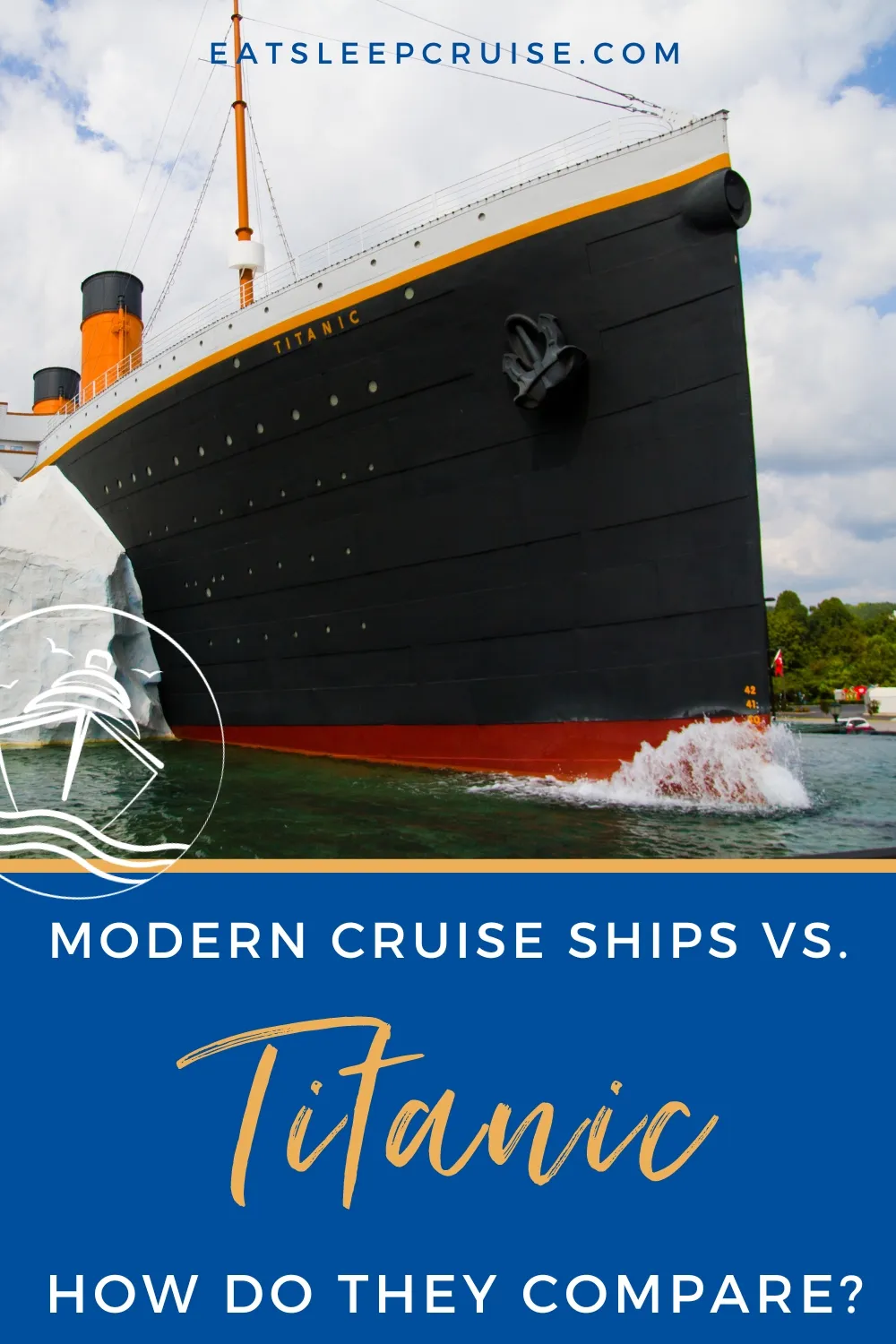
DB & The Princess
Welcome Aboard! We are Don and Heidi, the husband and wife travel team behind EatSleepCruise.com. We took our first cruise vacation together 13 years ago and have been hooked ever since. Follow along as we share our travel tips, cruise reviews, information on ports of call, and the latest cruise news to help you plan the ultimate cruise vacation. Are you ready to embark on your journey to “sea the world, one port at a time”?

What’s Trending
Contact Us: [email protected]

Titanic Vs Modern Cruise Ships (Size Comparison)
This post may contain affiliate links. if you click one, i may earn a commission at no cost to you. as an amazon associate, i earn from qualifying purchases..
At the time, the Titanic was an epic achievement in engineering – or at least, so people thought until she sank on her maiden voyage across the Atlantic .
But she was still seen as an impressive feat. Yet the Titanic remains one of the most iconic ships ever built despite being over 100 years old. How does she compare in size with the modern cruise ships of today?
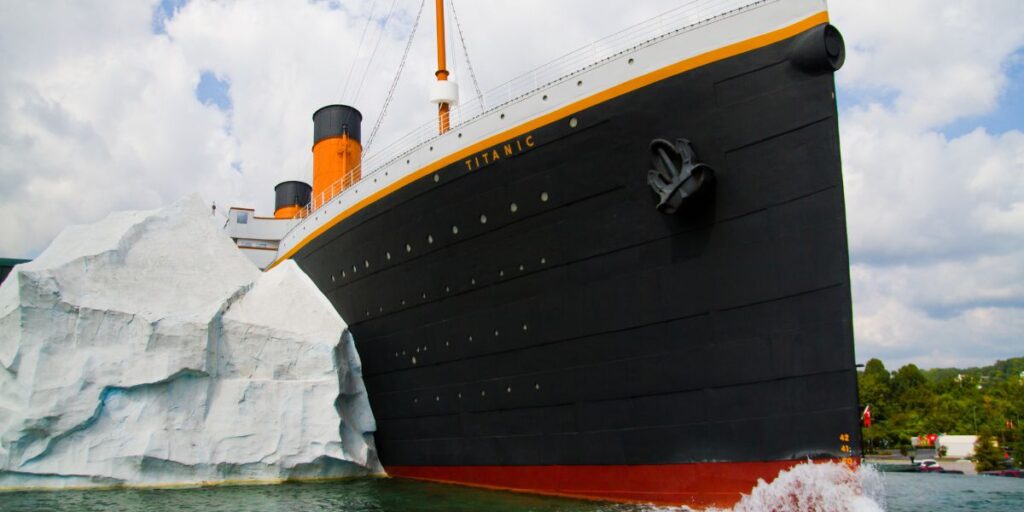
Was she ahead of her time, or when the Titanic is compared to a modern cruise ship, does she now seem like a small boat in comparison? Let’s take a look at Titanic vs cruise ship comparisons.
- Was the Titanic a cruise ship?
- How does the Titanic compare to today’s cruise ships?
Titanic Vs Modern Cruise Ship Size
- How big was the Titanic compared to a cruise ship?
- Cruise Ships That Are A Similar Size to Titanic
Largest Cruise Ship Vs Titanic
- How big is the biggest cruise ship compared to Titanic?
Was the Titanic a Cruise Ship?
The Titanic was not considered a cruise ship. She was a passenger liner and also a Royal Mail ship. Rather than being designed for a pleasure cruise, she was carrying passengers and mail on a one-way trip to New York from the UK.
A cruise liner is a ship that is designed for one-way travel, and we don’t tend to have them in modern times – people prefer to use planes since they’re so much faster. But in 1912, when commercial flights weren’t a thing (the first aircraft was only successfully trialed 9 years earlier), passenger ships were the default option for long-distance travel.
That doesn’t mean they weren’t comfortable. The Titanic had multiple restaurants, in the same way that a cruise ship today does, and served high-quality food. There were a number of leisure activities available to guests, too, including tennis, shuffleboard, quoits, and a card room. There was also a gym and even a swimming pool.
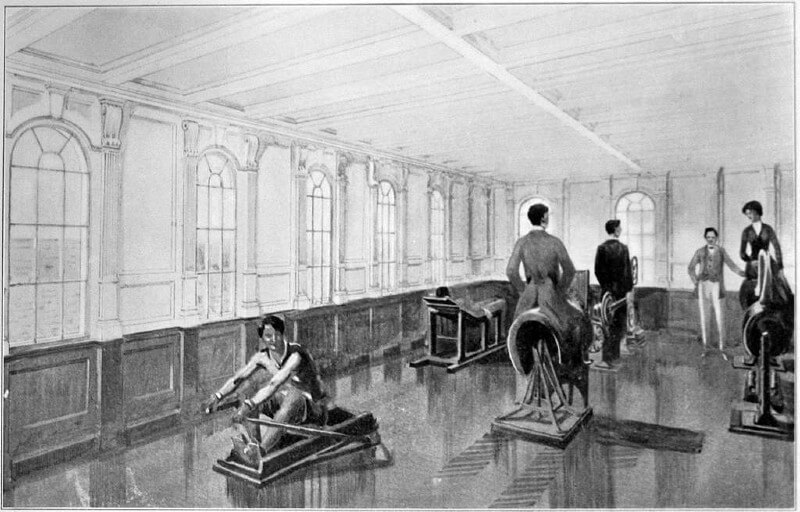
So, while the Titanic was not a cruise ship, it did have many of the features that have since become standard on modern cruise ships.
How Does the Titanic Compare to Today’s Cruise Ships?
Modern cruise ships tend to be much larger than the Titanic on average – not so much in length, but in width and height. The Titanic was considered more luxurious than many (but not all) modern cruise ships, but of course, was a lot less safe too.
There are so many ways you can compare the Titanic with modern ships – there’s no single Titanic size comparison measurement.
You can look at how many dining venues they have, with modern ships having a lot more choice (although the Titanic wasn’t just a single-restaurant ship).
Or the style of cruising – the Titanic was very much a formal ship, particularly in first class, while many of today’s modern ships have abandoned a lot of the formality in favour of a more family-friendly approach.
For the purpose of this guide with Titanic compared to modern ships, let’s focus more on the difference in size, since that really tells you the most about the ships of today and the space they offer passengers.

How Big Was the Titanic Compared to a Cruise Ship?
The Titanic was about as long as the average modern cruise ship – she was 882 feet long. There are a wide variety of small and super-size ships sailing the ocean now, averaging at 830 feet. But in terms of height and width, the Titanic was smaller than average modern ships.
While in 1912, the race was often to build bigger and bigger ships, that approach is slightly different today. While we are seeing new ships launching every few years that break the record in terms of size, we’re also seeing many cruise lines launching smaller ships.
These smaller ships are sometimes aimed at offering a more luxurious experience to guests, ensuring a higher staff-to-guest ratio. Or they’re built to explore areas of the world few passengers have been able to, including the polar regions.
I’ve taken a look at around 300 of the world’s most popular cruise ships to get to some average figures in terms of the modern ship size, so we can compare them against the Titanic. I’ll pick out a couple of key ships in the stats too, so you can see just how the Titanic ranks when put against modern ships.
Read more: How big is a cruise ship?
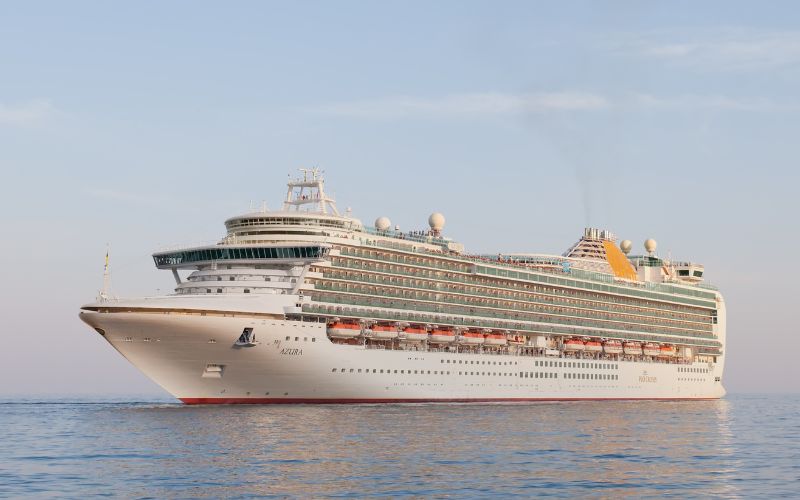
Gross Tonnage
Gross tonnage is one of the best ways to compare ships. The Titanic’s gross tonnage was 46,328 while the average ship in today’s world would have a gross tonnage of around 77,000. So the Titanic was around 40% smaller than your average cruise ship today.
Gross tonnage isn’t anything to do with the weight of the ship, despite the word “ton” being in the term. That can confuse a lot of people. It’s instead got to do with the internal volume of the ship.
One gross ton is the same as 100 cubic feet. The higher the gross tonnage, the bigger the ship is overall, as it has more internal space.
So this is the best way to compare the Titanic to modern ships since it takes into consideration all of the measurements and explains just how much more spacious today’s ships would be.
While the Titanic may be slightly longer than the average cruise ship today, she has a much smaller gross tonnage, because she wasn’t as wide nor was she as tall. She may have had a similar number of decks, but each deck would have felt more spacious.
It’s worth pointing out that when you look at one of the smallest cruise ships you can book right now – Celebrity Xploration – she has a gross tonnage of just 319.5 – less than 10% that of the Titanic. So really, the Titanic size comparison depends on the type of modern ship you compare her to.
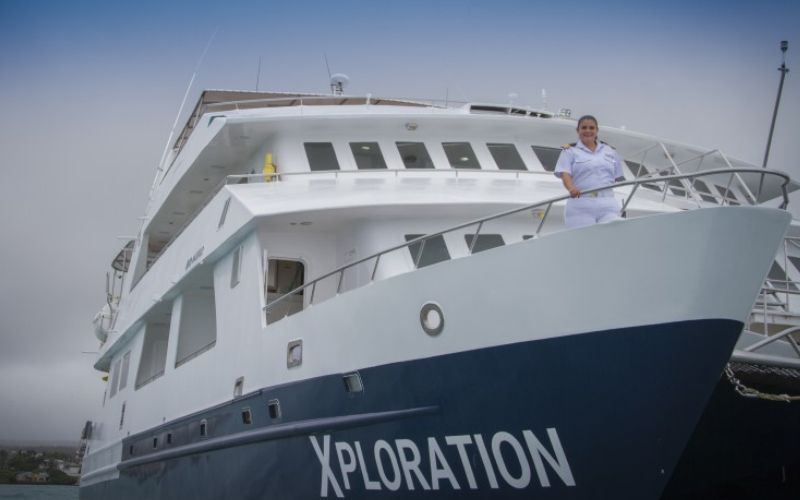
And if you look at one of the smaller luxury ships that aren’t a specialist exploration ship – such as Silversea’s Silver Shadow – she has a gross tonnage of just 28,258, only around 60% of the size of the Titanic.
We’ll compare Titanic to the largest ships just below, but the key point to make is that Titanic wouldn’t be completely dwarfed in today’s cruising world, although from a gross tonnage perspective, she would be well below average.
One of the easiest ways to visually compare a cruise ship is by looking at the length. The Titanic was 882 feet long, and when you take all modern cruise ships into account, including dedicated exploration ships, the average is around 830 feet. So, the Titanic was actually longer.
Some context is important here, though – that average, as I’ve stated, includes the many small exploration ships that are purpose-built to be smaller so that they can either get around the polar ice caps or into ports that aren’t designed for larger ships.
If you were to take only the top 150 cruise ships in the world in terms of length, every single one of them would be longer than the Titanic. But we’ll get to the comparisons against the larger ships shortly.
The Titanic is significantly longer than the smallest ships currently sailing. Going back to the Celebrity Xploration, which is only 98.3 feet long, the Titanic is almost 10 times the length.
But the Silver Shadow, one of the smaller luxury ships, isn’t quite as dramatic a difference. She’s 610 feet long, which puts her at around two-thirds of the length of the Titanic. That might still sound significant, but we’re talking about one of the very smallest ships of 300 that currently sail.
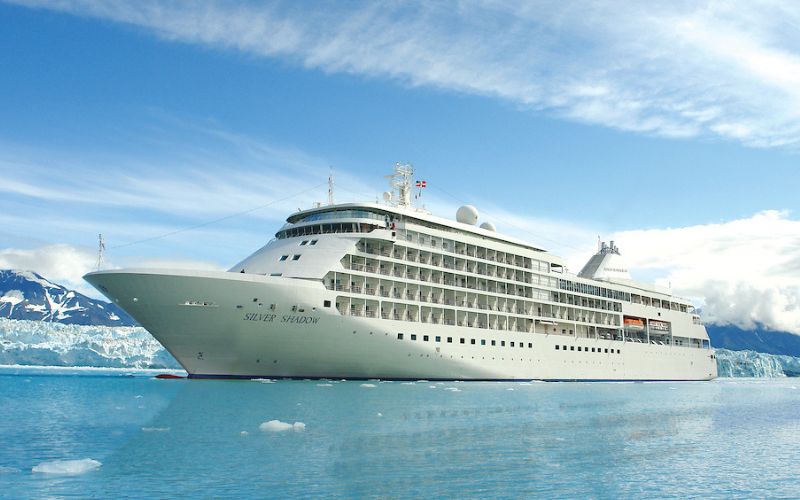
The average of modern cruise ships is definitely weighted lower by these speciality exploration and luxury ships, but remember that there are many ships that are longer than the Titanic was too.
Width (Beam)
The Titanic may have been slightly longer than the average cruise ship, but in terms of width, she was slightly narrower. She measured 92.5 feet across, while the average cruise ship in the modern world is 110 feet across.
But again, there is context to consider as this also includes the smallest ships in the world, of which there are many. And these smaller ships are often designed for very small passenger numbers, meaning they aren’t particularly wide at all.
If you once again restrict the stats to only the top 150 cruise ships in the world, the average width is even larger at 128 feet. That’s over 35 feet wider than the Titanic was, around 33%.
But let’s again see how she compares to the narrowest cruise ship, which again is Celebrity Xploration (although Le Ponant, a luxury yacht-style cruise ship, is the same width). These two ships are just 36 feet wide, so around 40% of the width of the Titanic, which was built around a century earlier.
And if we look at the Silver Shadow, she is 79 feet wide – around 85% of the width of the Titanic.
As I’ve covered, a lot of modern cruise ships aren’t built to be the biggest but instead target a particular market. And sometimes, they’re built to certain dimensions to be able to sail to a specific destination.
And one of those is the canals of the world, including the Panama Canal – one of the most popular since it allows cruise ships to easily travel between the American coastlines.
The newest locks in the Panama Canal have a set of restrictions that ships cannot exceed if they want to be able to sail through. These ships are classified as New Panamax.
And it’s interesting to note that, with the dimension restrictions set at 168 feet wide and 1,201 feet long, the Titanic would have been able to sail these locks quite easily. She could also navigate the Suez Canal.
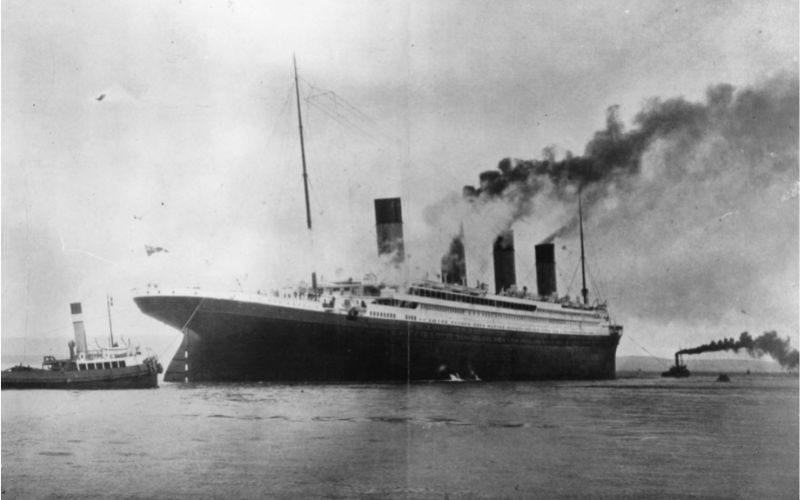
The Titanic had 9 decks that passengers could access. While modern cruise ships can have between 3 and 18 decks, the average cruise ship will have a similar number to the Titanic – usually between 9 and 11.
The largest ships in the world often have more – of the 20 decks on the Icon of the Seas, 18 are passenger decks. And some MSC Cruises and P&O Cruises ships have decks numbered as high as 20, although not all of these are open to guests.
Of course, it’s worth remembering that the Titanic had a class system in place, and some of the areas of the ship would be out of bounds to third- and second-class passengers. And conversely, first-class passengers would have avoided the areas where third-class passengers tended to mingle.
Modern cruise ships don’t have anything like those restrictions. There will be some facilities that are exclusive to certain suite guests – things like the Haven on NCL, MSC Cruises’ Yacht Club or the Family Lounge on Carnival – but the majority of the ship’s decks are open to all guests at almost all times.
Passenger Capacity
The Titanic, at maximum capacity, would have been able to hold 2,435 passengers and 892 crew, for a total combined capacity of 3,327 people. If you take the average cruise ship today, including all the small ships that often have fewer than 100 passengers, then the average is almost identical – around 2,450 guests and 750 crew.
Again, if we take that average to just being of the top 150 cruise ships in the world, it jumps up significantly to around 3,500 passengers and a crew of around 1,400, for a total capacity closer to 5,000.
Of course, there are some ships much larger than this again, but there are a lot of ships that have a passenger capacity between 3,000 and 3,500 so the super-ships don’t skew these averages too much.
Here’s a quick comparison of the Titanic against the average cruise ship:
And here’s the same table comparing the Titanic to an average of just the largest 150 cruise ships in the world:
Cruise Ships That Are a Similar Size to Titanic
Here’s a list of just some of the cruise ships that are very similar to the Titanic.
In Gross Tonnage:
- Seven Seas Mariner, a luxury ship for Regent Seven Seas with a GT of 48,075
- Empress, an ex-Royal Caribbean ship sailing for Indian line Cordelia Cruises , with a GT of 48,563
- Norwegian Spirit , a ship sailing for NCL and measuring 879 feet
- Majesty of the Seas, a former Royal Caribbean ship now sailing for Seajets and measuring 880 feet
And in terms of passenger capacity:
- Norwegian Pearl, an NCL ship with a capacity of 2,394 passengers
- Queen Elizabeth, a ship sailing for Cunard with a maximum capacity of 2,547 passengers
Most of the ships to have launched more recently are a little bigger than the Titanic, so there aren’t a lot still sailing that closely match her for size. Ships are either being built for more capacity and features or specifically for a luxury cruise market, where they tend to be smaller and have fewer than 1,500 passengers.
The current largest ship in the world is the Icon of the Seas, which Royal Caribbean took ownership of in December 2023 ahead of her first passenger cruises in early 2024.
And while it is interesting to compare the Titanic to average cruise ship sizes, it’s worth remembering that when she was launched in 1911, she was the largest ship in the world at that time.
And so it definitely makes for an interesting comparison when you look at the Titanic against the current largest cruise ship in the world.
How Big Is the Biggest Cruise Ship Compared to Titanic?
The biggest cruise ship in the world, Royal Caribbean’s Icon of the Seas , is approximately five times the size of the Titanic. While the Titanic is similar in size to some of the smaller cruise ships still being built, she is significantly smaller than today’s largest ships.
The best way to compare the two ships is in gross tonnage, as this tells you the overall volume of the ships. And with the Titanic’s 46,328 GT against Icon of the Seas’ 250,800, that’s where we can see just how stark the difference is.
In terms of length, Icon of the Seas is not that much bigger – around 300 feet longer, so around 33% bigger compared to the Titanic. If you were to put the Titanic next to a cruise ship like the Icon of the Seas though, she would still look tiny despite not being drastically shorter – so how does Icon of the Seas end up being 500% of the Titanic’s total size?
The answer comes when you look at the width and the number of decks.
Icon of the Seas is over twice the width of the Titanic, and while we don’t have the exact width yet, we know it’ll be over 210 feet compared to just 92.5 feet. That’s a mammoth difference. It’s also where the Icon of the Seas exceeds many of the other ships being built today, which will average often as little as half that again.
And with 18 passenger decks, she is 100% times bigger again. This gives guests a lot more space to roam and explore and allows for a wealth of extra features. Icon of the Seas has seven swimming pools to Titanic’s one, for example.
In terms of passenger capacity, Icon of the Seas can carry over three times the number, and it has almost 2.5 times the number of crew working the ship.
Interestingly, the Titanic had a better crew-to-passenger ratio. On the Titanic, there was 1 crew member for every 2.7 passengers, while on Icon of the Seas that ratio becomes 1 crew to every 3.2 passengers.
But also worth noting is the extra space guests can enjoy. The Titanic had 19 gross tons for every passenger, while Icon of the Seas has 34 gross tons per passenger – so almost twice as much space per passenger.
Want to learn more about how the Icon of the Seas compares to the Titanic, including the available activities, the dining options, and how much it cost to buy a ticket? Read more on the Icon of the Seas vs the Titanic .
To Conclude
It would be natural to assume that modern cruise ships would all be larger than the Titanic, since they’re all around a century newer.
But the Titanic isn’t completely dwarfed by all modern ships – with the concept of small ship cruising becoming extremely popular.
But place the Titanic next to the very largest ships in the world that are sailing today and you will absolutely see just how different they are. Modern cruise ships feel like vast cities compared to the passenger liner that was intended to ferry people – in relative comfort – across the Atlantic.
Have you enjoyed this comparison, and want to learn more about the Titanic? Read more about Titanic ticket prices here .
Plus, if you want to learn more about the cost of cruising on a modern ship, so you can compare those Titanic prices with the latest itineraries, I have a guide on cruise costs here .
And while the Titanic famously sank on her maiden voyages, do cruise ships sink with any regularity these days? Read my article on how many cruise ships have sunk .
Related Posts:
- Do Cruise Ships Have Enough Lifeboats?
- Symphony of the Seas Vs Titanic
- Wonder of the Seas Vs Titanic
- Seawise Giant Vs Titanic
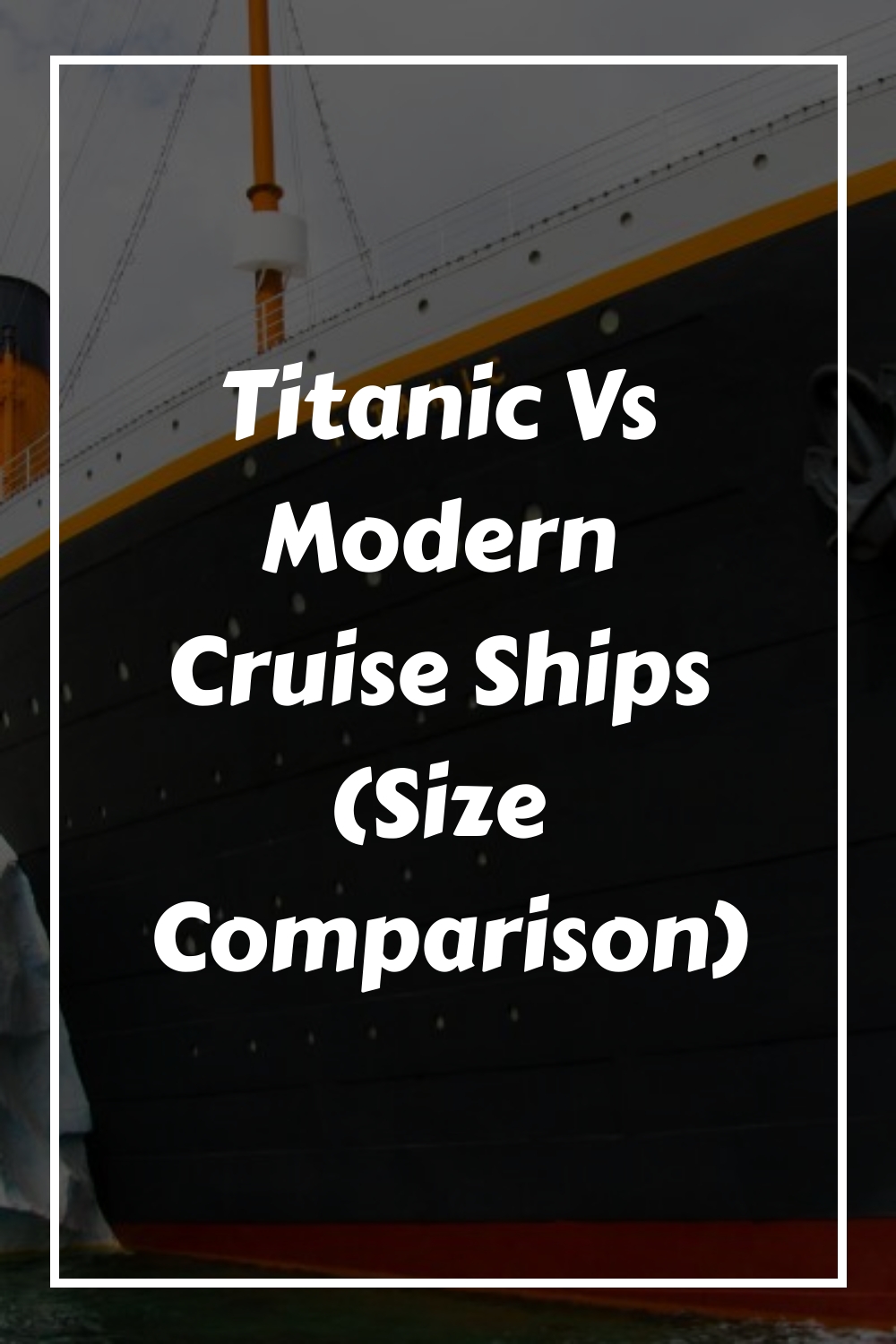
If you found this interesting, please share!
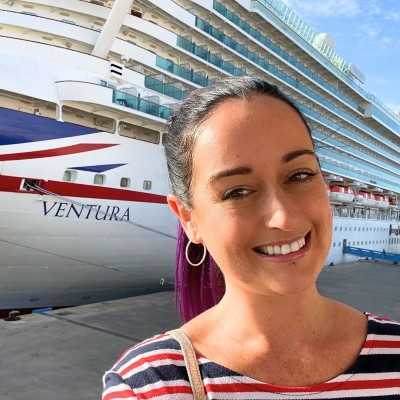
Jenni Fielding is the founder of Cruise Mummy. She has worked in the cruise industry since 2015 and has taken over 30 cruises. Now, she helps over 1 million people per month to plan their perfect cruise holidays.
Read more about me
1 thought on “Titanic Vs Modern Cruise Ships (Size Comparison)”
RMS Titanic always will be the greatest of the giant liners
Leave a comment Cancel reply
Save my name, email, and website in this browser for the next time I comment.
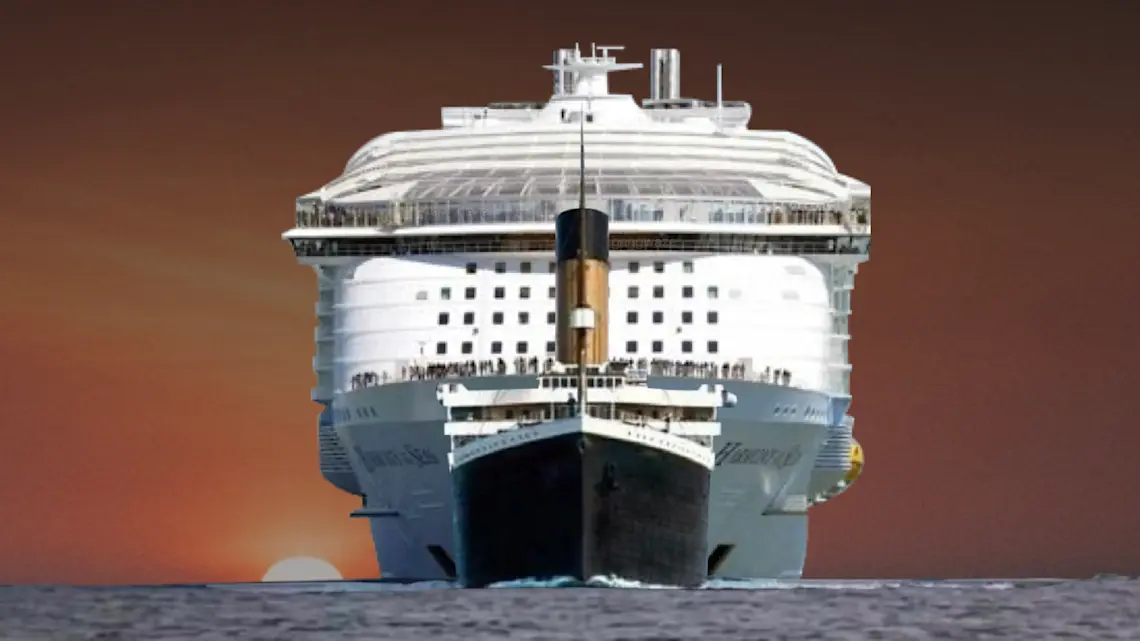
Titanic vs Modern Cruise Ship Size Comparison | Infographic
Below we compare the Titanic vs modern cruise ships . We'll look at size, passenger count, crew, and more. You'll find a comparison to the average cruise ship and also a side-by-side view of the Titanic vs the largest cruise ship in the world!
We'll not get into the sinking of the Titanic. We'll let James Cameron handle that one. We want to compare the largest passenger liner of its time, the Titanic, vs modern cruise ships.
Built by the White Star Line, the RMS Titanic was the largest ship entering service in 1912 . White Star was in competition with Cunard Cruise Line for dominance over the Atlantic passage. Cunard focused on speed. The Titanic prioritized size and comfort. Like modern cruise ships, the Titanic wanted to be the biggest and most awe-inspiring vessel out there. White Star spared no expense in the construction. The financing was actually provided by JP Morgan!
There's no denying that cruise ships have grown significantly since the early 1900's. However, this growth pales in comparison to that of sky-rise buildings.
You can see from the chart above that building size has grown significantly faster than cruise ship size. The tallest building in 1912 was just 390 feet high. Today it's 2,717 feet! Compare that to the Titanic's length of 883 feet vs the biggest cruise ship today length of 1,184 feet.
Let's now compare the Titanic vs modern cruise ships on each major metric. For more context, we also measure her against the Symphony of the Seas. This is currently the largest cruise ship in the world.
Titanic vs Cruise Ship Size
When comparing the Titanic to modern cruise ships, let's make sure to note that this ship was built over 100 years ago !
The Titanic was HUGE for its day and age! When compared to modern cruise ships, she's smaller for sure. But, not smaller in the magnitude that you'd expect given the time span.
Our infographic above shows the comparison between the Titanic vs modern cruise ships. It also compares her size stats with that of the Symphony of the Seas. As of 2022, the Symphony of the Seas is the biggest cruise ship in the world. Check out our post here for the 25 largest cruise ships in the world .
In the chart, you'll find a column for "modern cruise ships." That includes all active ships for the following cruise lines: Carnival, Royal Caribbean, Princess, NCL, and Disney.
Titanic Tonnage
What was the Titanic's gross tonnage ? The Titanic measured 46,328 in gross tonnage. This compares to modern cruising vessels weighing in at 113,525 GT. The Symphony of the Seas tips the scales at 228,081 GT.
Titanic Length
What was the Titanic's ship length ? The Titanic measured 883 feet in length. This compares to modern cruising vessels at 980 feet long. The Symphony of the Seas is 1,184 feet from end to end.
Titanic Draft
What is the draft of the Titanic ? The draft is the distance between the waterline and the bottom of the ship's hull. The Titanic draws 35 feet for is draft. This is only sizing measurement for which she's greater than her modern day counterparts. The average ship today has a draft of 27 feet, while the Symphony of the Seas draws 31 feet.
Titanic Beam
What was the Titanic's beam or width ? A ship's "beam" is essentially its width. From side to side, the Titanic measured 92 feet in width. The beam of a modern cruise ship today measures 119 feet. The Symphony of the Seas spans 137 feet.
PASSENGER & CREW COUNT
How many passenger decks did the ship have ? Titanic had a total of 10 decks. Eight of those were passenger decks. Modern cruise ships average 13 passenger decks and the Symphony of the Seas has a total of 16 decks for guests.
Cabin Count
How many cabins were on the Titanic ? There were 840 staterooms on the Titanic. First class cabins made up a total of 416 of these. Second class rooms accounted for 162 and 262 of these were for third-class passengers. Today's cruise ship averages 1,401 cabins and the Symphony has 2,745 total staterooms.
Titanic Passenger Count
How many passengers did the Titanic hold ? Titanic held a total of 3,353 individuals. This included 2,453 passengers and 900 crew members. Modern cruise ships compare with an average capacity of 3,077 cruisers and 1,203 crew members. The largest cruise ship in the world, the Symphony of the Seas, has a capacity of 5,518 passengers. The ship has 2,200 crew members serving these guests for a total of 7,718 people on board.
How fast was the Titanic ? The ship had a total maximum speed of 23 knots. For our non-maritime folk, that's roughly 26.5 mph. The typical cruising vessel today has a max speed of 29 knots and Royal Caribbean's largest ship maxes out at 22 knots.
TITANIC COST VS MODERN SHIPS
Cruise Cost
How much did a ticket cost on the Titanic ? The Titanic had three classes of cabins. First, second and third. The cost of each were surprisingly consistent with cruise costs today.
- 3rd Class Price : The lowest cabin class ranged in cost from $15 to $40. In today's dollars, that would be $423 to $1,129. From our cruise pricing widget below, you can see that you can cruise the largest ship in the world for less than the Titanic would have cost 100+ years ago.
- 2nd Class Price : The second class cabins were roughly $60 ($1,693 adjusted to today). This is similar to the cost of a standard, inside cabin on modern cruise ships.
- 1st Class Price : First class cabins cost $4,234 in today's dollars, or $150 at that time. Balcony cabins, and even mini suites will cost roughly the same on the Symphony of the Seas.
- High End Suite : The most expensive suite on the Titanic was the Parlor Suite. In 1912, it cost $4,350. That's the equivalent of $122,722 today! The Ultimate Family Suite on the Symphony of the Seas will set you back a whopping $85,000 during Christmas week.
We hope that you liked this post. If so, please use the "share buttons" below.
You may also like to check out our 25 Largest Cruise Ships in the World Post .
Gangwaze is your one-stop destination for shore tours, pre-cruise hotels, transfers, vacation insurance & more. We’ve partnered with industry leaders to bring you the best deals and the most convenience.
We love hearing from you. Email us directly or holler through socials.

Titanic vs. Cruise: the Ultimate Comparison with Modern Ships!
February 28, 2024

Everyone knows the Titanic but not everyone knows the importance it had in the world of cruises .
It was a revolutionary ship , incredibly big for that era and with many features that had not been seen before.
But what if we compare the Titanic with a cruise ship of our time? In this article, we are going to see a full comparison with data, graphs, and pictures.
Get ready to be shocked !
Table of Contents
Are modern cruise ships bigger than the Titanic?
Yes, modern cruise ships are (on average) larger than the Titanic . Nevertheless, there are still significantly smaller cruises.
Although the Titanic began its voyage in 1912 , it would still be considered a large ship today.
It was 852.5 feet (269 m) long , had an average tonnage of about 46,000 tons , and was 10 decks high .
In contrast, today’s cruise ships are about 1,000 feet (300 m) long , have a gross tonnage of about 120,000 tons , and are 17/18 decks high .

Let’s compare the Titanic
We are now going to compare the Titanic with modern cruise ships .
For this comparison, I have decided to consider two of the largest cruise ships in the world : Royal Caribbean’s flagship, the Icon of the Seas , and Carnival’s flagship, the Carnival Jubilee .
Titanic vs. Cruise: the Lenght
Let’s start by comparing the lengths right away.
By averaging the lengths of cruise ships from the major cruise lines, we can say that modern ships are about 20% longer than the Titanic .
The total length of the Titanic was 882 feet (269 meters), whereas Royal Caribbean’s longest ship reaches 1,196 feet (365 meters).
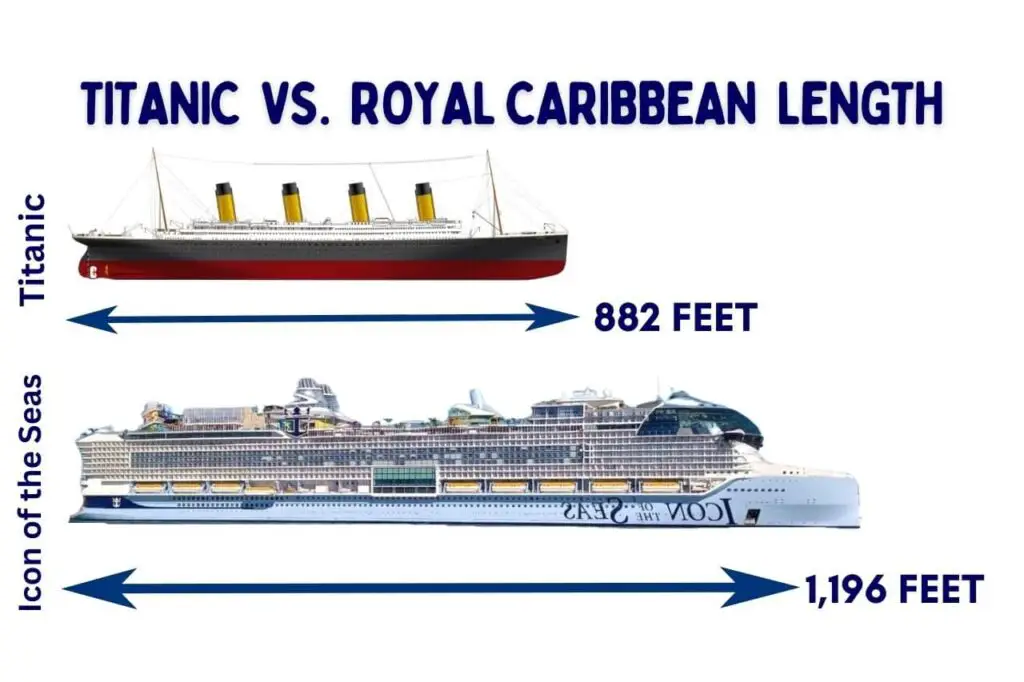
The difference is somewhat smaller when we compare the Titanic with Carnival Cruise Line’s largest ship, the Carnival Jubilee, which reaches 1,130 feet (344 meters) compared to the Titanic’s 882 feet (269 meters).
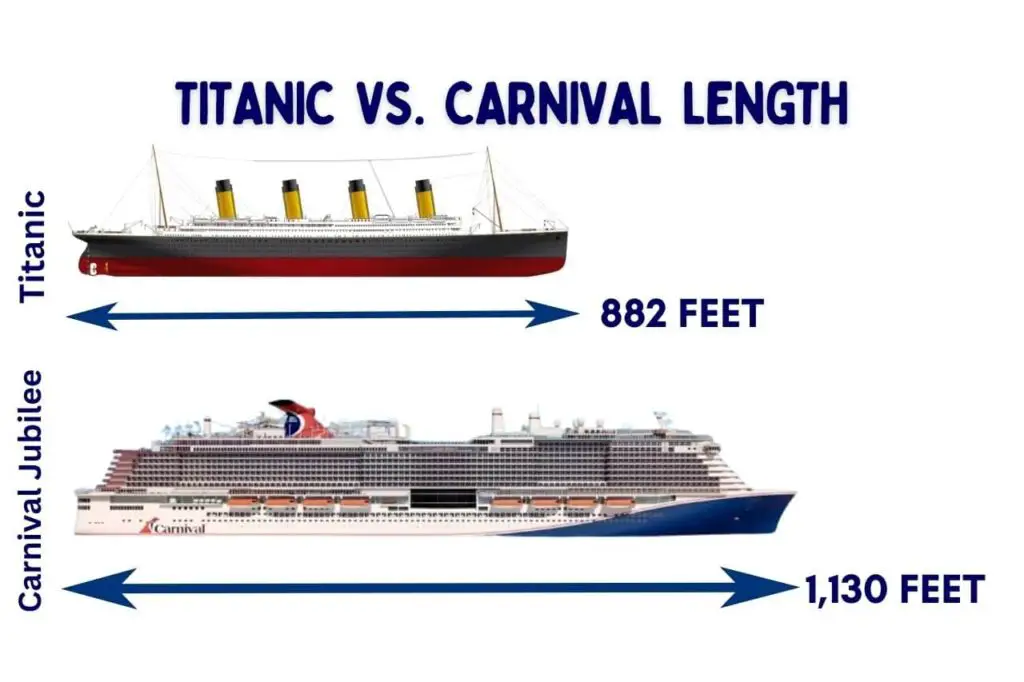
Titanic vs. Cruise: the Gross Tonnage
If we compare gross tonnage, the difference becomes incredibly wide!
Firstly, it’s important to clarify that gross tonnage does not reflect the weight of the ship .
Instead, it measures the volume of all the ship’s enclosed spaces (from keel to funnel), making it the most reliable metric for gauging a ship’s overall size.
The Titanic had a gross tonnage of 46,328 tons , while the gross tonnage of the Icon of the Seas is 248,663 tons . This is essentially more than five times greater!
Such a comparison clearly illustrates how much larger modern ships are compared to the Titanic.
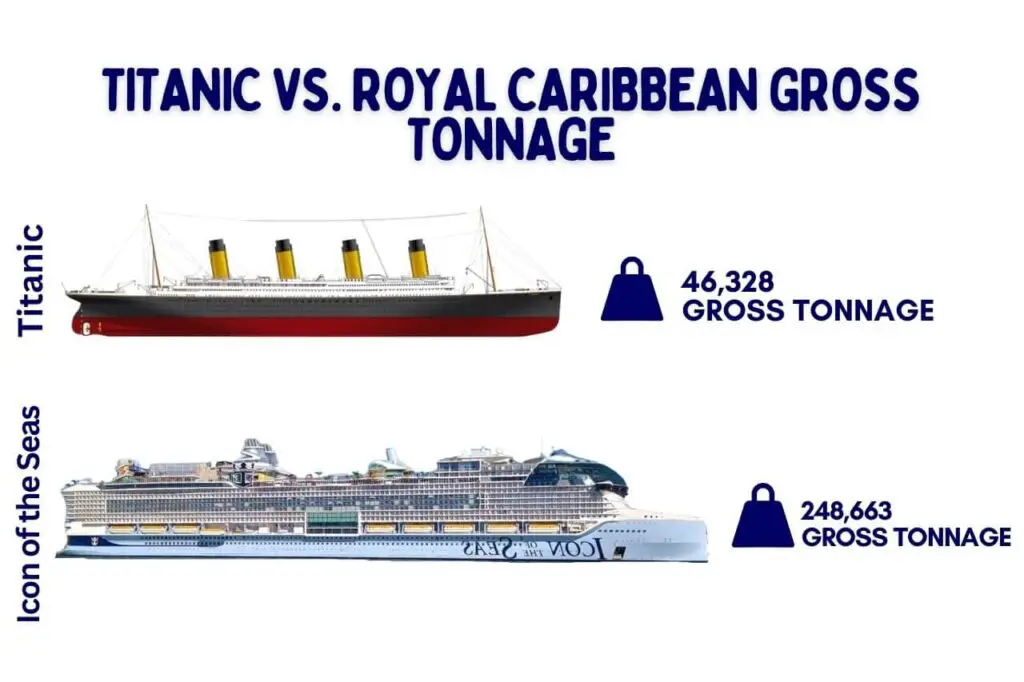
The chart below compares the gross tonnage of the Titanic with that of the Carnival Jubilee.
It highlights that even though Carnival’s ships are generally smaller than Royal Caribbean’s, the disparity in gross tonnage with the Titanic is still remarkably large .
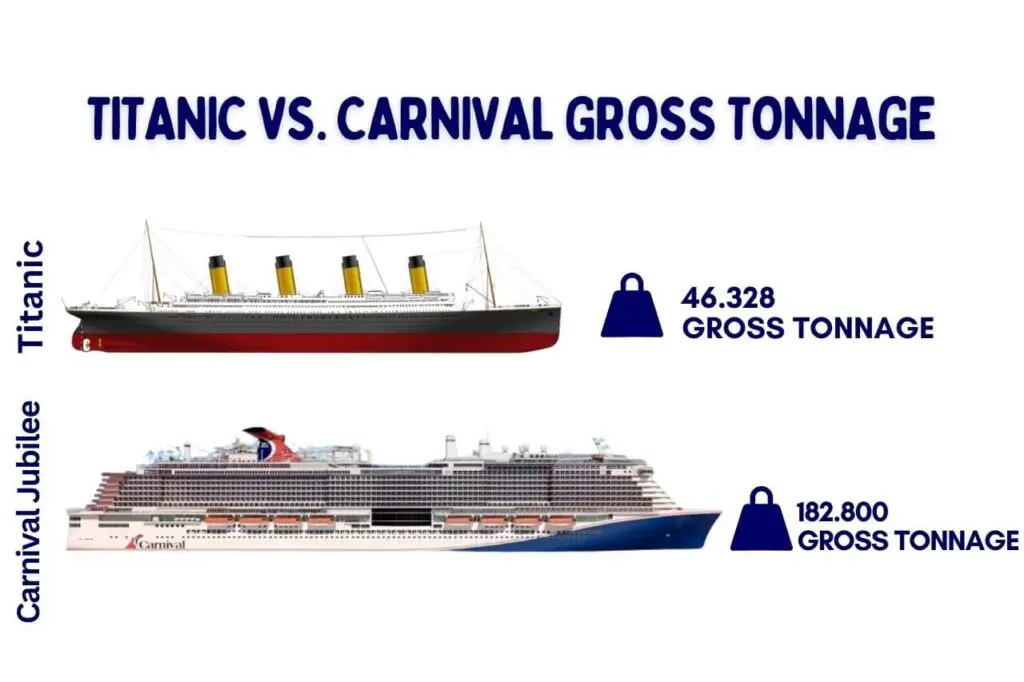
Titanic vs. Cruise: the Height
Let’s now turn our attention to the last variable: height .
Sometimes, the measurements available online can make the Titanic appear quite tall. However, it’s important to consider that her smokestacks are exceptionally high , which can significantly distort the perceived height.
With this in mind, I suggest we focus on comparing the number of decks instead . The Titanic had a total of 10 decks , whereas modern ships often boast as many as 20 decks .
Even here, the difference is stark, with modern ships having more than double the number of decks !
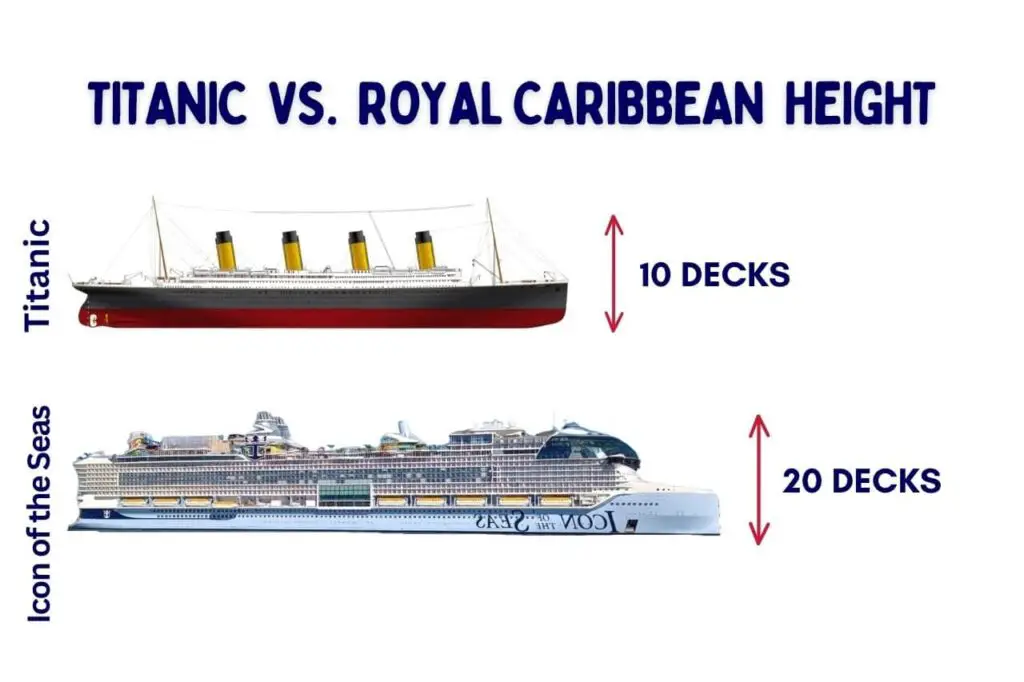
To conclude
The Titanic was considered a large ship in its time and would still be viewed as sizable by today’s standards, more than 100 years later .
However, when compared to modern cruise ships, there’s simply no contest !
Modern cruise ships are often two, three, four, or even five times larger than the Titanic in most respects. You don’t believe it? Then take a look at the list of Carnival cruise ships by size .
Leave a Comment Cancel reply
Save my name, email, and website in this browser for the next time I comment.
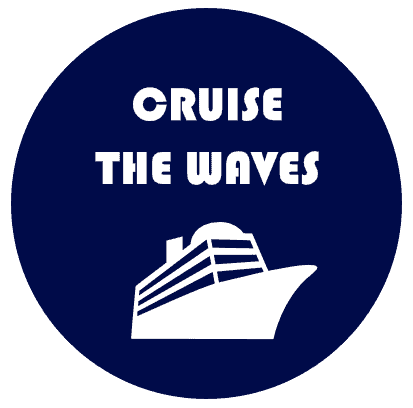
Difference Between Titanic And A Modern Cruise Ship

Today, Royal Caribbean’s Oasis-class ships, such as Wonder of the Seas or Symphony of the Seas, are likely to come to mind when considering the world’s biggest cruise ship. But a decade ago, when the same question would come up, people would automatically think of the Titanic.
In 1912, the RMS Titanic was the world’s biggest cruise ship, making it the most notorious ship of all time. In April 1912, the White Star Liner Titanic set out from Southampton on her first trip and her fatal journey. When it came to luxury ocean liners, the RMS Titanic, which sunk in 1912 on her inaugural flight, was the peak.
Then And Now – An Inch By Inch Comparison Of Titanic And Modern Cruise Ships
But, considering the technology and resources we have today, how does Titanic compare to some of the modern cruise ships we have right now?
We’ve put up a Titanic vs. cruise ship analysis that compares everything from the size and layout to the food and entertainment options to give you a better picture of the ship’s true character.
With a huge size (more on that later,) the ship had the potential to hold thousands of people, including both crew and passengers. But has it been possible for the currently existing cruise ships to match the number or, even better, top it?
Titanic could accommodate 2,435 passengers, an additional 900 crew members, and almost 3,300 passengers. In contrast, the current Symphony of the Seas can accommodate up to 6,780 passengers, which is more than double the capacity of the Titanic.
A mid-size ship could accommodate 1,500 to 2,499 people, which is what the Titanic would be today if it were compared to today’s cruise ships.
So, how much larger was the Titanic than a modern cruise ship? In 2009, the 1,186.5-foot-long Oasis of the Seas debuted on the high seas (361.6 meters). The Oasis-class ships have a total length of about 1,180 feet, equivalent to the Titanic’s total length plus 304 feet. So, compared to a modern cruise ship, the titanic would’ve been disappointingly smaller in size.
There are three ships today in the modern cruise world; the shortest is the Symphony of the Seas, which measures 1,184.42 feet (361.011 m). So technically, the smallest of the three would be larger than Titanic.
A surprising factor about Titanic was its width. With a size of 92 feet and 6 inches, it was considered quite huge back and set a new benchmark for cruise ships until the Queen Mary 2 was introduced in 2004. The latter had a breadth of 148 feet, 55 feet bigger than the Titanic.
Oasis and Allure have a beam more than twice as wide as the Titanic’s at 198 feet (47 meters). The Symphony of the Seas has the widest beam at 215.5 feet (66 meters).
As tall as an 11-story building, the Titanic had nine decks and 175 feet (53.3 m). However, don’t be so surprised yet as the above mentioned both have 18 stories with around 16 of them being used by passengers and rise 236 feet (72 meters) above sea level. The Symphony of the Seas has around 18 decks and 238 feet (72.5 m). To get a better idea, imagine a 22-story building, and you’ve got yourself the size of this mega-ship.

Gross Tonnage Or Weight
Titanic’s gross tonnage of 46,328 was a record for her day, even though it was smaller than most current cruise ships. Compared to the Titanic, this weighs more than 150%. Modern cruise ships, by contrast, have a weight of around 120,000.
The world’s biggest cruise ships have a combined gross tonnage of more than 230,000 tonnes. Thus, the Oasis-class ships of the Royal Caribbean are almost four times as hefty as the Titanic.
This isn’t a surprise to see how cruise ships are becoming larger and bigger. Almost all major cruise lines are now constructing ships larger than anything that has ever been constructed.
Larger cruise ships may operate at reduced costs because of the industry’s focus on productivity.
Entertainment
Today’s cruise ships are essentially resorts on water, with a never-ending supply of things to see and do. For example, the Symphony of the Seas has an aqua theatre, 24 swimming pools, a floating Central Park, 23 eateries, a Flow Rider surfing simulator, waterslides, and much more.
No surf simulators or bouldering walls aboard the Titanic, but plenty of other forms of amusement are more in keeping with the era. Gym equipment included the usual suspects, such as treadmills and stationary cycles, and a few surprises like electric camels and horses that would be familiar to modern cruisers.
Unlike today’s cruise ships, there was just one swimming pool on board. There had been a Turkish bath, a steam room, and a massaging area instead of a spa. So, all in all, it wasn’t all bad, but it certainly lacked in the entertainment department.
Speed And Efficiency
And then, there’s the most important aspect, the speed and efficiency of the monster. It was that Titanic could go up to a maximum speed of 23 knots thanks to its two reciprocating engines. However, any modern cruise ship also comes with two reciprocating engines, but that’s not all. They are supercharged and can reach a maximum speed of 28 knots.
The average speed of today’s cruise ships is 20 knots, with the majority of them reaching a top speed of 30 knots.
Although the Titanic may not seem noteworthy now compared to today’s modern cruise ships, it was the most luxurious and magnificent passenger ship in the world at the time of the tragedy. Today, with the successful adaptation of technology and advanced resources, the ships offer a much more premium experience. From uncountable options n of entertainment to much more sophisticated cabins, the chances are unparalleled.
Leave a Reply Cancel reply
You must be logged in to post a comment.
Cruise the waves designed by Digital Burst Media

Titanic vs a Modern Cruise Ship Fleet – Comparison with Photos!
The Titanic was the largest and most complex cruise ship when she set sail in 1912 but shipbuilding has changed a lot since she set sail.
In this article, we will compare the length, height and tonnage of the Titanic to a variety of modern cruise ships.
Are Modern Cruise Ships Bigger Than The Titanic?
Modern cruise ships are, on average, 20% longer than the Titanic and twice as high. The average Royal Caribbean cruise ship is 325 meters long, 14 decks high and has a gross tonnage of 133,000. In comparison, the Titanic was only 269 meters long, 9 decks high, and had a gross tonnage of 46,000.
The sinking of the Titanic happened over 100 years ago and although she was the largest ship at the time of her launch a lot has changed since. Almost all modern cruise ships are bigger than the Titanic was.

Titanic vs Modern Cruise Ships – Length Comparison
The Titanic was 269 meters long which means that if we were to compare her to the current fleet of Royal Caribbean cruise ships the Titanic would be longer than one ship and shorter than all other ships in the fleet.
The table below shows the Royal Caribbean cruise ship fleet ordered in terms of length with the Titanic in second place.
The graph below shows the length of Titanic in comparison to the Royal Caribbean fleet. It’s interesting to note that although lengths of cruise ships have increased on average cruise ships aren’t much longer than Titanic was.
The process of having to dock and maneuver cruise ships means that although they are able to increase almost exponentially in height the same can’t be said for length. Modern cruise ships still need to be able to dock in ports that are often quite old.

Titanic vs Modern Cruise Ships -Tonnage Comparison
The Titanic had a gross tonnage of 46,000 which is less than all cruise ships in the modern Royal Caribbean cruise ship fleet.
The table below shows Royal Caribbean cruise ships in the order of tonnage with Titanic first as she has the least tonnage. The average tonnage of a Royal Caribbean ship is 133,000 which is almost 3x that of the Titanic.
The below graph shows the comparison between ships. It’s interesting to note that cruise ships have managed to increase their tonnage despite not increasing length a great deal, this is due to the fact that cruise ships have increased in height dramatically.
Building methods and materials have also improved greatly since Titanic was built which allows ships to be built bigger and faster.
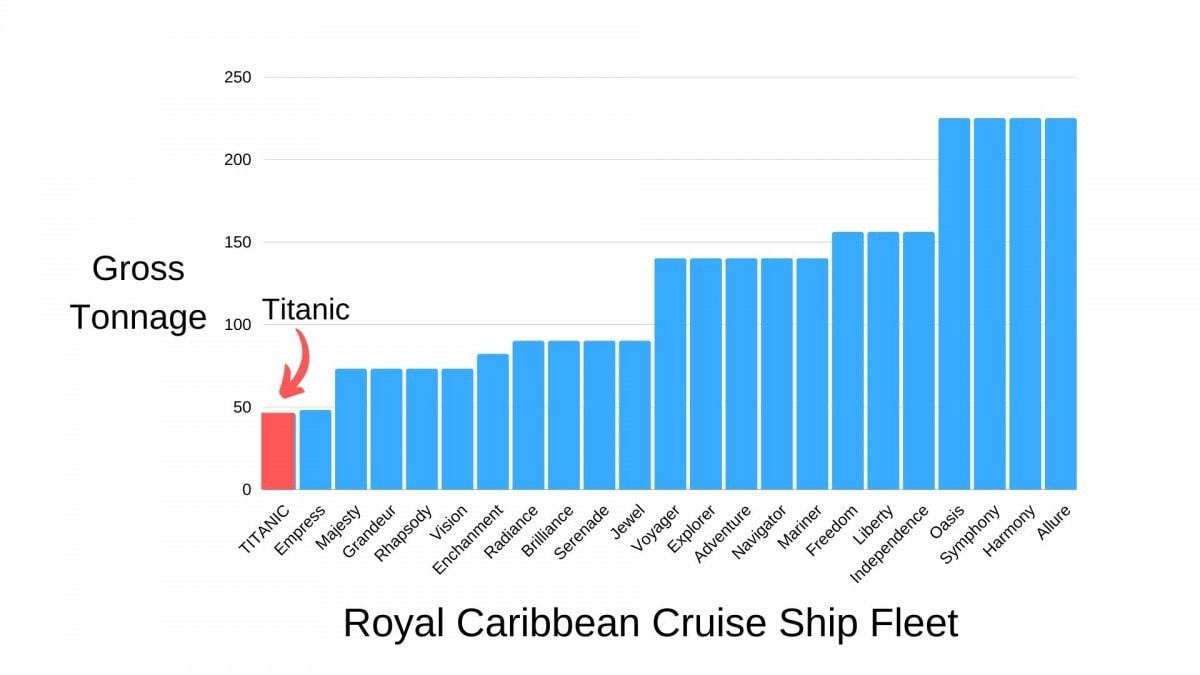
Titanic vs Modern Cruise Ships – Height Comparison
The main way that modern cruise ships are able to be so much larger than the Titanic is because they are so much higher.
The Titanic was built in one piece by riveting large plates together whereas modern cruise ships are built in smaller sections, then loaded into place using large cranes. The modular way that modern cruise ships are built allows them to be built higher faster than using traditional ship building methods.
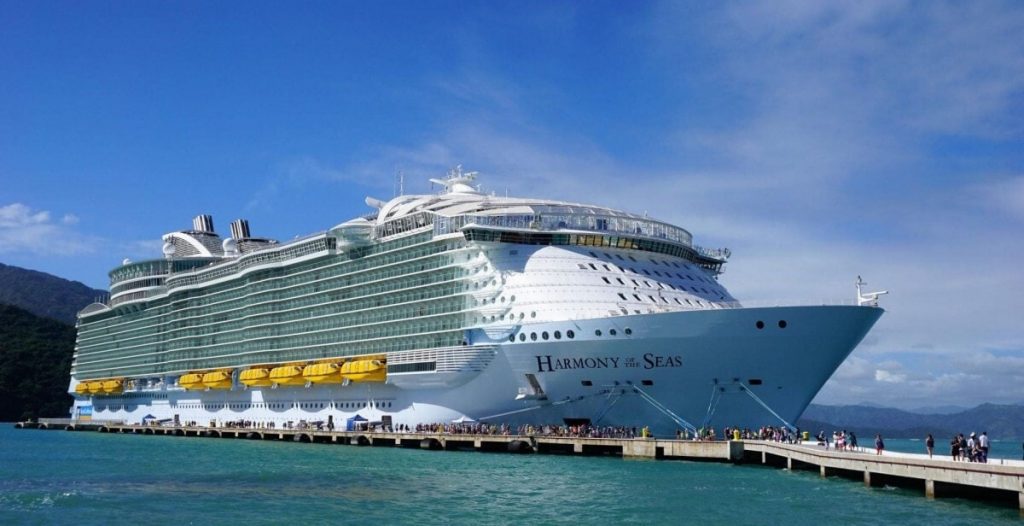
The largest cruise ship for Royal Caribbean has double the number of passenger decks as the Titanic had.
For the purpose of this comparison the decks mentioned are accessible passenger decks, the ships may have more decks which are off limits to guests.
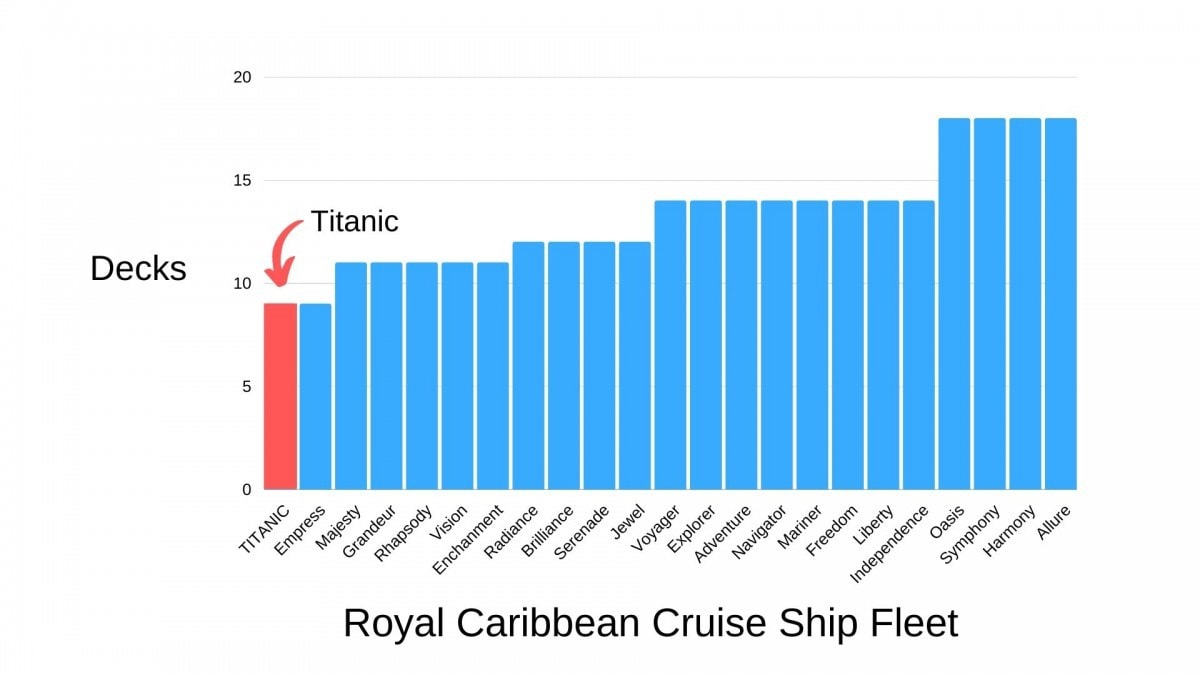
Cunard Fleet Compared to Titanic
Comparing the Titanic to the current Cunard fleet also shows that the Titanic was smaller and lighter than modern Cunard ships.
The same goes for the majority of mainstream cruise lines.
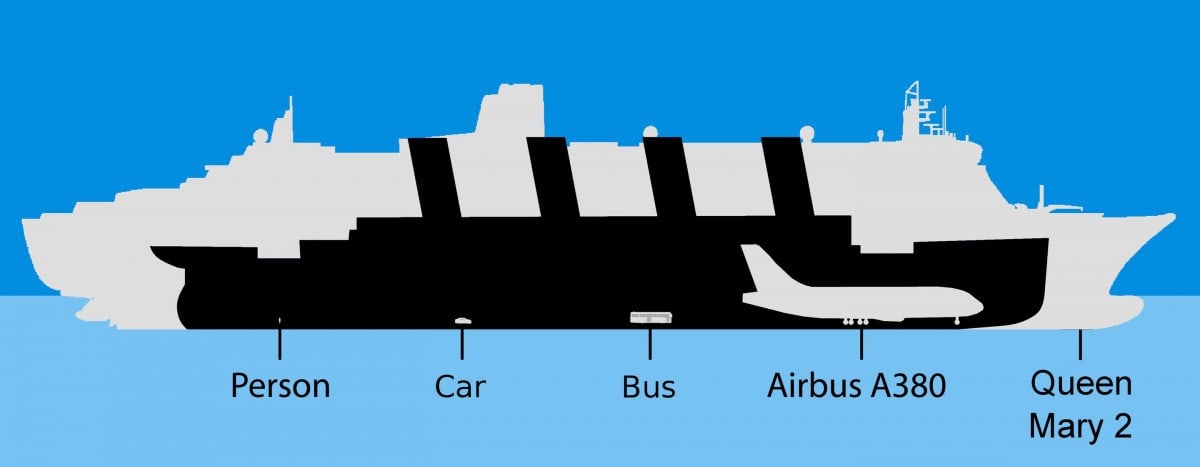
The above diagram shows the Titanic (in black) in comparison to the Queen Mary 2 mentioned above. For reference a person, car, bus and plane are also shown.
Do Modern Cruise Ships Have More Lifeboats Than The Titanic?
The sinking of the Titanic in 1912 brought about many changes, the most famous of which being the number of lifeboats required by a ship. In 1914 The International Convention for the Safety of Life at Sea (SOLAS) was created to provide guidelines that ships must follow.
Modern cruise ships must have the following:
- Enclosed of partially enclosed lifeboats for 50% of the ships capacity on each side (totally 100%).
- Life rafts that hold at least 25% of the ships capacity.
The Titanic actually had space on board to carry many wooden lifeboats but it was decided that only 16 lifeboats and 4 collapsable life rafts would be enough.
Had the maximum amount of wooden lifeboats that the Titanic could hold had been carried there would have been more than enough space for all passengers and crew of the Titanic.
For comparison, the Queen Mary 2 mentioned above has 22 life boats (capacity of 150), 2 rescue boats (capacity of 6) and 60 life rafts each (capacity of 37).
The Titanic Had a Different to Modern Cruise Ships
The Titanic wasn’t ever designed to be a cruise ship, she is an Ocean Liner and there are many differences between the two. To find out more about the differences in design and function, check out the post below:
Cruise Ships vs Ocean Liners – Measurable Differences You Need to Know
When the Titanic sunk she was sailing from Southampton, UK to New York City, USA via Cobh in Ireland. The black circle shown on the picture below is where the Titanic sank.
The Titanic had electricity onboard AND A SWIMMING POOL which was incredible for the time. You can find out more in the posts below.
Inside Titanic’s Swimming Pool – Real Photos, Restrictions, and Design
The Titanic and Electricity – How Did They Generate it and What Was it For?
To Conclude:
Changes in shipbuilding have allowed modern cruise ships to far surpass the height and tonnage of the Titanic. Although some small modern-day cruise ships are a similar size to the Titanic the majority of ships are much larger with some being 3x as large.

Free Insiders Cruise Line Guide
Ever wondered how the mainstream cruise lines compare? Cruise lines won’t tell you this, but I will.
This FREE guide shows you everything you need to know to find your perfect cruise line.
Ocean Liners, They Still Exist: Here’s Everything You Need to Know – Emma Cruises
Tuesday 3rd of November 2020
[…] Modern Cruise Ships vs The Titanic: Illustrated Size Comparison […]
Enter your email address below:

Cruise FAQs
How big is the titanic compared to modern cruise ships.
On the shore, my gaze spans the vast expanse of the ocean, as my mind drifts to a crucial evening over a century ago. The Titanic, a grand vessel deemed unsinkable, met its end in the icy waters beneath. This story has captivated numerous people, including me.
But how does the size of the Titanic compare to the modern cruise ships that grace our seas today?
In this article, we will delve into the astonishing dimensions of the Titanic and explore how it measures up against its contemporary counterparts. From the evolution of cruise ship design to the behind-the-scenes operations and logistics, we will uncover the secrets of these floating behemoths.
Additionally, we will examine the safety and security measures implemented on modern cruise ships, especially in light of recent events such as the impact of COVID-19 on the industry.
Join me on this voyage of discovery, as we navigate through the legacy of the Titanic and witness the remarkable evolution of cruise ship engineering.
Table of Contents
Key Takeaways
- The Titanic was significantly smaller than modern cruise ships, with a length of 882 ft 9 in compared to cruise ships that can be up to 1,188 ft long.
- The Titanic had a capacity of over 2,400 passengers and crew members, while modern cruise ships can accommodate over 6,000 passengers and 2,000 crew members.
- Modern cruise ships offer a wide range of amenities and luxury features, including multiple restaurants, pools, theaters, and shopping malls, which were not available on the Titanic.
- Sustainability and eco-friendly practices are a priority in modern cruise ship design, with advanced propulsion systems, alternative fuels, and reduced emissions being implemented to minimize environmental impact.
The Astonishing Dimensions of the Titanic
You won’t believe the astonishing dimensions of the Titanic, it was way bigger than you can even imagine! This engineering marvel was a true testament to the ambition and skill of its creators.
The Titanic measured an astounding 882 feet and 9 inches long, making it one of the largest ships of its time. It had a width of 92 feet and 6 inches, and a height of 175 feet from keel to the top of its funnels.
The ship weighed a staggering 46,328 tons and could accommodate over 2,400 passengers and crew members. Its sheer size and grandeur were unmatched, making it the epitome of luxury and extravagance.
Transitioning into comparing the Titanic to modern cruise ships, it’s remarkable to see how far we’ve come in terms of size and technology.
Comparing the Titanic to Modern Cruise Ships
When it comes to sizes of ocean liners, one cannot help but marvel at the sheer magnitude of the Titanic in contrast to its contemporary counterparts. The evolution of maritime technology has led to the construction of modern cruise ships that are significantly larger than the Titanic.
Today’s cruise ships can be over three times the length and twice the height of the Titanic. These modern giants can accommodate thousands of passengers and offer a vast array of amenities, from multiple restaurants and pools to theaters and shopping malls.
However, size is not the only factor that sets modern cruise ships apart. The role of luxury has become paramount in the design of these ships, with extravagant suites, gourmet dining options, and world-class spas.
With this in mind, the Titanic’s place in maritime history is truly unparalleled.
The Titanic’s Place in Maritime History
The Titanic’s legacy in maritime history remains unmatched due to its unparalleled role in shaping the future of ocean travel. Its tragic sinking in 1912 not only marked one of the deadliest maritime disasters but also sparked a cultural fascination that continues to captivate people to this day.
Its sheer size, luxurious amenities, and advanced technologies at the time set new standards for the industry. The Titanic’s impact on maritime safety regulations led to significant improvements in ship design and emergency procedures. Its demise served as a wake-up call, prompting the establishment of international organizations like the International Ice Patrol and the International Convention for the Safety of Life at Sea.
As we delve into the subsequent section about the evolution of cruise ship design, it becomes evident that the Titanic’s influence transcends time and continues to shape the industry.
Evolution of Cruise Ship Design
When discussing the evolution of cruise ship design, it’s important to consider the advancements in technology and engineering that have shaped the industry.
From the use of advanced materials to the implementation of sophisticated navigation systems, modern cruise ships are a testament to human ingenuity.
Furthermore, the increase in passenger amenities and entertainment options has transformed the cruising experience, catering to the diverse preferences and desires of travelers.
Lastly, environmental considerations have become a crucial aspect of modern cruise ship design, with a focus on reducing carbon emissions and implementing sustainable practices to protect the delicate ecosystems they visit.
Advancements in Technology and Engineering
With its massive size and cutting-edge technology, modern cruise ships easily dwarf the Titanic. Advancements in propulsion systems have revolutionized the way these ships are powered. The use of diesel-electric engines and gas turbines allows for greater fuel efficiency and reduced emissions compared to the coal-fired engines of the Titanic.
Automation and artificial intelligence have also played a significant role in improving the efficiency and safety of modern cruise ships. From navigational systems to engine control, these advancements have streamlined operations and reduced the reliance on human intervention. This has led to smoother sailing and a lower risk of accidents.
Moving forward, the increase in passenger amenities and entertainment has become a focal point for cruise ship designers. From water parks to Broadway-style shows, modern cruise ships aim to provide a memorable and enjoyable experience for passengers.
Increase in Passenger Amenities and Entertainment
Passenger amenities and entertainment on today’s cruise ships have reached unprecedented levels, creating an unforgettable and enjoyable experience for all. One of the notable advancements in modern cruise ships is the increase in onboard dining options. From upscale restaurants with celebrity chefs to casual buffet-style eateries, cruise ships now offer a wide variety of culinary experiences to cater to every palate.
Additionally, the evolution of onboard entertainment has transformed the cruising experience. Passengers can enjoy Broadway-style shows, live music performances, comedy clubs, and even movie theaters onboard. The availability of these entertainment options ensures that there is never a dull moment during the voyage.
As we transition into the subsequent section about environmental considerations in modern cruise ships, it is important to note that these advancements in passenger amenities and entertainment have been accompanied by a growing awareness of sustainability and eco-friendly practices in the industry.
Environmental Considerations in Modern Cruise Ships
One aspect that cannot be overlooked is the emphasis on eco-friendly practices and sustainability in the cruise industry today. Cruise lines are taking significant green initiatives to minimize their environmental impact. From waste management to energy efficiency, modern cruise ships are designed with the latest technologies to reduce their carbon footprint.
To give you an idea of the environmental considerations in modern cruise ships, let’s take a look at a comparison between the Titanic and a typical modern cruise ship:
These improvements in waste management and energy efficiency demonstrate the commitment of the cruise industry to sustainable practices. This shift towards eco-friendly operations not only benefits the environment but also enhances the overall cruise experience for passengers.
Transitioning into the subsequent section about the largest cruise ships in the world, it is fascinating to see how these environmental considerations have been incorporated alongside advancements in size and amenities.
The Largest Cruise Ships in the World
Imagine yourself standing next to the largest cruise ship in the world, feeling tiny as it towers over you. The construction of these massive vessels is a testament to the technological advancements in cruise ships. These behemoths can stretch up to 1,188 feet long, accommodating over 6,000 passengers and 2,000 crew members.
They boast an impressive array of amenities, including multiple pools, theaters, restaurants, and even ice skating rinks. With a gross tonnage of over 225,000, these ships are truly engineering marvels. Their size allows for stability and comfort, even in rough seas.
As you gaze up at the towering structure, it’s hard to comprehend the sheer scale and complexity of these floating cities. They represent the pinnacle of modern cruise ship design and innovation.
Now, let’s explore what the future holds for these incredible vessels.
The Future of Cruise Ship Design and Innovation
As you stand in awe of these colossal floating wonders, you can’t help but marvel at the boundless possibilities that lie ahead for the future of cruise ship design and innovation.
The future of sustainability in the cruise industry is promising, with cruise lines exploring ways to reduce their environmental impact. Innovative technologies are being developed to harness renewable energy sources, such as solar and wind power, to propel these massive vessels. Additionally, advanced waste management systems are being implemented to minimize pollution and protect marine life.
The future also holds exciting prospects for passenger comfort and entertainment, with the integration of virtual reality experiences and cutting-edge amenities. As the industry continues to evolve, the future of cruise ship design promises a greener, more immersive, and unforgettable experience for travelers.
Transitioning into the subsequent section about ‘behind the scenes: operations and logistics of modern cruise ships,’ we delve into the intricate workings that make these magnificent ships operate seamlessly.
Behind the Scenes: Operations and Logistics of Modern Cruise Ships
Operating and managing the intricate workings of these floating marvels requires a well-coordinated team, ensuring smooth logistics throughout the entire journey. To demonstrate the complexity of operations efficiency and crew management, let’s take a look at a 3×3 table highlighting key aspects:
Efficiency in these areas directly impacts the overall experience for passengers. From ensuring prompt service to maintaining a variety of dining options, the crew’s ability to manage these operations is crucial. As we delve into the topic of safety and security measures on modern cruise ships, it is important to note that these aspects are closely intertwined, with efficient operations providing a solid foundation for ensuring a safe and secure environment for all on board.
Safety and Security Measures on Modern Cruise Ships
When it comes to safety and security on modern cruise ships, there are three key points to consider.
Firstly, emergency response and evacuation procedures are meticulously planned and practiced to ensure the safety of all passengers and crew members in the event of an emergency.
Secondly, surveillance and security systems are in place throughout the ship to monitor and prevent any unauthorized activities or potential threats.
Lastly, modern cruise ships comply with strict international regulations to ensure that they meet the highest standards of safety and security.
These measures combine to create a safe and secure environment for everyone on board.
Emergency Response and Evacuation Procedures
To ensure your safety during an emergency, it’s crucial to familiarize yourself with the evacuation procedures on modern cruise ships, especially when it comes to the Titanic’s size comparison.
Modern cruise ships are equipped with state-of-the-art emergency response training and procedures to handle any potential crisis. Crew members undergo rigorous training to ensure they’re well-prepared to handle emergency situations and efficiently guide passengers to safety.
Additionally, modern cruise ships have advanced surveillance systems and passenger accountability measures in place to quickly locate and assist individuals during an evacuation. These systems help ensure that every passenger is accounted for and no one’s left behind.
Understanding and following these evacuation procedures is essential for a safe and efficient evacuation process in the event of an emergency.
Transitioning into the subsequent section about surveillance and security systems, it’s important to note that these measures are just one part of the comprehensive safety and security protocols on modern cruise ships.
Surveillance and Security Systems
Passenger safety is ensured through advanced surveillance and security systems on board. These state-of-the-art surveillance technologies play a crucial role in maintaining a secure environment for all passengers.
Here are three key components of the surveillance and security systems on modern cruise ships:
CCTV Cameras: Numerous closed-circuit television cameras are strategically placed throughout the ship, monitoring public areas, corridors, and entry points. This comprehensive coverage allows for real-time monitoring and swift response to any suspicious activities.
Access Control Systems: Advanced security protocols are in place to control access to different areas of the ship. From keycards to biometric scanners, these systems ensure that only authorized individuals can enter restricted areas, enhancing overall safety.
Emergency Response Teams: Trained security personnel are stationed on board, ready to respond to any security threats or emergencies. They undergo rigorous training and are equipped with the necessary tools to handle various situations effectively.
With these surveillance technologies and security protocols in place, cruise ships comply with international regulations, providing passengers with a safe and secure environment throughout their voyage.
Compliance with International Regulations
For your safety, it’s crucial that cruise ships adhere to international regulations like a well-oiled machine, ensuring a smooth and secure voyage. These regulations encompass a wide range of safety measures that are designed to protect passengers, crew members, and the environment.
From the International Convention for the Safety of Life at Sea (SOLAS) to the International Maritime Organization (IMO) guidelines, these regulations set the standards for everything from emergency procedures to fire safety, navigation, and pollution prevention.
Cruise ships must undergo rigorous inspections to ensure compliance, including regular safety drills and audits. By adhering to these international regulations, cruise ships demonstrate their commitment to providing a safe and secure experience for everyone on board.
Transitioning into the subsequent section about the impact of COVID-19 on the cruise industry, it is important to consider how these regulations have been further strengthened in response to the pandemic.
The Impact of COVID-19 on the Cruise Industry
Amidst the COVID-19 pandemic, the cruise industry has suffered a significant blow, leaving many wondering about its future. The impact of quarantine measures has been immense, with cruise ships being quarantined due to outbreaks on board. This has not only led to a negative perception of the industry but has also resulted in a massive decline in bookings and revenue. The economic implications are staggering, with cruise lines reporting billions of dollars in losses and struggling to stay afloat.
Travel restrictions and lockdowns have prevented cruise ships from operating, resulting in empty ports and deserted ships.
The cancellation of cruises has not only affected the cruise lines themselves but also the countless businesses that rely on the industry, such as hotels, restaurants, and local tour operators.
The future of the cruise industry remains uncertain, with experts predicting a slow recovery as travelers prioritize safety and opt for alternative vacation options.
In conclusion, the COVID-19 pandemic has had a devastating impact on the cruise industry, causing widespread economic implications and uncertainty for its future.
Now let’s delve into the legacy of the Titanic and how cruise ships have evolved since then.
Conclusion: The Titanic’s Legacy and the Evolution of Cruise Ships
As I reflect on the legacy of the Titanic and the remarkable evolution of ocean liners, it’s fascinating to see how these majestic vessels have transformed over the years. The Titanic, once considered the epitome of luxury and size, now pales in comparison to modern cruise ships.
Today’s cruise ships are not only much larger, but they also boast a wide range of amenities and features that were unimaginable during the time of the Titanic. From multiple restaurants and bars, to sprawling water parks and theaters, modern cruise ships offer a plethora of entertainment options for passengers.
Furthermore, future trends in cruise ship design are focused on sustainability and eco-friendliness, with the incorporation of advanced technologies to reduce fuel consumption and minimize environmental impact.
The legacy of the Titanic lives on as a symbol of the past, while modern cruise ships continue to push the boundaries of innovation and luxury.
Frequently Asked Questions
How many passengers and crew members were aboard the titanic.
There were a total of 20 lifeboats on the Titanic, which could accommodate approximately 1,178 people. In terms of passengers and crew members, there were approximately 2,224 individuals on board the Titanic.

What was the cost of building the Titanic?
The cost of building the Titanic was approximately $7.5 million, and it took about 3 years to construct. It was an expensive and time-consuming project, but the result was a magnificent and luxurious ship.
Did the Titanic have any sister ships?
The Titanic had two sister ships, the RMS Olympic and the HMHS Britannic. The Titanic’s legacy includes a major impact on maritime safety and the lessons learned from its tragic disaster.
How long did it take to build the Titanic?
The Titanic took approximately 2 years and 3 months to build. The construction process began on March 31, 1909, and the ship was completed on May 31, 1911.
How many lifeboats were on the Titanic and how many people did they accommodate?
The Titanic had a total of 20 lifeboats, each with a capacity of around 65 people. Their design was based on regulations at the time, which didn’t require enough lifeboats for all passengers.
In conclusion, the Titanic’s legacy looms large in maritime history, forever etched in our collective memory. As I reflect on the astonishing dimensions of this iconic ship, I can’t help but marvel at how far cruise ship design has come.
From the Titanic’s majestic presence to the behemoths of today, modern cruise ships have undergone a remarkable evolution. They have become floating cities, with advanced operations, stringent safety measures, and intricate logistics.
However, amidst all the progress, one cannot help but feel a sense of awe for the Titanic’s tragic fate, a reminder of the fragility and resilience of human endeavors.

Meet Asra, a talented and adventurous writer who infuses her passion for exploration into every word she writes. Asra’s love for storytelling and her insatiable curiosity about the world make her an invaluable asset to the Voyager Info team.
From a young age, Asra was drawn to the power of words and their ability to transport readers to far-off lands and magical realms. Her fascination with travel and cultures from around the globe fueled her desire to become a travel writer, and she set out on a journey to turn her dreams into reality.
How Long Can You Cruise On Testosterone
What Is The Royal Gathering On Disney Cruise

Meet Asra, a talented and adventurous writer who infuses her passion for exploration into every word she writes. Asra’s love for storytelling and her insatiable curiosity about the world make her an invaluable asset to the Voyager Info team. From a young age, Asra was drawn to the power of words and their ability to transport readers to far-off lands and magical realms. Her fascination with travel and cultures from around the globe fueled her desire to become a travel writer, and she set out on a journey to turn her dreams into reality.

You may like
What makes luxury river cruising on tauck inspire unforgettable?.
Uncover the secrets behind Tauck's ability to create unforgettable luxury river cruise experiences that linger long after the journey ends.
When you step aboard a Tauck luxury river cruise, you'll discover a world where unparalleled service, curated experiences, and cultural immersion seamlessly intertwine. The blend of exquisite attention to detail and a deep understanding of what truly makes a journey unforgettable sets Tauck apart.
But what exactly is it that transforms a river cruise into a lifelong memory? Let's uncover the secrets behind Tauck's ability to create truly inspiring and unforgettable experiences that linger long after the journey ends.
- Opulent accommodations and personalized service ensure a luxurious experience.
- Unforgettable experiences include exclusive gala dinners and cultural insights.
- Attention to detail and exceeding expectations create a worry-free journey.
- The essence of Joie De Vivre in France is captured through unique, curated experiences.
Luxurious Accommodations and Personalized Service
Embark on a journey of luxury and personalized pampering with Tauck's river cruises, where opulent accommodations and attentive service await. Tauck ensures a lavish experience with 400-thread satin bed linen and indulgent Molton Brown bath products in every cabin.
For those seeking extra space and comfort, the spacious 300-square-foot Tauck Suites offer roomy walk-in closets and ample bathrooms. What truly sets Tauck apart is their exceptional staff-to-guest ratio, guaranteeing personalized service that exceeds expectations.
The Cruise Directors onboard provide expert knowledge, personalized attention, and enhance the overall cruise experience with their dedication to ensuring every guest feels valued and catered to. Attention to detail is the hallmark of Tauck's service, ensuring that every aspect of your stay is meticulously taken care of, from the luxurious accommodations to the personalized service provided by the attentive staff.
With Tauck, every moment is crafted with precision and care, promising a truly unforgettable river cruising experience.
Unforgettable Experiences and Unique Amenities
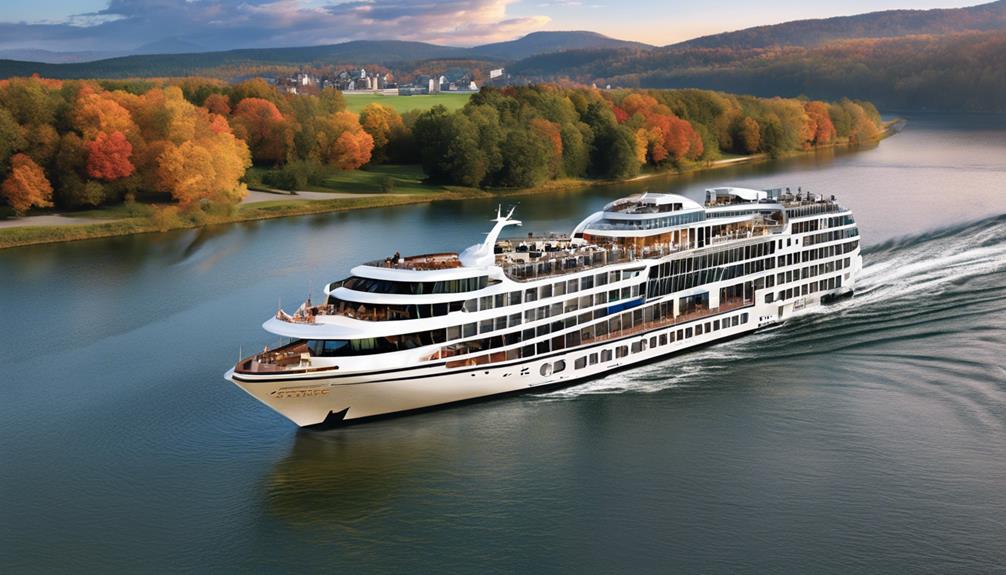
Indulge in captivating and exclusive experiences on Tauck's luxury river cruises, where guests are treated to unforgettable moments and unique amenities. Tauck goes beyond traditional cruising by offering guests the opportunity to partake in exclusive gala dinners held in private palaces and castles, creating unforgettable evening events that leave a lasting impression.
Wine tastings at private vineyards and unique music performances in inspiring venues further enhance the journey, providing immersive experiences that showcase the best of each destination. Cultural insights are woven into every aspect of the cruise, with interactions with local artisans, historians, and experts fostering connections and enriching the overall experience.
From truffle hunting in the Rhône Valley to exclusive events at historic landmarks, Tauck ensures personalized experiences that highlight the cultural treasures of each region, including music, art, and culinary delights. These carefully curated activities ensure that guests not only see the destinations but truly experience them in a meaningful and unforgettable way.
Attention to Detail and Exceeding Expectations
Tauck's meticulous attention to detail and commitment to exceeding expectations shine through in every corner of their luxury river cruises. From the moment guests step into their Tauck Suite, they're enveloped in a world of luxurious amenities. The 400-thread satin bed linen and Molton Brown bath products are just the beginning. The roomy walk-in closets and spacious bathrooms in the suites are designed to surpass expectations, ensuring a truly indulgent experience.
What truly sets Tauck apart is their exceptional customer service. Their staff anticipates every need, going above and beyond to provide convenience at every turn. Airport transfers are offered even if guests haven't booked airfare through Tauck, eliminating any worries about logistics. Tauck's commitment to nickel-and-diming elimination ensures a worry-free experience, where every detail is taken care of without any extra costs.
At Tauck, exceeding expectations isn't just a goal – it's a way of life. The core value of 'Always do the right thing' permeates every interaction, creating a level of service that builds lasting relationships based on trust and quality.
The Essence of Joie De Vivre in France
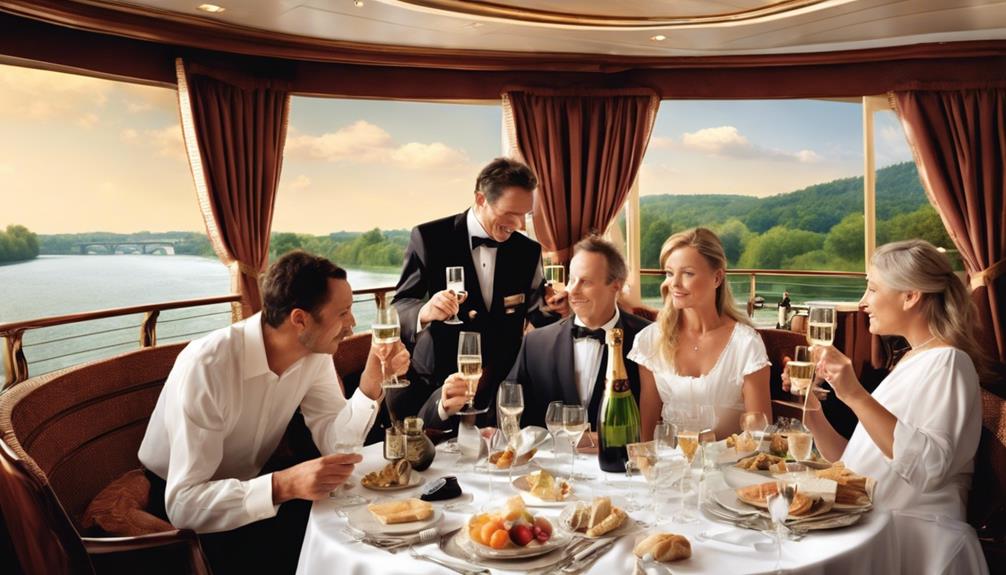
Immerse yourself in the vibrant essence of 'Joie De Vivre' as you journey through the heart of France with exclusive access to its historic castles, chteaux, and hidden gems.
- Gala Evenings: Step into the grandeur of France's past with exclusive gala evenings at historic castles and chteaux, where you'll be swept away by the elegance and charm of these magnificent settings.
- French Heritage: Delve deep into French heritage as you explore iconic attractions like Monet's Giverny, where the beauty of the gardens and the artist's home will transport you to another time, inspiring a deep appreciation for the country's artistic legacy.
- Off-the-Beaten-Path Locations: Venture off the tourist trail and uncover hidden gems in France, guided by Tauck's expertise and access to unique locations that offer a glimpse into the authentic cultural heritage of the country, creating moments of pure enchantment and discovery.
Exclusive Tauck River Cruise Experiences
Embark on a luxurious journey along the rivers of Europe with Tauck, where exclusive experiences await to elevate your travel adventures to new heights. Tauck offers unique gala evenings at historic castles and châteaux, providing an unforgettable and sophisticated ambiance.
Immerse yourself in the richness of cultural treasures with private visits to attractions like Monet's Giverny, uncovering hidden gems that will leave you in awe. Delve into the heart of French heritage through personalized events meticulously arranged by Tauck, ensuring an authentic and immersive experience.
These exclusive encounters not only create unforgettable memories but also offer insight into the essence of each destination. Tauck's commitment to curating personalized experiences sets them apart in the world of luxury river cruising, where every moment is designed to leave a lasting impression.
Prepare to indulge in a journey filled with unparalleled moments and exclusive access, making your Tauck river cruise a truly exceptional and unforgettable adventure.
Is Tauck High End?
Yes, Tauck is high end. They offer luxurious amenities like 400-thread satin bed linen and Molton Brown bath products. Their spacious Tauck Suites provide more room per guest. Partnering with Scylla, they ensure quality and innovation in river cruising, creating unforgettable experiences.
What Is a Tauck River Cruise Like?
A Tauck river cruise is a luxurious journey filled with elegant accommodations, scenic views in the Panorama Lounge & Bar, onboard activities like a putting green and Jacuzzi, and delightful dining experiences. It's a captivating blend of relaxation and indulgence.
Is Alcohol Included on Tauck River Cruises?
Yes, alcohol is included on Tauck river cruises. Guests can savor complimentary wines, beers, and spirits at meals and the bar. Premium cocktails enhance the luxury experience. It's hassle-free with no extra charges, providing a seamless and indulgent journey.
Are River Cruises for Older People?
River cruises offer a relaxed and culturally enriching experience, appealing to mature travelers. While they cater to older individuals seeking sophistication, they welcome all ages looking for refined and unhurried exploration.
In conclusion, luxury river cruising on Tauck is like experiencing a symphony of unforgettable moments orchestrated with precision and elegance.
From the personalized service to the exclusive experiences, every detail is carefully crafted to create a journey that resonates with the essence of luxury travel.
Tauck's commitment to excellence and unique offerings truly elevate the river cruising experience to new heights, leaving guests with memories that will last a lifetime.

Claire, a creative soul with an unquenchable thirst for storytelling, is an integral part of the Voyager Info team. As a dedicated writer, she weaves captivating narratives that transport readers to enchanting cruise destinations and beyond.
Claire’s love affair with writing began at an early age when she discovered the magic of words and their ability to craft worlds and emotions. Her innate curiosity led her to explore various literary genres, but it was travel writing that truly captured her heart. Drawing inspiration from her own globetrotting adventures and encounters with diverse cultures, Claire embarked on a journey to become a travel writer par excellence.
What Happens If You Don’t Pay Your Cruise By The Due Date

Did you know that over 20% of cruise passengers fail to pay for their cruise on schedule? This surprising statistic points to a situation that could have serious consequences.
As a travel writer, I aim to inform and educate you about what happens if you don’t pay your cruise by the due date. It’s not just a matter of a missed vacation; there can be financial penalties, legal actions, and even impacts on your future travel plans.
In this article, I will delve into the potential consequences of late payment, explore options for financial assistance, and discuss how it can affect your relationship with the cruise line and travel agent. I’ll also provide tips on financial planning and budgeting to avoid this situation in the future.
So, let’s dive in and learn about the importance of taking responsibility for your cruise payment.
- Late payment of a cruise can result in financial penalties, legal actions, and negative impacts on credit scores.
- Failure to pay on time can lead to the cancellation of the reservation and limited availability for future cruises.
- Communication with the cruise line is essential, as they may offer financial aid programs, payment plans, or rebooking options to address financial difficulties.
- Understanding the specific terms and conditions of the cruise line is important to avoid missed promotions, increased costs, and a strained relationship with the cruise line.
Consequences of Late Payment
If you don’t pay your cruise by the due date, you’ll face some serious consequences that will definitely ruin your vacation plans. Not only will it impact your credit, but there may also be potential penalties.
The cruise line may charge you late fees or cancel your reservation altogether. They could even take legal action to recover the money owed. Imagine the disappointment of missing out on the adventure you’ve been eagerly anticipating.
It’s essential to communicate with the cruise line as soon as possible if you’re facing financial difficulties. They may be willing to work out a payment plan or offer some flexibility. By reaching out and explaining your situation, you might be able to avoid further complications.
So, let’s talk about how to effectively communicate with the cruise line.
Communication with Cruise Line
Make sure to communicate with the cruise line about any payment delays before the deadline. It’s important to inform them if you’re facing financial hardship that may prevent you from making the payment on time.
Most cruise lines understand that unforeseen circumstances can arise, and they may be willing to work with you to find a solution. They may offer a payment extension or provide alternative options to help you meet your financial obligations.
However, it’s crucial to remember that each cruise line has its own policies and procedures regarding late payments, so it’s best to reach out to them as soon as possible.
By proactively communicating your situation, you can potentially avoid any penalties or legal actions that may result from not paying on time.
Now, let’s explore the available financial assistance options.
Financial Assistance Options
Explore the various financial assistance options available to help you meet your cruise payment obligations on time. If you find yourself in a situation where you’re unable to pay for your cruise by the due date, there are a few options to consider.
Financial Aid: Some cruise lines offer financial aid programs to assist passengers in need. These programs may provide partial or full payment assistance, depending on your circumstances. It’s worth contacting the cruise line directly to inquire about any available assistance.
Payment Plans: Many cruise lines offer flexible payment plans that allow you to spread out the cost of your cruise over several months. This can help alleviate the burden of making a lump sum payment by the due date. Check with the cruise line to see if they offer payment plans and what the terms and conditions are.
Third-Party Financing: In some cases, you may be able to secure a personal loan or use a credit card with a low-interest rate to finance your cruise payment. This option should be approached with caution, as it may result in additional interest charges.
Remember, it’s important to explore all available options and communicate with the cruise line to find a solution that works best for you. If you’re unable to make the payment by the due date, the consequences may include penalties, cancellation of your reservation, or even legal actions.
Now, let’s discuss rebooking or rescheduling options.
Rebooking or Rescheduling Options
If you find yourself unable to pay for your cruise by the due date, there are rebooking or rescheduling options available to you. These options include the availability of future cruises, change fees and policies, and flexibility with dates and itineraries.
Future cruises may have limited availability, so it’s important to act quickly and secure your spot. Change fees and policies vary depending on the cruise line, so it’s important to familiarize yourself with the specific terms and conditions.
Lastly, flexibility with dates and itineraries can provide you with alternative options that may better suit your needs. It’s recommended to contact the cruise line directly to discuss your rebooking or rescheduling options.
Availability of Future Cruises
Don’t bother dreaming about all the amazing future cruises you’ll be missing out on if you don’t pay your cruise by the due date. The consequences of not paying for a cruise on time can have serious financial repercussions.
Here are some key points to consider:
Financial Consequences: Not paying your cruise on time can result in penalties, such as late fees or cancellation charges. These can add up quickly and impact your overall trip budget.
Credit Score Impact: Failing to pay your cruise can also have a negative effect on your credit score. Late or missed payments can be reported to credit bureaus, potentially leading to a lower credit score and difficulty obtaining future loans or credit.
Legal Actions: In extreme cases, cruise lines may take legal action against passengers who fail to pay for their cruises. This can result in further financial consequences and legal complications.
Limited Availability: If you don’t pay for your cruise by the due date, your reservation may be cancelled, and the cabin may become available for other passengers to book.
Now let’s delve into the next section about change fees and policies.
Change Fees and Policies
While the availability of future cruises is undoubtedly impacted if you don’t pay by the due date, it’s also important to consider the change fees and policies that come into play.
Cruise lines typically have their own set of rules regarding payment options and penalties for late payments. These change fees can vary depending on the cruise line and the specific circumstances. Some cruise lines may charge a flat fee, while others may charge a percentage of the total fare. Additionally, certain cruise lines may have stricter policies and penalties than others.
It’s crucial to familiarize yourself with the specific terms and conditions of your chosen cruise line to understand the potential consequences of not paying on time.
Now, let’s explore the flexibility with dates and itineraries that some cruise lines offer.
Flexibility with Dates and Itineraries
Explore the exciting world of cruise line flexibility, where you can immerse yourself in a dreamy vacation without worrying about rigid dates and itineraries. Cruise lines understand that life can be unpredictable, so they offer options to accommodate changes in your plans.
Here are three ways you can enjoy flexibility with dates and itineraries:
Change your departure date: If something unexpected comes up, you can often reschedule your cruise without penalty. Check with your cruise line for their specific policies and any applicable fees.
Choose a different itinerary: Maybe you’ve always wanted to visit a different destination or explore new ports of call. With flexible options, you can easily switch to another itinerary that suits your preferences.
Take advantage of refund policies: In some cases, if you can’t make it on your scheduled cruise, you may be eligible for a refund. Again, be sure to review the refund policy of your cruise line for more details.
With these flexibility options and a generous refund policy, cruise lines make it easier for you to plan your dream vacation. However, if you don’t pay for your cruise by the due date, it can have consequences that impact your future travel plans.
Impact on Future Travel Plans
If you don’t pay for your cruise by the due date, it can have a significant impact on your future travel plans.
Firstly, your relationship with the cruise line may be strained, as they may view you as unreliable and less likely to book with them in the future.
Secondly, you may encounter potential difficulties in booking future cruises, as the cruise line may require you to pay in full upfront or impose stricter payment terms.
Lastly, not paying for your cruise on time can also affect your reputation and referral concerns, as other travelers may hesitate to recommend you or travel with you due to your past payment issues.
Relationship with Cruise Line
Don’t forget to pay your cruise by the due date, or you could risk damaging your relationship with the cruise line and potentially losing out on future opportunities to sail with them. In fact, statistics show that 25% of customers who fail to pay on time are denied future bookings.
Here are some financial consequences and customer service experiences you may face if you don’t pay on time:
- Late payment fees can quickly add up, increasing the overall cost of your cruise.
- Your reservation may be canceled, leaving you without a vacation and potentially losing your deposit.
- The cruise line may take legal action to recover the unpaid amount, resulting in additional fees and potential damage to your credit score.
- Your customer service experience may suffer, as the cruise line may be less willing to accommodate special requests or provide excellent service to customers with a history of late payments.
- You may miss out on exclusive promotions and discounts offered to loyal customers.
Not paying your cruise on time can have long-lasting consequences, making it potentially difficult to book future cruises.
Potential Difficulty in Booking Future Cruises
Booking future cruises may become challenging if you fail to pay your cruise on time. Not only can it lead to communication challenges with the cruise line, but it may also have implications for your credit score.
When you don’t pay your cruise by the due date, the cruise line may view you as a risky customer and may be hesitant to book future cruises with you. They rely on timely payments to ensure the financial stability of their business. Additionally, if your non-payment leads to legal action or collection efforts, it can negatively impact your credit score. This can make it difficult for you to secure loans or credit in the future.
It’s important to understand the consequences of not paying for your cruise on time and to communicate with the cruise line if you’re experiencing financial difficulties. Failure to do so can have long-lasting effects on your ability to enjoy future cruises.
Transitioning into the next section, reputation and referral concerns are also important to consider.
Reputation and Referral Concerns
To maintain a positive reputation and receive valuable referrals, it’s crucial to prioritize timely payments for your cruise and communicate any financial difficulties with the cruise line. Failure to pay for your cruise by the due date can have serious consequences for your reputation and potential future bookings.
Here are four reasons why timely payment is important:
Reputation Management: A missed payment reflects poorly on your reliability and financial responsibility, potentially damaging your reputation among cruise lines and fellow travelers.
Customer Satisfaction: Prompt payment ensures a smooth and enjoyable experience for all passengers, contributing to a positive overall cruise experience.
Referral Potential: Satisfied customers are more likely to recommend your cruise line to others, boosting your chances of receiving valuable referrals.
Preferred Customer Status: Regular and timely payments may lead to special perks, discounts, or upgrades, enhancing your future cruise experiences.
Failing to pay on time may result in legal consequences, which will be discussed in the subsequent section.
Legal Consequences
When it comes to not paying for a cruise by the due date, there are important contractual obligations to consider. If payment isn’t made on time, the cruise line may take potential legal action against you.
In some cases, collection agencies may get involved to recover the outstanding debt. It’s crucial to understand the potential consequences and penalties of not meeting your financial obligations to avoid any unwanted legal complications.
Contractual Obligations
Failure to pay your cruise by the due date may result in a breach of contract. When this happens, there are consequences that you should be aware of.
Firstly, the cruise line may impose penalties, such as cancellation fees or loss of any deposits made. These penalties can vary depending on the cruise line and the specific terms of the contract.
Secondly, you may also lose any assistance options that were included in the package, such as travel insurance or the ability to reschedule your trip. It is important to carefully read and understand the terms and conditions of your cruise contract to avoid any surprises.
Not paying on time may also lead to potential legal action being taken by the cruise line. Remember, it’s always best to fulfill your contractual obligations to avoid any complications or additional expenses.
Potential Legal Action
If you neglect your payment obligations, be prepared for the cruise line to potentially take legal action against you. Here are four things to consider about the potential legal repercussions and liabilities of not paying for your cruise on time:
Penalties: When you miss the payment due date, the cruise line may impose penalties, such as late fees or cancellation charges. These additional costs can quickly add up and impact your overall travel budget.
Lawsuits: In more severe cases, the cruise line may file a lawsuit against you to recover the unpaid amount. This legal action could result in further financial consequences and damage to your credit score.
Debt collection: The cruise line may engage a collection agency to recover the outstanding amount on their behalf. This involvement can be stressful and may negatively affect your credit history, making it harder to obtain credit in the future.
Legal implications: Failure to pay for your cruise can lead to legal issues, including judgments, liens, or even wage garnishment. It’s crucial to understand and fulfill your contractual obligations to avoid these potential legal liabilities.
In the next section, we’ll explore the involvement of collection agencies in more detail.
Collection Agency Involvement
With collection agencies involved, it’s important to be aware of the potential consequences of not meeting your payment obligations for your cruise. If you fail to pay for your cruise by the due date, the cruise line may turn to a collection agency to recover the unpaid debt.
Dealing with collection agencies can have serious implications for your credit score and financial well-being. They have the power to report the unpaid debt to credit bureaus, which can negatively impact your creditworthiness and make it difficult to secure future loans or credit. Additionally, collection agencies may resort to aggressive tactics to collect the debt, such as constant phone calls and letters.
It’s crucial to address the situation promptly and communicate with the collection agency to explore possible solutions. Failing to do so can lead to further complications and stress.
As we move into the next section about communication with your travel agent, it’s important to consider the potential consequences of not resolving the unpaid debt with the collection agency.
Communication with Travel Agent
Despite the urgency of the situation, it’s important to stay in touch with your travel agent regarding payment for your cruise. They can provide valuable information about payment options and potential penalties for late payment.
Travel agents are typically available through various communication methods, such as phone, email, or even online chat. It’s crucial to reach out to them as soon as possible to discuss your payment situation and any potential solutions. They may be able to offer extensions or alternative payment plans to help you avoid any negative consequences.
Maintaining open lines of communication with your travel agent can also help you stay informed about any legal actions that may be taken if payment is not received by the due date. By staying in touch with your travel agent, you can navigate the payment process more effectively and ensure a smooth sailing experience.
Now, let’s move on to the next section about financial planning and budgeting.
Financial Planning and Budgeting
When it comes to financial planning and budgeting for a vacation, it’s important to prioritize your payments and expenses. This means making sure you pay off any outstanding debts or bills before splurging on luxury items or experiences.
Setting realistic expectations is also key, as it allows you to plan and save accordingly. Finally, saving and preparing for future vacations is essential, as it ensures you have the funds necessary to enjoy your dream trips without going into debt.
Prioritizing Payments and Expenses
Make sure you prioritize your payments and expenses, so you don’t end up in hot water if you forget to pay your cruise by the due date. When it comes to financial management, it’s important to have a solid payment strategy in place. Here are three sub-lists to guide you:
Create a budget: Start by assessing your income and expenses. Determine how much you can allocate towards your cruise payment each month and stick to it.
Automate payments: Set up automatic payments for your cruise so you don’t have to worry about missing the due date. This can help you avoid late fees or penalties.
Communicate with the cruise company: If you’re facing financial difficulties, reach out to the cruise company and explain your situation. They may be willing to work out a payment plan or offer alternatives.
By following these payment strategies, you can ensure that your cruise payment is prioritized and avoid any negative consequences.
Now, let’s move on to setting realistic expectations for your cruise experience.
Setting Realistic Expectations
Prepare yourself for a thrilling voyage, but keep in mind that not every moment will be smooth sailing. When it comes to paying for your cruise, it’s crucial to meet the deadline. Failure to do so can have serious consequences. The cruise line may impose penalties, such as late fees or cancellation charges. In some cases, they may even take legal action to recover the unpaid amount. It’s important to communicate with the cruise line if you are facing financial difficulties. They may be willing to work out a payment plan or offer alternative options. However, ignoring the issue will only worsen the situation. Remember, honesty and open communication are key. By understanding the potential consequences of non-payment and maintaining a proactive approach, you can ensure a smoother sailing experience. And now, let’s explore how to save and prepare for future vacations.
Saving and Preparing for Future Vacations
Get ready to embark on your next adventure by learning how to save and plan for your future vacations. Financial planning and budgeting are essential aspects of preparing for a memorable trip.
Here are three key steps to help you save and prepare for your future vacations:
Create a vacation fund: Set aside a specific amount of money each month dedicated solely to your travel savings. This will help you stay on track and avoid dipping into other funds.
Research and compare prices: Take the time to research different destinations, accommodations, and transportation options. Look for deals, discounts, and affordable alternatives to make your dream vacation more budget-friendly.
Prioritize your expenses: Determine what is most important to you during your vacation and allocate your budget accordingly. This way, you can enjoy the experiences and activities that matter the most to you.
By following these steps, you can save money and ensure a more enjoyable vacation experience. Learning from the experience of saving and preparing for future vacations will help you make informed decisions and avoid financial troubles in the future.
Learning from the Experience
Understanding the importance of timely payments is crucial when it comes to financial obligations, especially when it involves a cruise. Being proactive and responsible in paying for your cruise not only ensures a smooth experience but also avoids any penalties or legal actions that may arise from non-payment.
If you find yourself in a difficult financial situation, seeking assistance or support is always a viable option to help navigate through any challenges and ensure a positive outcome.
Understanding the Importance of Timely Payments
Little did they know, neglecting to pay their cruise on time would result in a one-of-a-kind ‘extended stay’ on the ship. Here are three important things to understand about the consequences of not paying for a cruise by the due date:
Penalties: When you fail to pay your cruise on time, the cruise line may impose penalties such as late fees or cancellation charges. These can significantly increase the overall cost of your trip.
Legal actions: In some cases, the cruise line may take legal action to recover the unpaid amount. This could result in court proceedings, collection agencies, or even a negative impact on your credit score.
Assistance options: If you find yourself unable to make the payment on time, it’s crucial to communicate with the cruise line. They may provide assistance options, such as payment plans or extensions, to help you fulfill your financial obligations.
Understanding the importance of timely payments is essential to avoid these consequences. By being proactive and responsible with your financial obligations, you can ensure a smooth and enjoyable cruise experience.
Being Proactive and Responsible with Financial Obligations
As a travel journalist, I understand the importance of timely payments when it comes to booking a cruise. Not paying your cruise by the due date can have serious financial consequences.
Cruise lines have policies in place to protect themselves, and failure to pay on time can result in penalties, cancellation of your reservation, or even legal actions. To avoid these issues, it’s crucial to be proactive and responsible with your financial obligations.
Make sure to communicate with the cruise line if you anticipate any difficulties in making the payment. They may be able to offer alternative solutions or payment plans. Open and honest communication is key to resolving any financial challenges.
By being proactive and responsible, you can avoid the negative consequences of not paying your cruise on time. Seeking assistance or support if needed is the next step in ensuring a smooth and enjoyable cruise experience.
Seeking Assistance or Support if Needed
If you need any assistance or support, don’t hesitate to reach out for help to ensure a smooth and enjoyable cruise experience.
It’s important to be proactive when it comes to your financial obligations, especially when it comes to paying for your cruise. If you find yourself unable to make the payment by the due date, there are options available to help you.
One option is to seek financial counseling, which can provide guidance and advice on managing your finances and creating a payment plan. Financial counselors can work with you to develop a realistic plan that fits your budget and helps you meet your payment obligations.
By seeking assistance, you can avoid potential penalties or legal actions that may arise from not paying your cruise on time. Taking responsibility for your cruise payment is crucial to ensure a stress-free and enjoyable vacation.
Conclusion: Taking Responsibility for Your Cruise Payment
In order to avoid any negative consequences, it’s important to take responsibility for your cruise payment and fulfill your financial obligations on time. Not paying for your cruise by the due date can result in various consequences.
Here are a few potential penalties or legal actions that may occur:
Late fees: Cruise lines often impose late fees for missed payments. These fees can add up quickly and increase the overall cost of your cruise.
Cancellation or loss of reservation: If you fail to make the necessary payments, the cruise line may cancel your reservation, leaving you without a vacation and potentially losing any money already paid.
Legal action: In extreme cases, the cruise line may take legal action to recover the unpaid amount, which can lead to additional expenses and damage to your credit score.
It’s crucial to fulfill your financial responsibility to avoid these consequences and ensure a smooth and enjoyable cruise experience.
Can I negotiate a payment plan with the cruise line if I am unable to pay the full amount by the due date?
If you can’t pay a cruise in full by the due date, negotiating payment terms with the cruise line may be possible. However, be aware of potential consequences like late fees or even legal action.
Will my credit score be affected if I don’t pay my cruise on time?
Not paying your cruise on time can have negative effects on your credit score and future cruise bookings. It can also strain your relationship with the cruise line, potentially leading to penalties or legal action.
What happens if I cancel my cruise after the due date but before the departure date?
If you cancel your cruise after the due date but before the departure date, you may be subject to cancellation fees. The refund policy will depend on the specific terms and conditions of the cruise line.
Can I transfer my cruise booking to someone else if I can’t pay for it?
If you can’t pay for your cruise, transferring your booking to someone else may be an option. Some cruise lines allow it for a fee. Alternatively, you could explore payment alternatives or contact the cruise line to discuss your situation.
Will I lose any benefits or perks associated with my cruise booking if I don’t pay on time?
If you don’t pay for your cruise booking on time, there can be payment consequences and you may lose benefits or perks associated with your booking. It’s important to adhere to the payment deadlines to avoid any potential penalties or legal actions.
In conclusion, if you don’t pay for your cruise by the due date, a series of unpleasant consequences can occur. Picture yourself anxiously waiting for the ship to set sail, only to be left behind on the dock. The disappointment and frustration would be overwhelming.
Not only would you miss out on a memorable vacation, but you could also face financial penalties and potential legal actions. It’s essential to take responsibility for your cruise payment and avoid the stress and disappointment that comes with not meeting your financial obligations.
When Is Dream Cruise
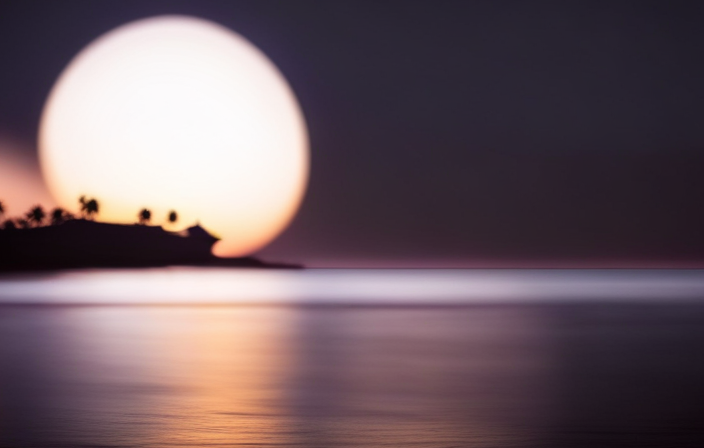
Wow, I’m honestly taken aback! Curious about when the dream cruise takes place? I’ve got you covered, friend. Planning the perfect dream cruise is far from simple. There are countless factors to consider, making it quite a complex endeavor. But fear not, for I am here to guide you every step of the way on this nautical adventure.
In this article, we will explore the key elements that will help you determine the best time to set sail on your dream cruise.
First and foremost, you’ll want to take the weather into account. Nobody wants to be caught in a stormy sea, am I right?
Researching cruise itineraries is also crucial, as it will give you a better understanding of the destinations and activities available.
And let’s not forget about planning around special events – who wouldn’t want to witness a breathtaking fireworks display while cruising under the starry night sky?
So, my friend, buckle up and get ready to embark on a journey of discovery. Because finding the perfect time for your dream cruise is just the first step towards creating memories that will last a lifetime.
- Dream cruises can be planned for any time of the year, but it is important to consider weather conditions and pack accordingly.
- Off-season destinations and lesser-known ports can provide a more tranquil experience and authentic cultural experiences.
- Themed cruises, such as culinary or music-themed cruises, offer luxury amenities and the opportunity to connect with like-minded individuals.
- Incorporating cultural events into the itinerary can add excitement and authenticity to the cruise experience.
Consider the Weather
When planning your dream cruise, you’ll want to consider the weather so you can envision yourself basking in the warm sun and feeling the gentle sea breeze on your face.
The weather plays a crucial role in determining what to pack for your trip and what activities you can plan.
If you’re heading to a tropical destination, pack your swimsuits, sunscreen, and beach towels, as you’ll likely spend a lot of time soaking up the sun and enjoying the crystal-clear waters.
On the other hand, if you’re going to a cooler climate, bring along some warmer clothing and jackets for those chilly evenings on deck.
Additionally, researching the weather patterns of your chosen cruise destinations will help you plan your activities accordingly.
For instance, if it’s known to rain frequently, you can schedule indoor activities like spa treatments or casino visits.
So, now that you have an idea about the weather, let’s move on to researching cruise itineraries.
Research Cruise Itineraries
If you’re planning a research cruise, you’ll be intrigued to know that there are numerous fascinating itineraries available. When researching cruise itineraries, it’s important to consider off-season destinations and explore lesser-known ports. Going to off-season destinations can provide a unique experience, as you’ll be able to avoid crowds and enjoy a more tranquil atmosphere.
Additionally, exploring lesser-known ports allows you to discover hidden gems and experience the local culture in a more authentic way. Whether you’re interested in remote islands, historic towns, or vibrant cities, there is a cruise itinerary that will suit your preferences. By venturing off the beaten path, you can create unforgettable memories and uncover new knowledge.
As you plan your cruise, it’s also essential to consider special events that may be taking place during your desired travel dates. This will ensure that you don’t miss out on any exciting experiences along the way.
Plan Around Special Events
When planning my dream cruise, I always make sure to consider any special events happening in the destinations I’ll be visiting. Attending festivals or celebrations adds a vibrant and immersive experience to my trip, allowing me to witness the local culture at its liveliest.
Additionally, taking advantage of themed cruises allows me to indulge in my personal interests, whether it’s a music-themed cruise, a culinary cruise, or even a wellness retreat at sea.
Lastly, incorporating cultural events into my itinerary ensures that I get a well-rounded experience, as I can explore art exhibitions, theater performances, or traditional ceremonies that showcase the unique heritage of each destination.
Attend Festivals or Celebrations
One of the best times to attend festivals or celebrations is during the Dream Cruise. This annual event takes place in August and attracts car enthusiasts from all over the world.
Not only can you witness the incredible display of classic cars along Woodward Avenue, but you can also attend parades that showcase these stunning vehicles. The atmosphere is electric, with music, food, and excitement filling the air.
As you wander through the streets, you’ll have the opportunity to explore local cuisine from various food vendors, offering a delicious array of options. From mouthwatering BBQ to delectable desserts, there’s something to satisfy every palate.
The Dream Cruise is an experience like no other, immersing you in the world of automotive history and culture. So, after attending this incredible event, why not take advantage of themed cruises to continue your adventure?
Take Advantage of Themed Cruises
After immersing myself in the world of automotive history and culture at the Dream Cruise, why not embark on themed cruises to further indulge in delightful experiences?
Themed cruises offer a unique and exciting way to explore different interests while enjoying all the amenities of a luxury cruise. One of the benefits of themed cruises is the opportunity to connect with like-minded individuals who share your passions.
Whether you’re a foodie, a music lover, or a fitness enthusiast, there are themed cruises available to suit every interest. From culinary cruises where you can taste exquisite dishes prepared by renowned chefs to music-themed cruises featuring live performances by top artists, the options are endless.
These themed cruises not only provide entertainment but also educational experiences, with expert speakers and workshops on board. So, why not incorporate cultural events into your itinerary and make your dream cruise an unforgettable adventure?
Incorporate Cultural Events into Your Itinerary
Immerse yourself in the vibrant local culture by incorporating cultural events into your itinerary, creating an unforgettable adventure. When planning your dream cruise, don’t miss out on the opportunity to experience the rich traditions and customs of the ports you’ll be visiting. By incorporating local cultural events into your schedule, you can truly immerse yourself in the essence of each destination. From festivals and parades to art exhibits and traditional performances, there’s something for everyone to enjoy. To give you an idea of what to expect, here’s a sample table showcasing some cultural events from popular cruise destinations:
Incorporating these local cultural events into your itinerary will add an extra layer of excitement and authenticity to your dream cruise. Now, let’s move on to the next step: avoiding peak travel times.
Avoid Peak Travel Times
To maximize savings and avoid crowds, it’s best to steer clear of peak travel times when planning your dream cruise. Did you know that cruise prices can be up to 50% higher during peak season?
To make the most of your trip, consider peak travel times and plan for ideal weather. Here are some things to keep in mind:
- Off-peak season offers lower prices and fewer people on board.
- Shoulder season allows you to enjoy good weather without the crowds.
- Research the cruise destinations to determine their peak and off-peak seasons.
- Consider booking your dream cruise during the weekdays to avoid the weekend rush.
- Be flexible with your travel dates to find the best deals.
By considering these factors, you can save money and have a more enjoyable experience on your dream cruise. Now, let’s move on to the next step and check for cruise line promotions.
Check for Cruise Line Promotions
Take a look at the various promotions offered by cruise lines to find enticing discounts and exclusive deals. Cruise line loyalty programs are a great way to save money, as they often provide special perks and discounted packages to repeat customers. These programs reward your loyalty with benefits such as room upgrades, onboard credits, and priority boarding. Additionally, many cruise lines offer limited-time promotions throughout the year, such as discounted fares or free amenities. It’s worth checking the cruise line’s website or signing up for their newsletter to stay updated on these promotions. By taking advantage of these offers, you can save a significant amount of money on your dream cruise. Now, let’s consider your budget and how to make your dream cruise a reality.
Consider Your Budget
After checking for cruise line promotions, it’s time to consider your budget for your dream cruise. Planning a cruise can be an exciting experience, but it’s important to determine how much you’re willing to spend before making any decisions.
Consider your preferences, such as the length of the cruise, the type of cabin you want, and any additional amenities you may desire. These factors can greatly impact the cost of your trip.
Create a budget that includes not only the cost of the cruise itself, but also any additional expenses such as airfare, transportation to and from the port, excursions, and onboard activities.
By planning your itinerary and considering your budget, you can ensure that your dream cruise is not only enjoyable but also affordable.
Now, let’s dive into the next step and research cruise lines and ships.
Research Cruise Lines and Ships
When researching cruise lines and ships, it’s important to read reviews and ratings from previous passengers. This will give you a better understanding of the overall experience and customer satisfaction.
Additionally, it’s crucial to consider the amenities and activities offered on board to ensure they align with your preferences and interests.
Lastly, look for cruise lines that cater to your specific interests, such as adventure, relaxation, or family-friendly options.
By taking all these factors into account, you can make an informed decision and find the perfect cruise line and ship for your dream vacation.
Read Reviews and Ratings
Experience the enchantment of Dream Cruise through the mesmerizing reviews and ratings, allowing yourself to be transported to a realm of awe and wonder.
Reading reviews and ratings is an essential step in planning your dream cruise. It provides valuable insights into the experiences of previous passengers and helps you make an informed decision.
Not only can you learn about the ship’s amenities and activities, but you can also gain insight into the quality of service, entertainment options, and dining experiences.
Additionally, reviews often mention weather considerations and provide tips for making the most of your itinerary. By delving into these reviews, you can uncover hidden gems and avoid potential pitfalls.
Now, let’s consider the amenities and activities offered, enhancing your cruise experience to new heights.
Consider the Amenities and Activities Offered
Immerse yourself in a world of endless possibilities as you discover the luxurious amenities and exhilarating activities that await you on your journey.
When it comes to amenities, it’s important to compare what different cruise lines have to offer. Some may have state-of-the-art fitness centers, while others may boast extravagant spas where you can indulge in ultimate relaxation. Take a look at the dining options available too. From gourmet restaurants to casual buffets, there is something to satisfy every palate.
As for activities, the choices are abundant. Whether you’re seeking thrilling water sports, engaging entertainment shows, or educational enrichment programs, cruise lines have it all. From morning till night, there is never a dull moment on board.
So, as you consider the amenities and activities available, remember to look for cruise lines that cater to your interests, ensuring an unforgettable experience.
Look for Cruise Lines That Cater to Your Interests
Discover a world of endless possibilities by finding cruise lines that perfectly cater to your interests, allowing you to indulge in unforgettable moments tailored just for you.
When choosing a cruise, consider the themed cruise options available. Whether you’re a foodie, an adventure seeker, or a history buff, there are cruise lines that offer specialized experiences to match your passions.
Immerse yourself in unique cultural experiences, such as wine tastings in Italy, salsa dancing in Cuba, or exploring ancient ruins in Greece. These themed cruises provide a deeper level of engagement and allow you to connect with like-minded individuals who share your interests.
By selecting a cruise line that aligns with your hobbies and preferences, you can ensure that your dream cruise will be an extraordinary journey.
So, when considering your travel companions, think about how their interests align with yours to create an unforgettable experience for everyone involved.
Consider Your Travel Companions
When planning your dream cruise, it’s important to consider who you’ll be traveling with. Different cruise ship options cater to different types of travelers, so it’s essential to choose a cruise line that offers activities and amenities that suit your travel companions.
If you’re traveling with your family, look for cruise lines that provide family-friendly activities such as kids’ clubs, water parks, and age-appropriate entertainment. Some cruise lines even offer babysitting services, allowing parents to enjoy some alone time.
On the other hand, if you’re traveling with friends or as a couple, you might prefer a cruise line that offers more adult-oriented activities like nightlife, casinos, and specialty dining options.
Keep in mind that being flexible with your travel dates can also open up more options for your dream cruise, allowing you to take advantage of special promotions or find the perfect itinerary.
Be Flexible with Your Travel Dates
When it comes to planning a dream cruise, being flexible with your travel dates can make all the difference.
One key point to consider is looking into shoulder season cruises, which are often less crowded and more affordable.
Another option is to keep an eye out for repositioning cruises, where ships are moved to different regions and offer discounted rates.
Lastly, being open to last-minute changes can lead to great deals and unexpected adventures.
So, don’t be afraid to adjust your travel dates and embrace the excitement of a flexible cruise itinerary.
Consider Shoulder Season Cruises
If you’re planning a cruise, you might want to consider booking during the shoulder season for Dream Cruise. This is the time between the peak and off-peak seasons when you can enjoy several benefits.
Firstly, you’ll experience fewer crowds, which means shorter lines and more personal attention from the staff. Secondly, the weather is generally milder during the shoulder season, making it more comfortable for outdoor activities and excursions. Lastly, you can often find better deals and discounts during this time, saving you money on your Dream Cruise vacation.
When it comes to the best destinations for shoulder season cruises, popular choices include the Mediterranean, Alaska, and the Caribbean. These regions offer beautiful scenery, cultural experiences, and a variety of activities to suit every traveler’s interests.
So, if you want to make the most of your Dream Cruise, consider booking during the shoulder season and enjoy all these benefits.
Look for Repositioning Cruises
Repositioning cruises offer a unique opportunity to explore different destinations while enjoying the benefits of a cruise experience. But have you ever considered the cost savings they provide? These cruises typically occur when cruise lines move their ships from one region to another, such as from the Caribbean to Europe or Alaska to the Caribbean. This means that passengers can enjoy a variety of ports of call during the journey.
Booking repositioning cruises early is key, as they tend to fill up quickly due to their popularity. By planning ahead, you can secure the best cabins and take advantage of any early bird promotions. However, it’s important to be open to last-minute changes. Cruise itineraries may be subject to adjustments depending on weather conditions or unforeseen circumstances.
Transitioning into the next section, it’s important to be flexible and adaptable when considering a repositioning cruise.
Be Open to Last-Minute Changes
Stay flexible and embrace the unexpected twists and turns that may come your way, as being open to last-minute changes can lead to unique and thrilling experiences during your journey. Planning for a dream cruise is exciting, but it’s important to remember that sometimes things don’t go as planned.
Here are a few reasons why being open to last-minute changes can enhance your cruise experience:
You may discover a hidden gem: By being flexible with your itinerary, you might stumble upon a lesser-known port of call or an off-the-beaten-path attraction that turns out to be the highlight of your trip.
Avoiding bad weather: Weather conditions can change quickly, and being open to adjusting your plans can help you avoid sailing into rough seas or torrential downpours.
Unexpected opportunities: Last-minute changes can lead to unexpected opportunities like upgraded accommodations or unique shore excursions.
By staying open to last-minute changes, you can make the most of your dream cruise.
Now, let’s discuss how consulting with a travel agent can further enhance your planning process.
Consult with a Travel Agent
When it comes to planning a dream cruise, consulting with a travel agent can be incredibly beneficial.
Not only can they provide expert advice and recommendations, but they also have insider knowledge that can help you make the most of your trip.
Plus, letting someone else handle the planning and booking process takes a huge weight off your shoulders, allowing you to focus on the excitement of your upcoming adventure.
Get Expert Advice and Recommendations
For a truly enchanting experience, let the experts guide you and offer their recommendations on your dream cruise. When it comes to planning the perfect voyage, expert opinions can make all the difference.
Here are three recommended destinations that will take your breath away:
The crystal-clear waters of the Caribbean: Immerse yourself in the vibrant culture, stunning beaches, and incredible snorkeling opportunities in destinations like the Bahamas, Jamaica, and the Virgin Islands.
The majestic fjords of Norway: Sail through dramatic landscapes of towering cliffs, cascading waterfalls, and picturesque villages. Experience the midnight sun or chase the awe-inspiring Northern Lights.
The exotic wonders of Southeast Asia: Discover the vibrant markets, ancient temples, and breathtaking landscapes of countries like Thailand, Vietnam, and Indonesia. Explore bustling cities, tranquil beaches, and lush rainforests.
By taking advantage of insider knowledge and expert recommendations, you can ensure that your dream cruise is an unforgettable journey of discovery.
Take Advantage of Insider Knowledge
Experience the magic of hidden gems and secret spots with insider knowledge, making your voyage an extraordinary adventure. When it comes to planning your dream cruise, having access to insider tips can truly enhance your experience. Whether it’s finding the best snorkeling spots in the Caribbean or discovering the hidden local markets in Mediterranean ports, insider knowledge can take your trip to the next level. To give you a taste of what awaits you, here are a few hidden gems you can uncover during your dream cruise:
These are just a few examples, but there are countless more waiting to be discovered. So, let someone else handle the planning and booking process, and get ready to embark on an unforgettable journey filled with hidden gems and insider tips.
Let Someone Else Handle the Planning and Booking Process
Let someone else take care of all the planning and booking for you, so you can relax and enjoy your vacation to the fullest. Imagine having a personal travel concierge who can handle everything from finding the best flights and accommodations to arranging unique experiences and activities tailored to your interests.
When considering different travel destinations for your dream cruise, a travel agency can provide valuable insight and recommendations based on their expertise and knowledge. They can help you navigate through the various options available, taking into consideration factors such as your budget, preferred travel dates, and desired itinerary.
One of the benefits of using a travel agency is that they have access to exclusive deals and discounts that you may not be able to find on your own. They can also save you time and effort by handling all the necessary paperwork and ensuring that everything is in order for your trip.
With a travel agency by your side, you can have peace of mind knowing that all the details of your dream cruise are taken care of, allowing you to simply relax and enjoy your vacation.
What are the top cruise lines for dream cruises?
The top luxury cruise lines for dream cruises include Regent Seven Seas, Crystal Cruises, and Seabourn. For the best family-friendly experience, consider Royal Caribbean, Disney Cruise Line, and Carnival Cruise Line.
Are there any specific events or festivals that I should plan my dream cruise around?
To truly have the dream cruise experience, it’s essential to plan around specific events and festivals. From the vibrant Carnival in Rio de Janeiro to the enchanting Venice Film Festival, these moments will make your book dream cruise truly unforgettable.
How can I find the best deals or promotions for dream cruises?
To find the best deals and promotions for dream cruises, I recommend researching online travel agencies, signing up for cruise line newsletters, and checking social media for exclusive discounts. Booking in advance and being flexible with your travel dates can also help you secure great discounts.
Are there any specific cruise ships known for offering exceptional dream cruise experiences?
When it comes to luxury cruise ships and dream cruise destinations, there are a few that stand out. Ships like the Symphony of the Seas and the Celebrity Edge offer exceptional experiences that will leave you in awe.
Is it better to book a dream cruise directly with the cruise line or through a travel agent?
Booking a dream cruise directly with the cruise line or through a travel agent? While booking options vary, there are clear advantages to using a travel agent. They provide expertise, personalized service, and can often secure exclusive deals and perks.
After considering the weather, researching itineraries, and planning around special events, I finally booked my dream cruise.
I was able to snag a great deal during a cruise line promotion and chose a ship that had rave reviews.
As I set sail with my loved ones, the anticipation grew.
The moment we stepped foot on the ship, it felt like we were entering a magical world, full of adventure and relaxation.
It was truly a dream come true, an experience that felt like floating on clouds.
Affiliate disclaimer
As an affiliate, we may earn a commission from qualifying purchases. We get commissions for purchases made through links on this website from Amazon and other third parties.
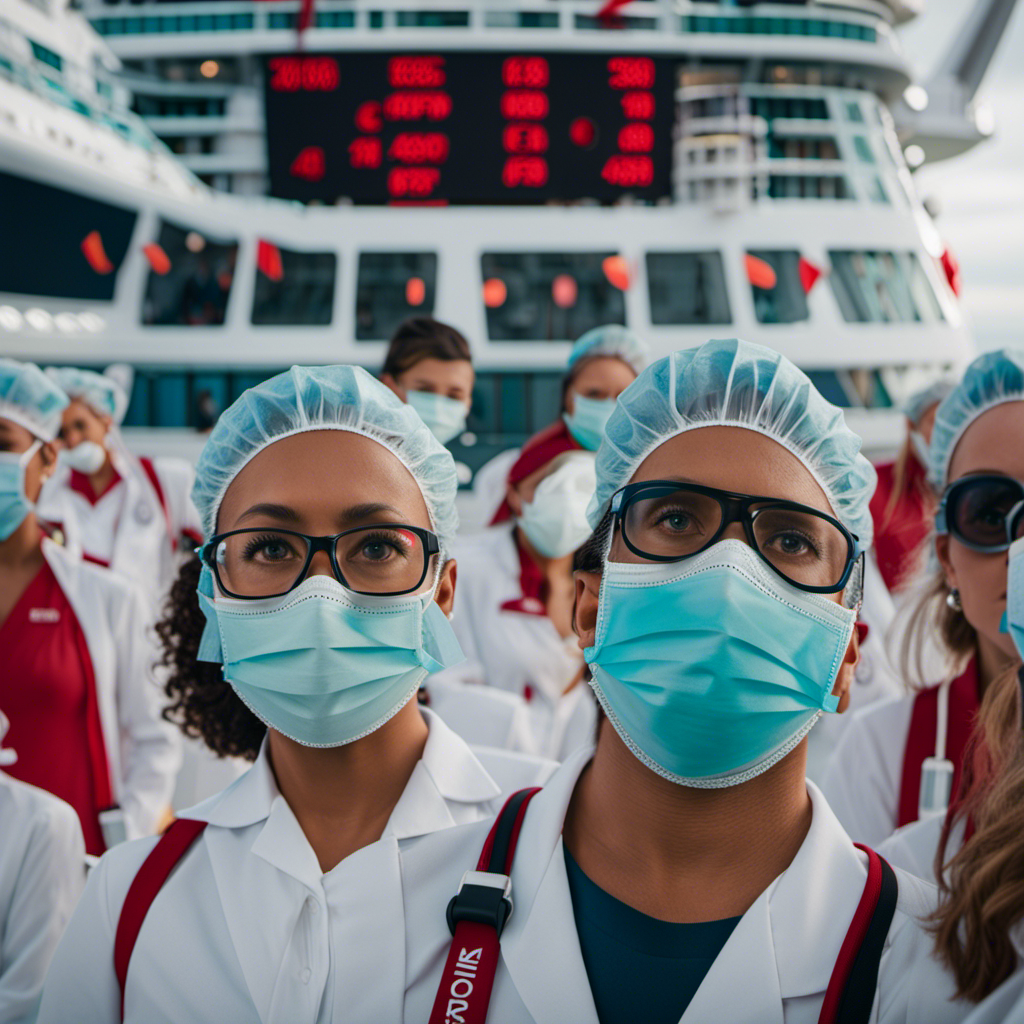
Virgin Voyages Adapts to Omicron Variant With New Passenger Restrictions
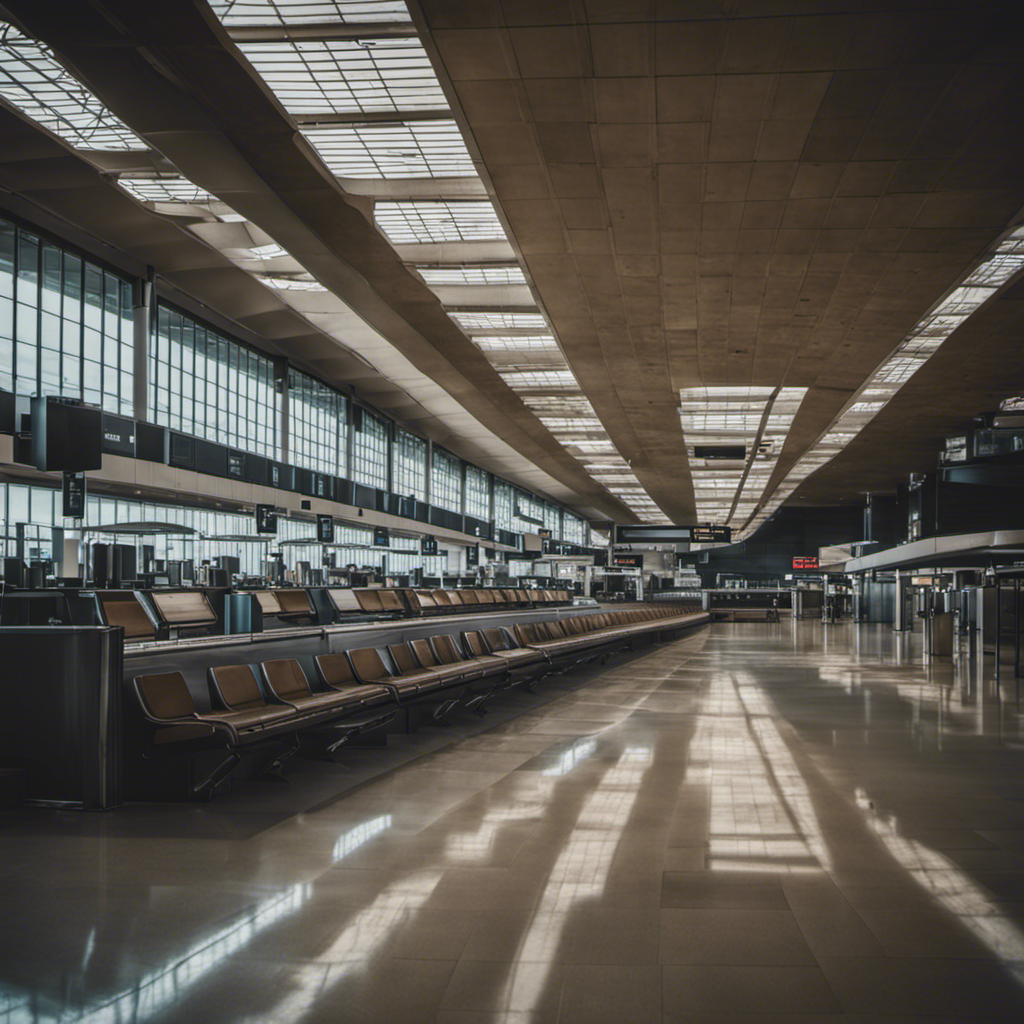
The Impact of Current Situation on Travel Bookings and Behavior
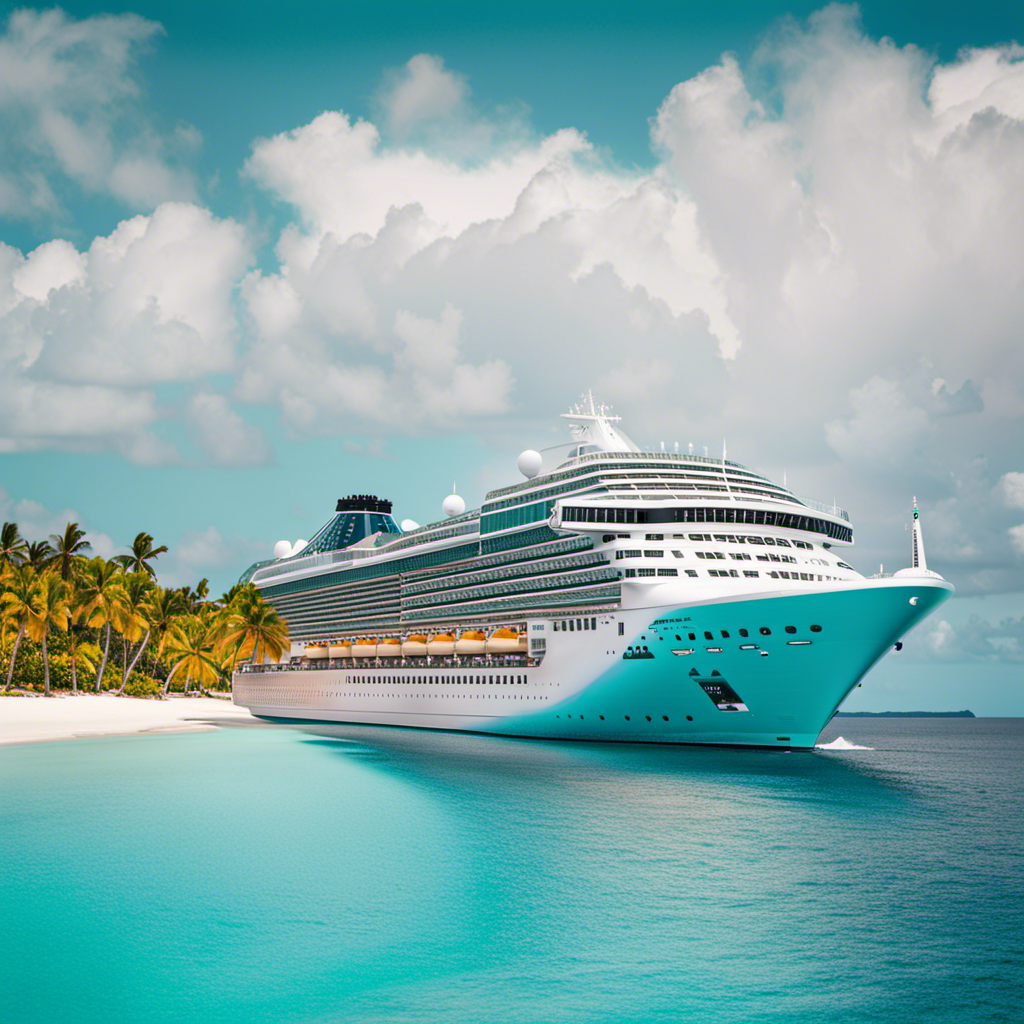
Celebrity Cruises’ Exclusive Upgrade Deals & Caribbean Bonuses
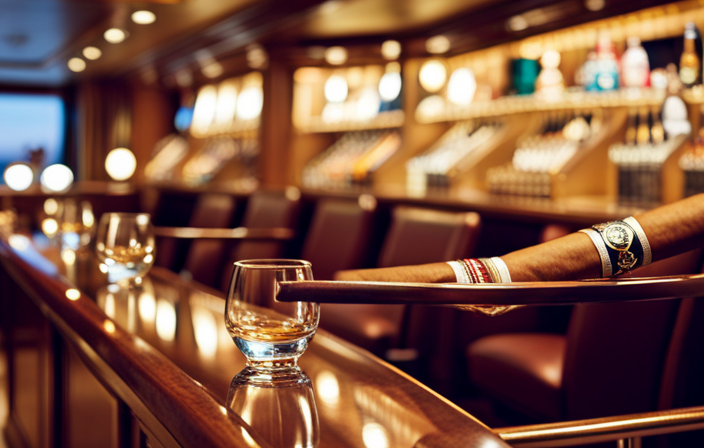
Cruise Cigar Bars: Social Environments for Enthusiasts
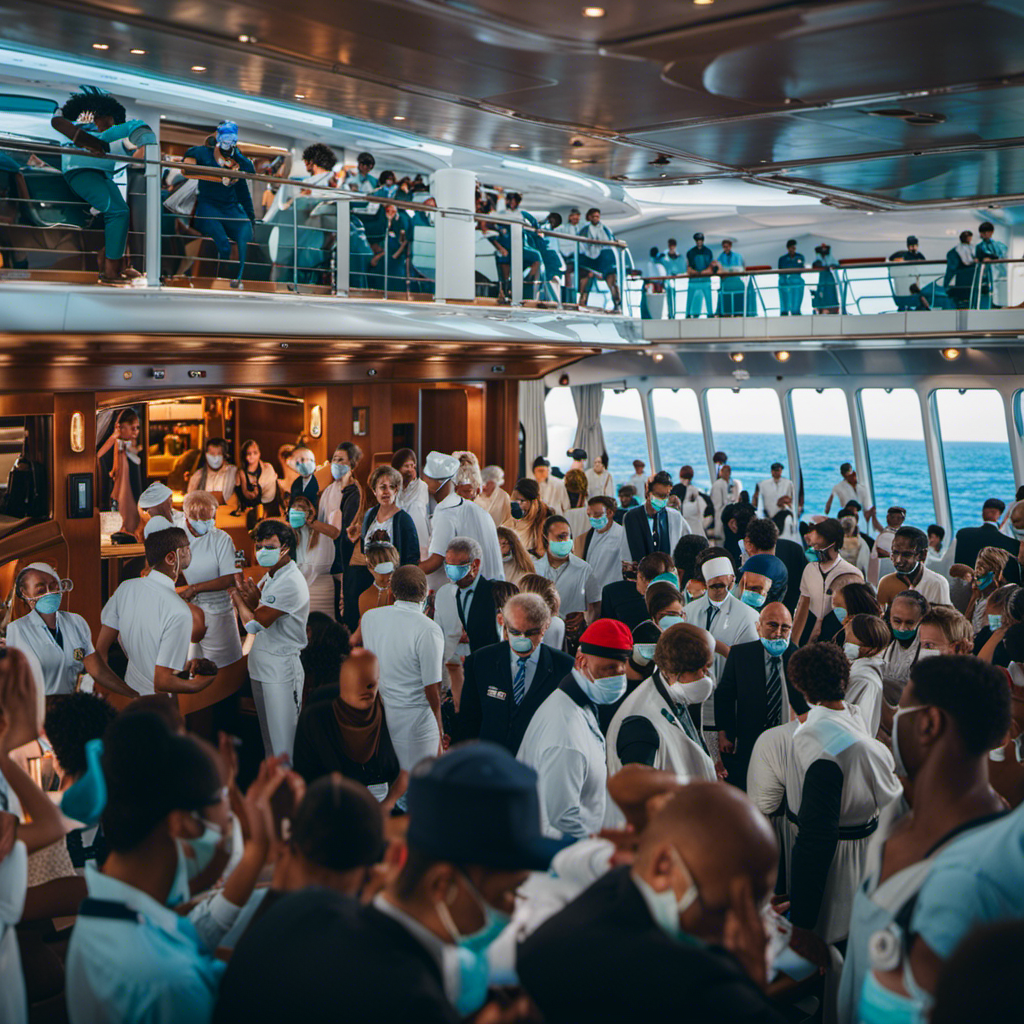
Cruise Ships Experience Rapid Surge in COVID Cases
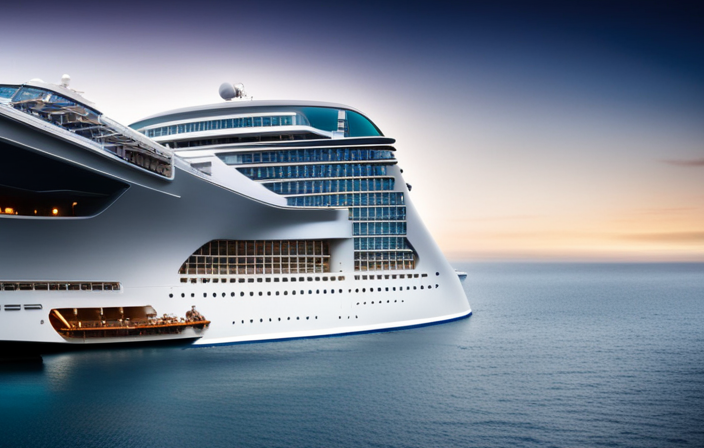
Which Celebrity Cruise Ships Have Been Refurbished

What Drinks Can You Bring On Princess Cruise

How To Turn On Cruise Control Tesla Model 3

What Is The Weather Like On A Transatlantic Cruise In April

How To Set Cruise Control Tesla Model Y

Ultimate Adventure and Relaxation Guide at Playa Mia Grand Beach Park

What Makes Sharkbanz Your Ultimate Fearless Travel Protection?

Enchanting Destinations in Vietnam: Exploring Hoi Hanoi Halong Bay

Exploring Juneau: History Wilderness Local Delights Uncovered

Azamara Onward: Origins, Renovation, and Future Plans

How To Check Weather For A Cruise
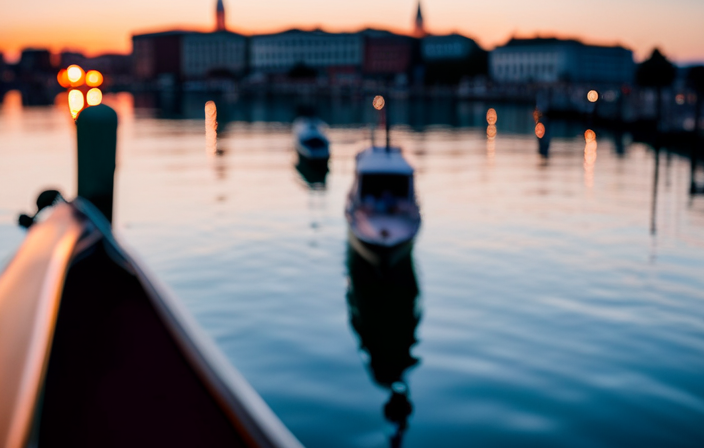
How To Get From Venice To Chioggia Cruise Terminal
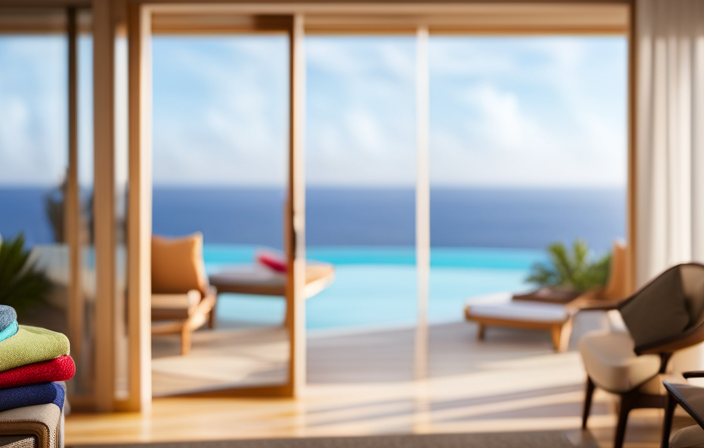
How Do You Qualify For An Ultra Cruise On Carnival

Titanic Compared To Modern Cruise Ships: We’ve Come A Long Way!
By: Author David Chapman
Posted on Last updated: October 14, 2023
Categories CRUISE LINES & SHIPS , LEARN
The Titanic is a name that is synonymous with luxury, tragedy, and historical significance. It was the largest built ship of its time and was hailed as unsinkable. However, on its maiden trip in 1912, the Titanic famously struck an iceberg and sank, claiming over 1,500 lives. And the wreckage was not found years until decades later in 1985. Have you ever wondered about the Titanic compared to modern cruise ships?
Today, cruise ships have come a long way in terms of size, amenities, and safety measures. In this article, we’ll compare the Titanic to some of the largest modern cruise ships to see how they stack up. There’s plenty to discover whether you want to compare ships’ specs, amenities, or activities.
The Titanic Compared To Modern Cruise Ships
When it comes to size, it’s no contest – at the time of its construction, the Titanic was the largest ship constructed in the world, measuring 882 feet long, 92.6 feet wide, 175 feet tall, and with a gross tonnage of 46,329. In contrast, the Wonder of the Seas, currently the largest modern cruise ship in the world, measures 1,187 feet long, 210 feet wide, 238 feet tall, and with a gross tonnage of 235,600.
When it comes to facilities, modern cruise ships offer a wide range of options for passengers, including multiple restaurants, bars, pools, spas, theaters, and sports facilities. Some even have ice skating rinks, water parks, and rock climbing walls. Notably most amenities are available to all passengers.
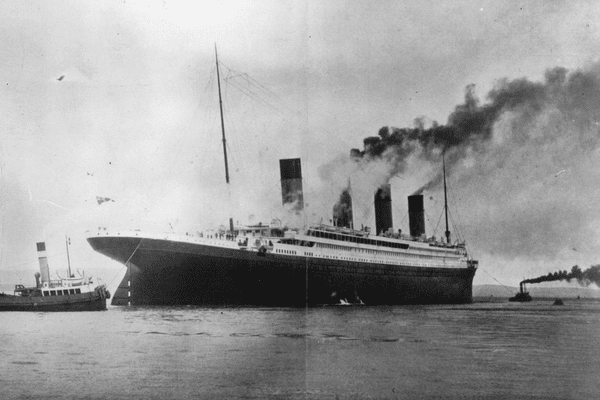
In contrast, the Titanic had a more limited selection of amenities–primarily available for first-class passengers. It had several restaurants, a café, a swimming pool, a gym, a library, a grand staircase, and 447 staterooms. However, the Titanic’s amenities were luxurious for their time, with opulent décor and fine dining options.
Comparing what was then to now is pretty exciting, so let’s see how modern cruise ships compare to the Titanic!
Wonder Of The Seas Vs. Titanic
Among the world’s largest cruise ships, Royal Caribbean’s Wonder of the Seas is the largest. It was delivered in January 2022 and is the fifth vessel in the Oasis class of cruise ships. The largest cruise ship in the world nearly seems like a city unto itself with eight distinct neighborhoods, 18 decks, a great range of food and drink, experiences of all kinds, and jaw-dropping entertainment.
In comparison, the Titanic was dwarfed by the Wonder of the Seas. While both ships were designed to transport passengers on long voyages, there are several key differences between the Wonder of the Seas and the Titanic.
Specs Comparison Titanic Vs. Wonder of the Seas
The amenities offered by wonder of the seas.
Overall, while the Titanic was a luxurious and impressive vessel for its time, the Wonder of the Seas offers a much higher level of luxury and comfort, with a wide range of amenities and features, advanced technology, and a larger capacity for passengers. Some of the top attractions found on the Wonder of the Seas include:
- Full-sized basketball court
- A children’s splash park
- Full water slides
- Ice-skating rink
- Ziplines reaching as high as ten decks
- A surf simulator
- 1400-seater theater
- Rock climbing
- Aquatic theater

Symphony Of The Seas Vs. Titanic
The Symphony of the Seas is the 4th vessel of the Oasis class of cruise ships and the second-largest cruise ship in the world, owned by Royal Caribbean International.
It was delivered in April 2018, and until the Wonder of the Seas made its classy appearance, the Symphony was considered the largest cruise ship to tour the ocean. Though only slightly smaller, Symphony is still a marvel to behold and almost five times the weight of the Titanic.
Specs Comparison Titanic Vs. Symphony of the Seas
The amenities offered by symphony of the seas.
The Symphony of the Seas offers many amenities and activities for families with children. From thrilling waterslides and surf simulators to rock climbing walls and a full-service spa and fitness center, there is something for everyone on this modern cruise ship. Listed below are a few highlights:
- Seven distinct neighborhoods
- Four pools and ten whirlpools
- 20 dining options, including buffets and restaurants
- Multiple bars and lounges
- Activities like the Ultimate Abyss water slide, surf simulators, rock climbing walls, and more
- Spa and fitness center
Harmony Of The Seas Vs. Titanic
The Harmony of the Seas is a modern marvel from Royal Caribbean International that offers a wide range of amenities and activities to keep everyone entertained and satisfied. Third to join the Oasis class flees, with a gross tonnage of 226,963, the Harmony of the Seas is a state-of-the-art vessel that surpasses the Titanic in size, comfort, and luxury.
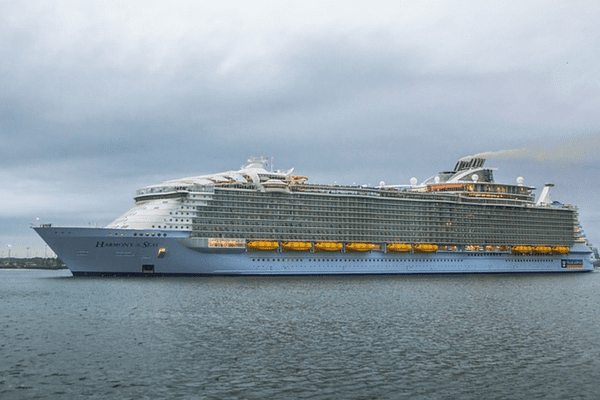
The Amenities Offered By Harmony Of The Seas
With a wide range of amenities and activities, this modern cruise ship caters to all interests and preferences. From thrilling adventures and activities to relaxing retreats and indulgent experiences, some of the ship’s main highlights include:
- Central Park, with its public space with plants, trees, and outdoor dining options
- The Vitality at Sea Spa and Fitness Center
- The Boardwalk, which features carnival games, a carousel, and a variety of dining options
- The Royal Promenade and Entertainment Place, which offer a range of live shows, movies, and games
- Multiple dining options, including kid-friendly restaurants and buffets
- 2,747 staterooms with virtual balconies
Allure Of The Seas Vs. Titanic
The Allure of the Seas , the fourth vessel in the Oasis class of cruise ships from Royal Caribbean International, was constructed at the STX Europe shipyard in Turku, Finland.
The ship’s keel was laid in December 2008 in a ceremony attended by representatives from Royal Caribbean and STX Europe. The Allure of the Seas is a modern marvel, with a gross tonnage of 225,282 and a wide range of impressive amenities. Like its siblings, it is significantly larger than the Titanic, with plenty more to offer.
Specs Comparison Titanic Vs. Allure of the Seas
The amenities offered by allure of the seas.
The Allure of the Seas offers many luxurious amenities and activities for families with children. Some of the best amenities found on the Allure of the Seas include:
- Central Park, with over 12,000 plants and trees
- The Royal Promenade, which is a vibrant shopping and dining destination
- A Vitality at Sea Spa and Fitness Center offers various treatments and services
- A Boardwalk which is also a waterfront destination with many entertainment options
- The Entertainment Place features a variety of live shows, concerts, and performances
- The ice-skating rink that is public and for sports
- Multiple pools and whirlpools for guests to enjoy
Oasis Of The Seas Vs. Titanic
Although the Allure and Oasis of the Seas are sister ships, they do have some differences. The Allure of the Seas is slightly longer, measuring about 5 cm (2 inches) more in length. However, the Oasis of the Seas has more amenities and features, including water slides, the Ultimate Abyss dry slide, and the Splashaway Bay water park. All that while also being double the size of the Titanic !
Both sister ships offer a range of luxurious amenities and experiences for passengers, but the Oasis of the Seas may offer a wider variety of activities and attractions.
Specs Comparison Titanic Vs. Oasis of the Seas
The amenities offered by oasis of the seas.
The Oasis of the Seas was all about attractions, as the name suggests. One aspect that particularly distinguishes it is that it was the first cruise ship to include seven separate themed neighborhoods. Among the other fascinating features are the following:
- Various activities, including rock climbing, Royal puzzles, zip lines, and more
- Ten whirlpools and four huge swimming pools
- 25 dining options, multiple bard and lounges
- Fitness center and full-service sea spas
- Basketball court, Ice-skating rink, and aqua parks
- Many theaters and shows
The Titanic Cabin Experience
The Titanic was a luxurious and impressive vessel with a range of options available to passengers. There were four main categories of cabins on the Titanic: first-class, second-class, third-class, and crew cabins.
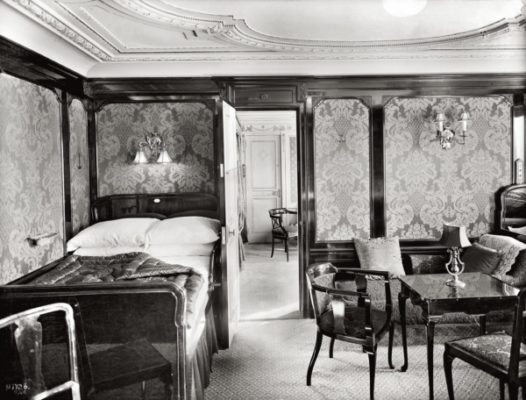
First Class Cabins
On the Titanic, first-class passengers were treated to the highest level of luxury available at the time. Private suites with two bedrooms, walk-in wardrobes, and a spacious living room cost over $800 , equivalent to around $80,000 today.
These suites also had their own private bathrooms. In addition to these amenities, first-class passengers had access to a smoking room, veranda cafes, a dining saloon, a restaurant, and a room to write and read. There were also squash courts, a gym, and a swimming pool for more active passengers.
Second Class Cabins
Second-class lodging on the Titanic involved cabins with bunk beds, each with two or four beds. These cabins had no private restrooms, but they had mirrors and sinks, and the bed linens were changed daily.
Second-class passengers had access to a spacious outdoor promenade, a library, a smoking room, and a dining room, where evening tea and coffee were served. The dining area could seat nearly 2,300 people at once, and a musician would provide entertainment during meals.
Third Class Cabins
Third-class lodging on the Titanic was much more minimalistic, with few amenities. A piano was available for passengers to play in the general room in the evenings, which was the favorite gathering place for third-class passengers. Additionally, there was a smoking room exclusively for men, and around three sittings of 470 people were possible in the dining room for third-class passengers.
The food was simple but abundant, consisting of roast beef, rice soup, biscuits, and fruit. Third-class accommodations included staterooms that accommodated up to ten passengers and were positioned near the ship’s engines at the bottom.
In the ship’s middle were families, with single women and men separated at the front and back of the vessel. There were only two baths for all of the third-class passengers to share.
The Titanic Vs. Modern Cruise Ships: Cabin Comparison
There are several key differences when comparing the cabins on the Titanic to modern cruise ships. First, modern cruise ships offer a wider range of cabin options, with everything from basic, no-frills rooms to luxurious suites with multiple floors, private balconies and all the latest amenities.
Many modern cruise ships also offer a variety of features and amenities not found on the Titanic, such as fitness centers, spas, and entertainment venues.
For example, the Symphony of the Seas offers a variety of cabin options, including interior staterooms, ocean-view staterooms, and balcony staterooms. In addition, each cabin features a range of amenities, such as private bathrooms, flat-screen TVs, and plenty of storage space.

In contrast, the cabins on the Titanic were much more basic, with few amenities and limited space. While the first-class cabins were luxurious for the time, they would not compare to the lavish amenities and spacious accommodations found on modern cruise ships.
Titanic Amenities And Activities
The Titanic was a luxurious and impressive vessel for its time, offering a wide range of amenities and activities for passengers to enjoy during their voyage. Some of the top amenities and activities available on the Titanic included:
- Dining : Dining on the Titanic was an important part of the overall experience for passengers. The Titanic had multiple options, including a grand dining saloon and a veranda cafe. The dining saloon was the largest ever seen on a ship, with a live orchestra providing background music as passengers dined on lavish meals.
- Entertainment : The Titanic offered various entertainment options for passengers, including live shows, concerts, and performances in the grand theater. There were also deck games such as shuffleboard and gym facilities, including a squash court and swimming pool, for more active passengers.
- Socializing : The Titanic had a range of socializing spaces for passengers, including a smoking room, library, and outdoor promenade. Afternoon tea and coffee were served in the library, providing a relaxing atmosphere for passengers to socialize and relax.
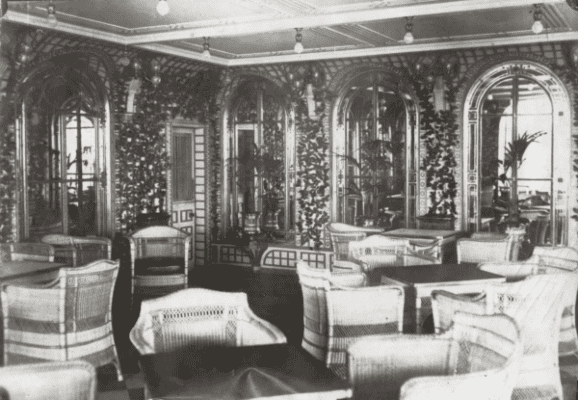
Modern cruise ships, such as the Symphony of the Seas, offer many amenities and activities that far surpass those available on the Titanic. Some of the top amenities and activities available on the Symphony of the Seas include:
- Dining : The Symphony of the Seas has 20 dining options for passengers, ranging from casual buffets to gourmet restaurants. There is something for every taste and dietary preference, with options ranging from traditional dishes to international cuisine.
- Entertainment : The Symphony of the Seas offers a variety of entertainment options for passengers, including live shows, concerts, and performances in the grand theater. There are also various exciting onboard activities, such as a full-sized basketball court, a children’s waterpark, an ice-skating rink, and a surf simulator.
- Relaxation : The Symphony of the Seas has a state-of-the-art spa and fitness center, offering treatments and services to help guests relax and rejuvenate. There are also multiple pools and whirlpools for guests to enjoy and a range of socializing spaces such as bars and lounges.
Was The Titanic Actually A Cruise Ship?
The Titanic may have been luxurious and had amenities like a gym and swimming pool, but it was a British ocean liner and not a cruise ship . While today’s cruise ships are designed specifically for leisurely trips worldwide, the Titanic’s main purpose was to transport passengers from one point to another.
But that doesn’t mean the Titanic didn’t have its fair share of fun activities and lavish décor – it was just geared towards transporting passengers in style rather than providing a vacation experience. So, while the Titanic may not have been a true cruise ship, it certainly had elements of luxury and entertainment that would make it a worthy predecessor to today’s modern cruise ships.
Titanic Vs. Modern Cruise Ships: Safety Comparison
When it comes to the safety of passengers, there is no comparison between the Titanic and modern cruise ships. While the Titanic was considered to be a luxurious and innovative vessel for its time, it did not have the advanced safety features that are standard on today’s cruise ships. Here are a few key alterations between the Titanic and modern cruise ships:
One of the most noteworthy differences between the Titanic and modern cruise ships is the number of lifeboats available. The Titanic had only 20 lifeboats , which could not accommodate all passengers. In contrast, modern cruise ships have much more robust lifeboat systems, with enough capacity to evacuate all passengers and crew in the event of an emergency.
Safety drills
Modern cruise ships also have mandatory safety drills for all passengers and crew to ensure everyone knows what to do in an emergency.
These drills typically involve a briefing on the location of lifejackets, the nearest emergency exits, and a demonstration of how to use them. Unfortunately, there were no safety drills on the Titanic, and many passengers were unaware of the location of lifejackets or the proper procedures for evacuating the ship.
Communication
In the event of an emergency, communication is critical for ensuring the safety of all passengers and crew. Modern cruise ships are equipped with advanced communication systems that allow for real-time communication with emergency services and other ships in the area. On the other hand, the Titanic had limited communication capabilities and could not promptly alert other ships of its distress.
Modern cruise ships are much safer than the Titanic, with advanced safety features, mandatory safety drills, and robust communication systems. While no mode of transportation is completely risk-free, the safety measures on modern cruise ships provide families with the peace of mind they need to enjoy their vacation.
Safety Measures on Modern Cruise Ships vs. Titanic
Modern cruise ships prioritize the safety of their passengers and crew, with numerous safety measures in place to prevent accidents and ensure that passengers are protected in the event of an emergency. Some of these measures include:
- Multiple lifeboats and life rafts
Most modern cruise ships carry more than the required number of lifeboats and life rafts, as well as state-of-the-art rescue equipment, to ensure that all passengers can be safely evacuated in the event of an emergency.
- Advanced navigation and communication systems
Modern cruise ships are equipped with the latest navigation and communication technology, including radar, GPS, and satellite tracking systems, to help monitor weather, prevent accidents, and stay in contact with shoreside authorities in the event of an emergency.
- Fire prevention and suppression systems
Modern cruise ships have multiple fire prevention and suppression systems in place, including sprinkler systems, smoke detectors, and fire alarms, to help prevent and contain fires on board.
- Crew training and drills
All crew members on modern cruise ships undergo extensive training in emergency procedures, including drills and simulations, to ensure they are prepared to handle any situation that may arise.
In comparison, the Titanic did not have the same level of safety measures in place. It carried fewer lifeboats and life rafts than required and did not have the same advanced navigation and communication technology as modern cruise ships.
While it did have fire prevention and suppression systems in place, these were not as advanced as those found on modern cruise ships. Additionally, crew training and drills were not as comprehensive as those offered on modern cruise ships.
The Cost Of The Titanic Vs. Modern Cruise Ships
The Titanic was a luxury cruise ship built in 1912 at the cost of $ 7.5 million , equivalent to around $ 230 million today . In comparison, the Wonder of the Seas, the world’s largest cruise ship, was built in 2022 at $1.35 billion .
While the cost of building a cruise ship has certainly increased over the past century, it’s important to consider the advancements in technology and safety measures implemented in modern cruise ships.
The Wonder of the Seas, for example, was built with state-of-the-art technology and safety features, such as advanced navigation systems and emergency response protocols, to ensure the safety of its passengers.
The cost of building a modern cruise ship also includes a wide range of amenities and facilities, such as theaters, restaurants, spas, pools, and recreational activities, which provide passengers with a luxurious and enjoyable experience.
While the cost of building a cruise ship has certainly increased over the years, the investments made in modern cruise ships ensure that they are equipped with the latest technology and safety measures to provide passengers with a safe and enjoyable experience. So, it is clear that modern cruise ships are much safer and have all the tools to keep their passengers safe.
Closing Thoughts
Cruise ships have made huge strides since the debut of the Titanic, and who knows how far the technology and amenities on these ships will come in another 100 years!
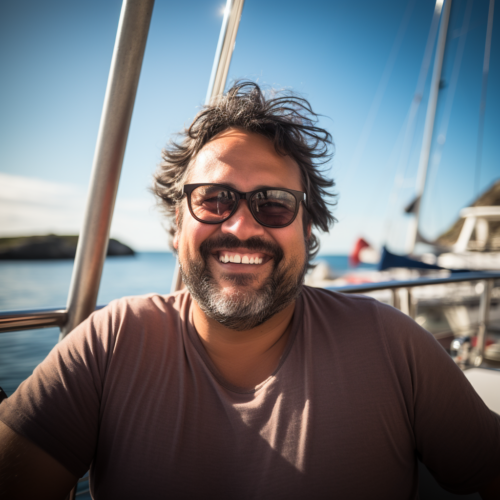
David Chapman
Contributor
Keep up with the latest cruise tips and insights! Follow us on Pinterest:
Related articles.
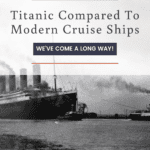

Titanic Compared To Modern Cruise Ships
In Titanic vs modern cruise ships, the real winner is obvious to everyone. Undoubtedly, the Titanic was a champ of its time. It was the largest ocean liner of her era, with 882 feet in length and 92 feet in width.
Titanic remains a hotly debated subject; even many stage shows and movies cast on the heart-wrenching story of Titanic liner.
Nonetheless, many people compare Titanic to modern cruise ships; they want to judge Titanic based on modern amenities found on today’s cruises.
In particular, safety features remain a question, and people want to know how modern cruises develop safety standards to tackle incidents.
In this article, I have explained in detail the difference between modern cruise and the Titanic. I’ve broken the topic into parts for better understanding.
Table of Contents
The Size Difference Of Titanic & Modern Cruise Ships?
Modern cruises have come a long way since Titanic. And the sizes of ships increase over time.
You know there is a huge gap between the Titanic era (1912) and 2024, and It’s evident that technological advancements have played a pivotal role in shaping the cruise industry throughout this extensive period.
In the modern era, many vessels larger than the Titanic float on the sea . You can consider the Royal Caribbean Icon of the Seas that expands across 1,196 feet, and its width is 65 meters (213 feet), and it’s one of the largest cruise ship in the world.
Meanwhile, the Titanic, which was built in 1909 by White Star Line, was 882 feet in length and 92 feet in width, which notably falls short of the modern Royal Caribbean icon of the size of the sea.
Besides this, there were many more ships in the Royal Caribbean fleet that were superior to the Titanic in size. They plan to launch their next vessel, “Start on the Seas,” in 2025, which is expected to be 1198 feet.
The Weight Difference Of Titanic & Modern Cruise Ships
You will have to find some amazing stats in terms of gross tonnage.
I’m taking Icon of the Seas as an epitome of weight because, at the current time, it’s the largest cruise ship on the planet.
In its prime, the Titanic stood out as the heaviest and largest ship of all time before 1912, boasting a weight of 46,000 tons.
However, the Icon of the Seas dwarfs the Titanic, weighing a whopping 250,800 tonnes; this means it’s five times heavier than the Titanic.
You will be surprised to know that the Icon of the Seas encompasses 20 decks, more than 40 restaurants, 15 water fun areas, 8 neighborhoods, 2805 staterooms, and a plethora of other amenities and spots. Seeing all these massive stats, this ship feels like a vibrant city with a bustling life.
And you know what, the giant Icon of the Seas can accommodate 7,600 passengers and 2,350 crew members, while the Titanic could only hold 3,500 passengers?
These stats make the modern cruises superior to Titanic and other previous ocean liners.
Titanic Compared To Modern Day Cruise Technology
The Titanic incident shook the cruise industry and promoted stringent cruise safety standards. Because of this reason, we have seen remarkable progress in the design and engineering processes of modern cruises.
The Titanic was built in 1912, and at that time there was no cutting-edge technology and communication systems. Even it lacked dynamic stabilizers , and that’s why they were not as comfortable as today’s modern cruises. The stabilizers prevent ships from rolling during harsh weather conditions.
The modern ships include dynamic stabilizers that retract automatically when needed.
Similarly, modern ships use advanced navigational features that directly catch signals from satellites and some radar technologies for precise weather forecasts. At the same time, the Titanic ship was relied on outdated communication technology like Morse code.
Because of technological advancements, modern cruise ships have robust hulls and superstructures to optimize stability and buoyancy.
You can take an idea of their refined engineering from the price factor. The Titanic cost around $7.5 in 1912, whereas the Icon of the Seas was more than a $2 billion vessel.
Amenities In Titanic Cruise Ship
Undoubtedly, Titanic was a prime ocean liner in her era. And she was offering vast amenities for the comfort of passengers.
Here I’m mentioning some famous amenities that are available in the Titanic cruise ship. If you have watched the “Titanic Movie,” you might be familiar with some.
There was a massive dining area on the Titanic measuring around 1,000 m2. It was considered a more elite-class dining saloon that served 554 passengers at a time.
It was stated that the dining hall was decorated with wooden panels and painted in a glossy white color for a more lavish look.
Besides this, there are also swimming pools on the Titanic ships; surprisingly, pools are heated.
Onboard, there were many restaurants and cafes to serve guests; the famous ones were À la Carte, Café Parisien, and Verandah Café. All of these cafes were the best alternative to the main dining halls.
Similarly, Titanic had many more amenities, including reading and writing rooms, a grand staircase, sporting facilities, a gymnasium, Turkish baths, and many more.
All these luxurious amenities prove that the Titanic was a masterpiece in her era and was better than many of her sibling ocean liners.
Amenities In Modern Cruise Ships
The modern cruises are the hub of facilities and entertainment, and they feel like a floating city. That’s why when I feel exhausted from my bustling life, I hop on these cruises to chill and relax for some time.
There are countless amenities on modern cruises , but I’m media only a few.
Entertainment
Regarding entertainment, modern cruises are like the epicenter of recreation. There is much more to enjoy, from waterparks and ice skating to nightlife clubs and casinos. Almost every cruise ship also offers a spa and wellness center to soothe your senses and unwind your mind.
Dining Hall & Restaurants
Unlike the Titanic, the modern cruise features more than one dining hall. The giant Icon of the Seas has over 20 dining venues, 40 restaurants, and specialty bars. Seeing this baseline, I think Titanic seems like an innocent child of these ships.
Accommodations & Staterooms
Modern cruise ships offer extensive accommodation options, even though I get confused sometimes. From their ordinary staterooms and cabins to their j unior suites and grand suites that are nearly 2 to 3 decks high. there’s a wide range of options to suit every budget.
Few staterooms feature balconies, and few cove balconies much closer to the sea. Similarly, amenities and facilities also vary across each level of accommodations.
Here, you can view my detailed Royal Princess cabin guide.
Kids Fun Activities
Compared to the Titanic, modern cruises offer a variety of activities and programs designed for kids and teens. There are dedicated kids’ playing zones, water parks, rides, theaters, and charter meetups.
Among all the modern cruises, Disney Cruise is a true companion of kids, offering a Disney theme experience, character meetups, theme parties, theme breakfasts, educational programs, and much more.
Even the Royal Caribbean and Carnival have dedicated kids’ programs, activities, and drinks packages. In a nutshell, modern cruise lines emphasize promoting kids-friendly activities and creating a more family-friendly environment.
Safety Features In Modern Cruise Ships
One of the major improvements encountered in modern cruises is the subtle safety features. Even though numerous safety features were spotted on the Titanic ships, all of them are outdated.
Titanic would featured 20 lifeboats, but unfortunately, the lifeboats on the ship were not sufficient to accommodate all the people.
When it comes to Royal Caribbean “Icon of the Seas,” it also has 17 lifeboats, and each one can carry up to 450 people, which is massive.
Similarly, modern cruises have strengthened their communication system to contact rescues in case of emergency. Moreover, people now have the internet on their phones, saving a lot of time contacting rescue services.
Over time, we have seen magnificent changes in the ship’s design. Many modern ships use double bottoms extended up the sides of their hulls, dynamic stabilizers to stabilize ships on rough seas, and provide smooth voyage.
Titanic Vs Modern Cruise Ships: Fare Comparison
Cruise fares always remain one of the major considerations among the folks.
Well, over time, the world has gone through so many crises and money inflammation, that’s why you may notice a substantial difference between the fare of the Titanic and the modern cruise.
However, the fare of Titanic in 1912 was £30, which is equivalent to $3200 to $3500 in present times. Where as, the modern cruises might cost you around $1000 to $1500 for a 7-night cruise. This is just the beginning. The price goes to the sky when you choose grand suites on cruises.
Likewise, on Titanic, there are also classes for fares; the 3rd class fare starts from £30 and goes to £870 for 1st class members. So you can imagine that the Titanic was a luxurious and expensive sea ride of her time.
Why Titanic Sank In 1912?
Everybody knows about the Titanic incident that shook the entire world in 1912. The ocean liner hit an iceberg in the North Atlantic Ocean; the strike caused huge damage below the water line on the right.
The ship was sailing at a high speed , and the captains were not able to do anything to save it from that iceberg. The collision was so massive that it created a large hole in the ship’s hull. Unfortunately, water rapidly engulfs the entire ship, and she starts sinking.
Due to the poor and outdated safety features, there are over 1503 lives lost in that incident. The sinking of the Titanic was a huge loss in maritime history that changed the many safety rules and precautions for other cruise ships.
What is the weight of the largest cruise ship today compared to the Titanic?
Currently, the Royal Caribbean Icon of the Seas is considered the largest ship, weighing 250,800 metric tons, whereas the Titanic’s weight was only 46,000 metric tons. This is because today’s modern cruises are like floating with huge buildings over them. Moreover, the material used in modern cruises is bulkier than the material used in Titanic.
How many decks did the Titanic have compared to modern day cruise?
The Titanic was one of the giant ocean liners of her era, and it had nine decks. At the same time, Modern cruises have more than 10 decks and higher passenger capacity. The Icon of the Seas has 18 decks and 20 floors, and this cruise is around 1,196 feet long.
How many lifeboats are there on the largest cruise ships compared to Titanic?
The number of lifeboats might vary across cruise lines. The Royal Caribbean Icon of the Seas has 17 lifeboats that accommodate 450 people, the Norwegian Epic has 20 lifeboats, each can carry 294 passengers, and the Carnival Celebration has 16 lifeboats, each with a capacity of 462 people. At the same time, Titanic has 20 lifeboats that reuse 1,178 people in total.
Was the Titanic considered a luxurious cruise ship of her time?
Yes, the Titanic was considered the epitome of luxury during its time. It was a huge ship that accommodated over 3300 people, had elegant interiors, and had top-notch services.
Final Thoughts
I think there is no comparison between Titanic and modern-day cruises. You know that modern cruises are equipped with advanced technologies, lavish designs, luxurious staterooms, bundles of amenities, entertainment, fun, and much more. These cruises are like bustling cities fully equipped with all the facilities.
Undoubtedly, the Titanic was also the biggest cruise ship and epitome of its era and an epitome of excellence, but unfortunately, an iceberg snatched her entire glory.
After the incident, the cruise industry made magnificent improvements in cruise design and safety precautions to ensure smooth sailing.
I am Zoe Grace, a passionate enthusiast of cruise ships. With a decade of firsthand experience in the cruising industry, I have developed a deep understanding of the intricacies and wonders that these majestic vessels hold.
Now, I am excited to embark on a new journey as an author, sharing my knowledge and insights with readers who share my fascination for the world of cruising.
Join me as we explore the captivating world of cruise ships together.
Similar Posts

Which Cruise Lines Allow Smoking On Balconies?

Why Are American Cruise Lines So Expensive? Is It Worth It?
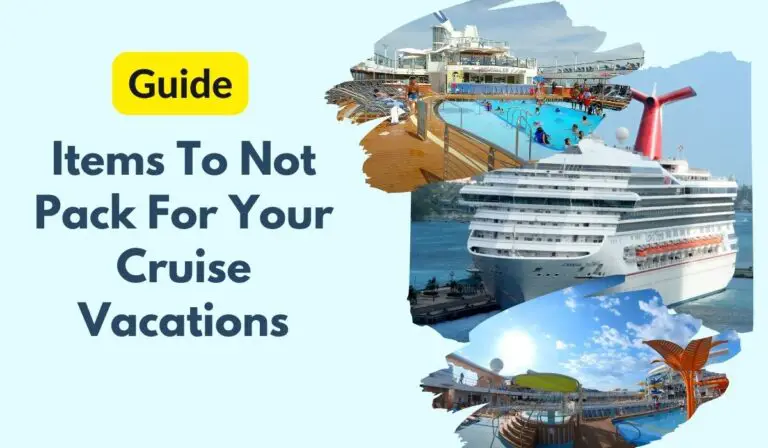
14 Items To Not Pack For Your Cruise Vacations
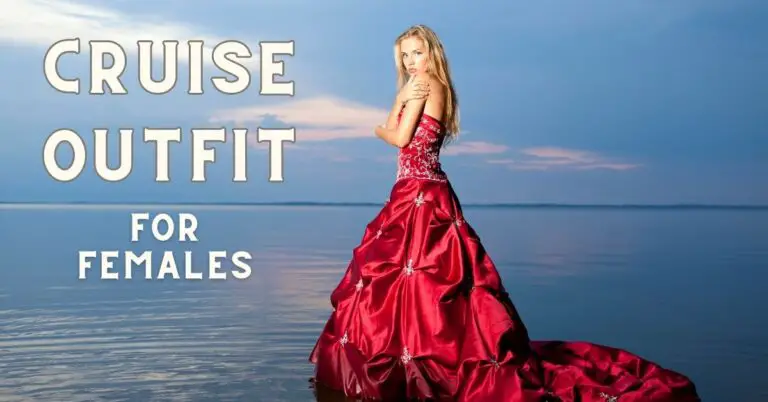
Cruise Clothes For Women: Stylish Cruise Attire Womens

10 Must Have Dollar Store Cruise Items And Hacks

Cruise Packing List: 24 Must Have Items To Pack For Cruise
Winter is here! Check out the winter wonderlands at these 5 amazing winter destinations in Montana
- Plan Your Trip
How Big Was The Titanic Compared To Modern Day Cruise Ships
Published: December 10, 2023
Modified: December 28, 2023
by Lynnett Teran
- Sustainability
Introduction
Welcome aboard as we embark on a journey to explore the fascinating world of cruise ships and delve into the question: How big was the Titanic compared to modern-day cruise ships? Cruises have long been a cherished form of vacation, offering the perfect blend of relaxation, entertainment, and exploration. From luxurious amenities to exciting on-board activities, these floating cities capture the imagination of travelers worldwide.
To truly appreciate the impressive scale of modern-day cruise ships, it is essential to look back at the history of ocean liners. And when it comes to iconic vessels, none can rival the grandeur and notoriety of the RMS Titanic. The Titanic’s tragic maiden voyage in 1912 still captivates the collective imagination, making it the perfect benchmark to compare against the colossal cruise ships of today.
Transporting us back in time, the Titanic was hailed as the “unsinkable” ship, a marvel of engineering and opulence. Its size alone was awe-inspiring, standing as the largest and most luxurious ship of its time. However, as technology evolved and maritime capabilities advanced, cruise ship designers sought to push the boundaries of size, amenities, and passenger capacity.
Modern-day cruise ships now have the capacity to host thousands of passengers and crew members, offering an array of dining options, entertainment venues, spa facilities, and an endless array of activities to suit every interest. Join us as we explore the dimensions of the Titanic and compare them to the behemoths that grace our seas today. So, grab your life jacket and let’s set sail!
Historical Background of the Titanic
In order to fully understand the magnitude of the Titanic’s size in comparison to modern-day cruise ships, it is important to delve into the historical background of this legendary vessel. The Titanic was a British passenger liner that was built by the White Star Line and was intended to be the epitome of luxury and opulence.
Construction of the Titanic began in 1909, and the ship was finally launched in 1911. It was the second of three Olympic-class ocean liners, with its sister ship, the RMS Olympic, having been launched a year earlier. These ships were designed to provide a superior level of comfort and style for transatlantic travel.
On April 10, 1912, the Titanic set sail on its maiden voyage from Southampton, England, with over 2,200 people on board. The ship was heading to New York City, but tragically, it never reached its destination. On April 14, 1912, the Titanic collided with an iceberg in the North Atlantic Ocean, resulting in one of the deadliest maritime disasters in history.
Despite the Titanic’s state-of-the-art design and advanced safety features, including watertight compartments and a double-bottom hull, the impact caused irreparable damage to the ship’s hull, leading to its rapid sinking. The lack of sufficient lifeboats on board exacerbated the loss of life, with only a fraction of the passengers and crew surviving the disaster.
The sinking of the Titanic led to significant changes in maritime safety regulations, resulting in the implementation of measures to ensure an adequate number of lifeboats and improved communication systems on all ships.
Today, the Titanic is remembered as both a triumph of engineering and a heartbreaking tragedy. Its story has been immortalized in books, movies, and exhibits, captivating the world with its tales of bravery, sacrifice, and the unforgiving power of the sea.
Dimensions of the Titanic
When it comes to size, the Titanic was an engineering marvel of its time. Built to showcase luxury and elegance, the ship was designed to impress both visually and in terms of scale. Let’s take a closer look at the dimensions of the Titanic.
The Titanic had a length overall of 882 feet and 9 inches (269.1 meters) – a staggering length that exceeded the previous record holder, the RMS Mauretania. Its breadth, or width, measured 92 feet and 6 inches (28.2 meters), offering ample space for the ship’s lavish interior amenities.
With a height, or depth, of 59 feet (18 meters) from the base of the keel to the top of the funnels, the Titanic boasted four impressive funnels, although only three of them were functional, with the fourth being purely for aesthetic purposes.
When it came to weight, the Titanic was truly a colossal vessel. The ship had a gross register tonnage of 46,328 tons, which refers to the total internal volume of the ship, including all enclosed spaces. In comparison, modern-day cruise ships can exceed 200,000 gross tons, showcasing the vast advancements in shipbuilding technology.
Another fascinating aspect of the Titanic’s dimensions was its total height, including the mast and its 150-foot (45.7-meter) long main mast. This added to the grandeur and gave the ship a commanding presence.
As we examine the dimensions of the Titanic, it becomes clear why this ship was hailed as a masterpiece of engineering and a symbol of opulence. Its sheer size and grandeur were unprecedented at the time and set the stage for the future of cruise ship design.
Modern Day Cruise Ships
Since the tragic sinking of the Titanic, the cruise industry has undergone remarkable advancements, resulting in the creation of modern-day cruise ships that are engineering marvels in their own right. These floating resorts offer a range of amenities and activities that cater to every passenger’s needs and preferences.
Modern cruise ships are designed to be floating cities, offering a plethora of dining options, entertainment venues, shopping arcades, spa and wellness facilities, swimming pools, sports courts, and even theaters. Passengers can indulge in gourmet cuisine, enjoy Broadway-style shows, participate in thrilling water slides, hit the gym, or simply unwind and soak up the sun.
One of the most notable advancements in modern cruise ship design is the inclusion of spacious and luxurious accommodations. From cozy cabins to expansive suites, passengers can choose the level of comfort and opulence that suits their preferences and budget.
The size and scale of modern cruise ships are truly awe-inspiring. These floating marvels can exceed 1,000 feet (300 meters) in length and can carry anywhere from 2,000 to over 6,000 passengers. They are equipped with state-of-the-art navigation systems, advanced stabilizers for a smoother ride, and comprehensive safety features to ensure a safe and enjoyable journey.
Another significant development in modern cruise ships is their eco-friendly technology. Many ships use advanced systems to minimize their environmental impact, such as energy-efficient engines, waste management systems, and even harnessing solar power. Cruise lines are making conscious efforts to be environmentally responsible and sustainable.
With the advent of modern cruise ships, the industry has experienced tremendous growth, allowing travelers to explore the most remote corners of the globe in style and comfort. From the icy landscapes of Alaska to the tropical beauty of the Caribbean, modern cruise ships offer endless possibilities for unforgettable vacation experiences.
So, whether you’re seeking adventure, relaxation, or a combination of both, modern-day cruise ships provide an unparalleled way to explore the world’s oceans while enjoying world-class amenities and services.
Comparing Size: Titanic vs Modern Cruise Ships
When it comes to comparing the size of the Titanic to modern-day cruise ships, the difference is astounding. The Titanic, once considered the epitome of luxury and size, pales in comparison to the massive floating cities that dominate the seas today.
As mentioned earlier, the Titanic had a length overall of 882 feet and 9 inches (269.1 meters). In contrast, the largest modern-day cruise ships can exceed 1,000 feet (300 meters) in length, including behemoths like Royal Caribbean’s Symphony of the Seas and Harmony of the Seas.
The passenger capacity of the Titanic was around 2,200 passengers and crew members. By comparison, modern cruise ships can accommodate anywhere from 2,000 to over 6,000 passengers, depending on their size and design. This substantial increase in capacity allows for more diverse onboard facilities and entertainment options.
Another notable difference in size comes with the gross tonnage of the ships. The Titanic had a gross register tonnage of 46,328 tons, while modern cruise ships can exceed 200,000 gross tons, emphasizing the significant advances in shipbuilding technology and design over the years.
Perhaps one of the most visually striking differences between the Titanic and modern cruise ships can be seen in the number of funnels. The Titanic had four grand funnels, but only three were functional. In contrast, modern cruise ships typically have fewer funnels, with most utilizing just two or even one, as advancements in propulsion technology have made multiple funnels unnecessary.
It is also important to note the stark contrast in terms of leisure and entertainment options. While the Titanic offered elegant dining rooms, a gymnasium, a swimming pool, and a squash court, modern cruise ships take the concept of onboard amenities to a whole new level. Passengers can enjoy multiple pools, water parks, rock-climbing walls, ice-skating rinks, zip lines, and even simulated surfing experiences. The range of dining options has expanded to include specialty restaurants and celebrity chef collaborations, catering to diverse culinary tastes.
Overall, comparing the size of the Titanic to modern cruise ships showcases the incredible advancements in shipbuilding, engineering, and passenger comfort. Modern-day cruise ships truly redefine the concept of luxury and offer a vast array of entertainment, dining, and accommodation options that were impossible to imagine during the era of the Titanic.
In conclusion, the comparison between the Titanic and modern-day cruise ships highlights the remarkable progress made in the cruise industry over the past century. The Titanic, once hailed as the largest and most luxurious ship of its time, now seems modest in comparison to the colossal floating resorts that grace our seas today.
From the immense size, passenger capacity, and luxurious amenities to the advanced technology and eco-friendly innovations, modern cruise ships have redefined the concept of luxury travel. They offer a wide range of activities, entertainment options, and dining experiences, catering to the diverse tastes and preferences of passengers from around the world.
While the Titanic will forever be remembered for its tragic fate, it played a significant role in shaping the maritime industry and influencing the future design, safety standards, and regulations of ocean liners and cruise ships. The lessons learned from the Titanic’s sinking resulted in significant advancements and improvements, ensuring safer and more enjoyable voyages for passengers today.
As we embark on new adventures aboard modern-day cruise ships, we can marvel at their vast size, stunning architecture, and incredible onboard facilities. These floating cities offer an immersive vacation experience, allowing passengers to explore different destinations while enjoying a wide range of activities and indulging in ultimate relaxation.
So whether you choose to cruise on a towering mega-ship or opt for a more intimate and boutique experience, the world of cruising offers something for everyone. The comparison between the Titanic and modern cruise ships serves as a testament to human ingenuity, technological advancements, and the continual pursuit of creating unforgettable travel experiences on the high seas.
Now, as we bid farewell to this fascinating exploration, may the legacy of the Titanic remind us of the importance of innovation, safety, and the enduring allure of the ocean as we continue to sail into new horizons on the modern giants that grace our waterways.

- Privacy Overview
- Strictly Necessary Cookies
This website uses cookies so that we can provide you with the best user experience possible. Cookie information is stored in your browser and performs functions such as recognising you when you return to our website and helping our team to understand which sections of the website you find most interesting and useful.
Strictly Necessary Cookie should be enabled at all times so that we can save your preferences for cookie settings.
If you disable this cookie, we will not be able to save your preferences. This means that every time you visit this website you will need to enable or disable cookies again.

The Size of Titanic Compared to Modern Cruise Ships: A Comprehensive Comparison
Titanic Compared to Modern Cruise Ships is the ultimate showdown of nautical giants. Prepare to be amazed as we unveil the staggering size differences between the legendary Titanic and today’s cruise ship marvels. Dive in and let’s navigate the evolution of these floating cities together!
The Titanic is one of the most famous ships in history, known for its tragic sinking in 1912. At the time of its launch, it was the largest ship in the world, measuring 269 meters long and 46,000 gross tonnage. Despite its size, the Titanic was not able to withstand the impact of an iceberg, leading to the death of over 1,500 passengers and crew members .
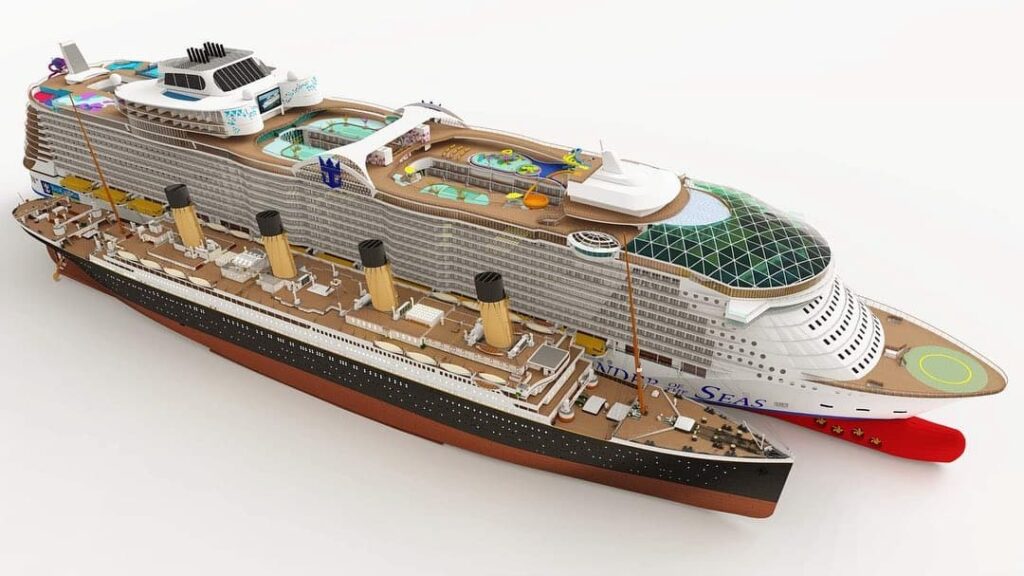
Today, cruise ships have become a popular mode of transportation and entertainment for millions of people around the world. With advancements in technology and engineering, modern cruise ships have grown significantly in size, making the Titanic look like a mid-size ship in comparison. This article aims to compare the size of the Titanic to modern cruise ships, highlighting the differences in length, height, and capacity.
By comparing the size of the Titanic to modern cruise ships, readers can gain a better understanding of how far shipbuilding technology has come in the past century. It also provides insight into the challenges and limitations faced by engineers and architects when designing and constructing ships of this magnitude.
Overall, this article will serve as a comprehensive guide for those interested in the history of shipbuilding and the evolution of cruise ships over time.
The Size of Titanic
Titanic’s size and dimensions.
When Titanic set sail on April 10, 1912, it was the largest ship in the world. The ship measured 269 meters in length, 28.2 meters in width, and 53.3 meters tall. These dimensions made the Titanic one of the most significant engineering feats of its time.
The Titanic’s size and dimensions were impressive for the early 20th century. For reference, an American football field is 109 meters long, meaning the Titanic was the length of almost two and a half football fields. The ship’s gross tonnage was 46,000, which was also impressive for the time.
The Titanic’s dimensions were not only impressive, but they were also instrumental in the ship’s design and capabilities. The ship’s length and width allowed for a spacious and luxurious interior, while the height of the ship made it possible for the Titanic to have multiple decks and accommodate a large number of passengers and crew.
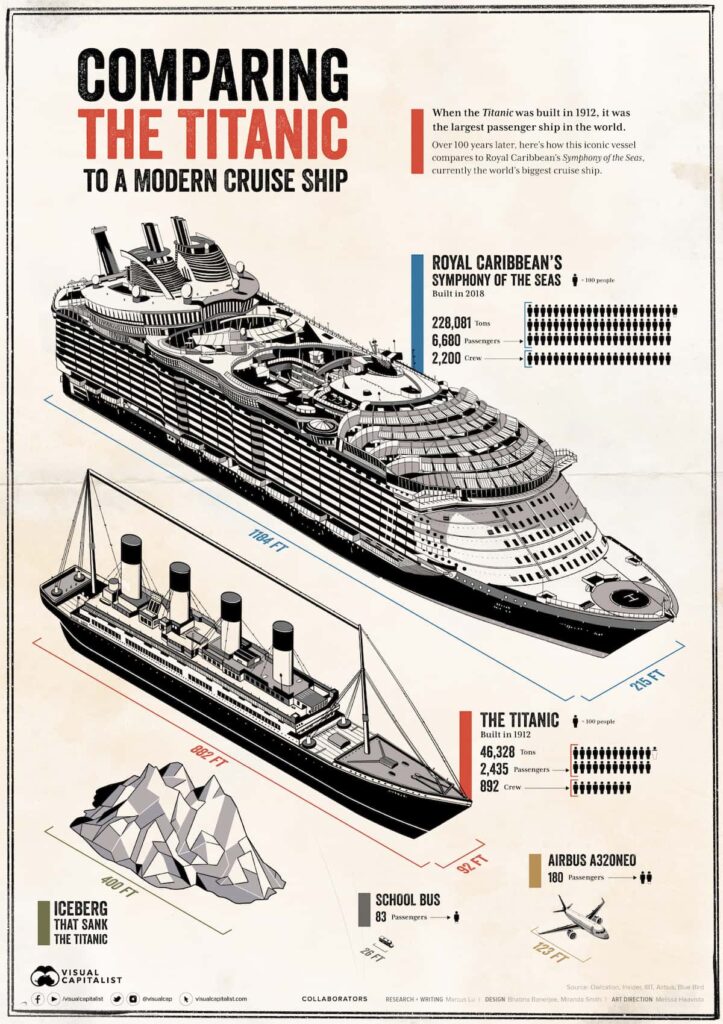
Passenger Capacity and Crew
The Titanic was designed to accommodate up to 3,547 passengers and crew. The ship’s passenger capacity was divided into three classes: First Class, Second Class, and Third Class. The First Class accommodations were some of the most luxurious of the time, while the Third Class accommodations were more modest.
The Titanic’s crew consisted of approximately 900 people, including officers, engineers, and crew members. The crew was responsible for operating the ship and ensuring the safety of the passengers.
Overall, the Titanic’s size and dimensions, as well as its passenger capacity and crew, were impressive for the time. Although the ship has been surpassed in size and capacity by modern cruise ships, the Titanic’s legacy continues to fascinate and inspire people around the world.
The Size of Titanic Compared to Cruise Ships
The RMS Titanic was a massive ship for its time, but compared to modern cruise ships, it is relatively small. The Titanic had a gross register tonnage of 46,328 tons, a length of 882.75 feet long (269 meters), and 92 feet wide (28 meters). It was considered the largest ship afloat when it was launched in 1912.
The Titanic had a total of 10 decks, with 3 of them being below the waterline. The ship had a maximum speed of 24 knots (44 km/h), and it could carry up to 2,435 passengers and 892 crew members.
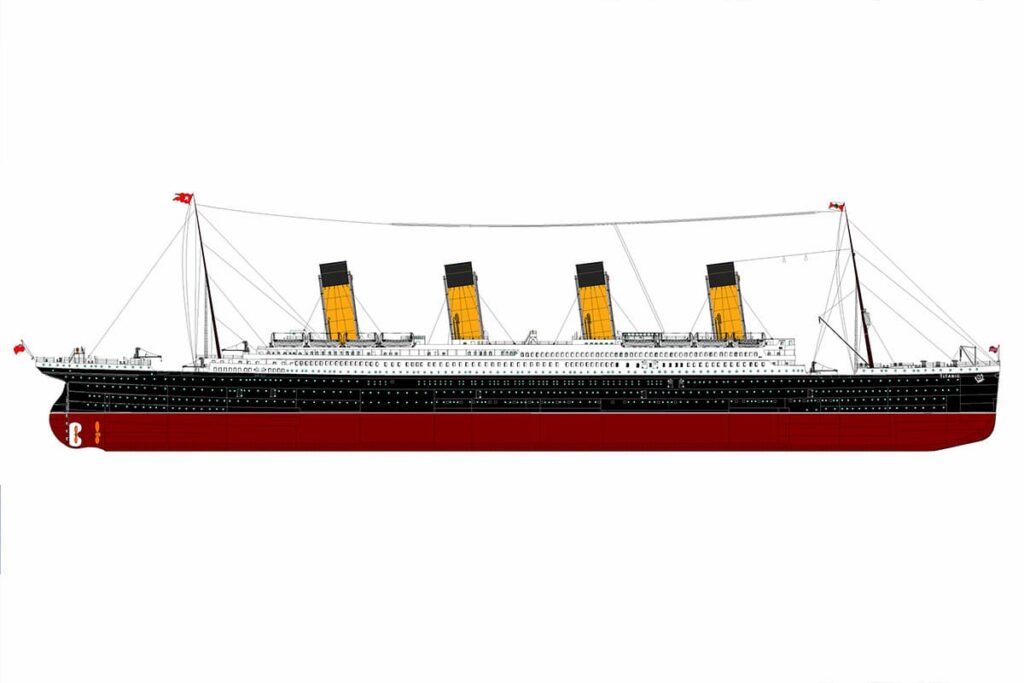
Cruise Ship Sizes Compared to Titanic
When compared to modern cruise ships, the Titanic is significantly smaller. The average cruise vessel today is around 298 meters long, just a few meters longer than the Titanic. However, modern ships are much larger than the Titanic in terms of gross registered tonnage, passenger capacity, and amenities.

For example, the largest cruise ship in the world as of 2023 is the Wonder of the Seas, which is 1,200 feet (368 meters) long, 215 feet (66 meters) wide, and has a gross tonnage of 236,857 mt. It can carry up to 6,988 passengers and 2,200 crew members. The Wonder of the Seas has 18 decks, 20 restaurants, a water park, a zip line, and many other amenities that were not available on the Titanic .
Other modern cruise ships, such as the Symphony of the Seas, Oasis of the Seas, the Allure of the Seas, and the Harmony of the Seas, are also significantly larger than the Titanic and offer many more amenities and activities for passengers.
Comparison of Titanic to Modern Cruise Ships
Size and dimensions of modern cruise ships.
Modern cruise ships are much larger than the Titanic. The Titanic was about 882 feet long, while the largest cruise ship today is around 1,184 feet long. The average modern cruise ship is 20% longer than the Titanic and twice as tall. The Wonder of the Seas, for example, is over 1,000 feet long and more than twice as wide as the Titanic. It has 24 pools, 22 restaurants, 2 rock climbing walls, an ice-skating rink, and more.
In terms of passenger capacity, the Titanic could carry around 2,200 passengers and crew, while the largest cruise ship today can carry over 6,000 passengers and crew. The Wonder of the Seas, the largest cruise ship in the world, has a gross volume of 236,857 GT and is five times the size of the Titanic.
Advancements in Technology and Design
Modern cruise ships have many technological and design advancements that the Titanic did not have. For example, modern ships have stabilizers that reduce the amount of movement felt by passengers in rough seas. They also have advanced navigation systems, satellite communication, and safety features like smoke detectors and sprinkler systems.
Modern ships also have a wider range of amenities and entertainment options. They have multiple swimming pools, water parks, theaters, casinos, and shopping areas. Some ships even have virtual reality experiences and skydiving simulators.
In terms of environmental impact, modern cruise ships are designed to be more eco-friendly. They use advanced wastewater treatment systems, energy-efficient lighting, and low-emission engines. Some ships even have solar panels and wind turbines to generate electricity.
Overall, modern cruise ships have come a long way since the Titanic. They are much larger, have more amenities, and are more environmentally friendly. The advancements in technology and design have made cruising a popular and enjoyable vacation option for millions of people around the world.
About the author
I worked as an officer in the deck department on various types of vessels, including oil and chemical tankers, LPG carriers, and even reefer and TSHD in the early years. Currently employed as Marine Surveyor carrying cargo, draft, bunker, and warranty survey.
Latest posts

What Are the Most Common Shipbuilding Woods?
While shipbuilders have switched to other practices, wood still has a place in the maritime industry. The numerous types available mean manufacturers have myriad options, so here’s a guide on shipbuilding woods.

Fiberglass vs. Steel: Which Is More Reliable?
Shipping professionals should get the most from their investment, so which is more reliable: steel vs. fiberglass? Here’s how to determine the better option.

What Does a Longshoreman Do?
Longshoremen play a critical role in the global supply chain, bringing billions worth of cargo into the country. So what does a longshoreman do exactly?
There are still secrets to be found on Titanic. These graphics explore them
It sank 112 years ago Monday, but our obsession with the RMS Titanic continues.
History's most famous ship slipped beneath the North Atlantic at 2:20 a.m. on April 15, 1912 , but we continue to explore its maiden voyage, iceberg, sinking and undersea decay through a seemingly endless stream of photographs, books , documentaries and movies , and museum exhibits.
Fascination has led to tragedy. A submersible carrying five passengers to view the Titanic imploded near the wreck , killing all aboard, in June 2023.
It also has brought technological advances. In May 2023, a new type of digital scanning, using multiple images, gave us a three-dimensional view of the ship as it would look if it were lifted out of the water .
Why are people drawn to Titanic?
"There isn’t a simple answer," says Karen Kamuda, president of the Titanic Historical Society , which operates the Titanic Museum in Indian Orchard, Massachusetts.
Those who join the society are of "all ages and occupations, and their interests are multivariable," Kamuda says. Aside from their fascination with Titanic and its passengers and crew, their curiosity might include the sister ships Olympic and Britannic, the White Star Line, artifacts, and TV and movies.
"James Cameron’s 1997 film, ' Titanic ,' opened up a brand-new interest," Kamuda says. "The internet has helped spread the story worldwide."
Here are a few things you may not know about Titanic:
Titanic traveled less than 3,000 miles
Titanic was built at the Harland & Wolff shipbuilding company in Belfast, Ireland. After outfitting and sea trials, the ship left port for her maiden voyage.
From Belfast to the fatal iceberg strike, Titanic traveled about 2,555 nautical miles, or 2,940 land miles:
April 2, 1912 | 8 p.m.: Titanic leaves Belfast, sails to Southhampton, England (577 nm).
April 10, 1912 | noon: Titanic leaves Southhampton, sails to Cherbourg, France (88 nm).
April 10, 1912 | 8:10 p.m.: Titanic leaves Cherbourg, sails to Queenstown ( now known as Cobh ), Ireland (341 nm).
April 11, 1912 | 1:30 p.m.: Titanic leaves Queenstown for New York.
April 14, 1912 | 11:40 p.m.: Titanic strikes iceberg 1,549 nm from Queenstown.
April 15, 1912 | 2:20 a.m.: Titanic sinks about 400 miles south of Newfoundland, Canada.
Titanic's lifeboats were not filled to capacity
15-ton piece of wreckage recovered.
The largest piece of wreckage recovered from Titanic, above, is a 15-ton section of the hull measuring 26 feet by 12 feet. It's on display at Titanic: The Artifact Exhibition at the Luxor Hotel in Las Vegas
The hull section was part of the starboard side of the ship , between the third and fourth funnels. It was lifted to the surface in 1998.
Museums keep Titanic's memory alive
A number of museums offer visitors a look at hundreds of objects recovered from the wreck site. Here are a few:
And if you can't get to a Titanic museum, a traveling exhibit, Titanic. The Exhibition , with 200 items, may be coming to you after it leaves New York.
Thousands of artifacts have been salvaged
Titanic was much smaller than today's cruise ships, want to learn more about titanic.
Historical associations are a good source of information.
- Titanic Historical Society: https://titanichistoricalsociety.org/
- Titanic International Society: https://titanicinternationalsociety.org/
- Belfast Titanic Society: https://www.belfast-titanic.com/
- British Titanic Society: https://www.britishtitanicsociety.com/
SOURCE USA TODAY Network reporting and research; Titanic Historical Society; titanicfacts.net; titanicuniverse.com; National Geographic; encyclopedia-titanica.org

When is Titanic II going to be built and what will it look like?
It’s 112 years to the day since the Titanic sank in the Atlantic, taking with it around 1,500 lives.
The tragedy has long held a fascination for people across the world, with no fewer than 31 films made about the liner’s doomed voyage from Southampton to New York .
They, of course, include James Cameron ’s 1997 megahit staring Leonardo DiCaprio and Kate Winslet .
Last month, Australian mining billionaire Mike Palmer announced that his plans to build a Titanic replica cruise ship called Titanic II are back on track after delays caused by Covid.
The project, managed by Mr Palmer’s company Blue Star Line, was launched in 2012 but stalled due to financial difficulties.
In 2018, it was announced building work would resume , but when the cruise industry shut down during the pandemic the project once again came to a halt.
In March, Mr Palmer told a press conference at Sydney Opera House they had ‘re-engaged with partners to bring the dream of Titanic II to life’.
When will Titanic II be completed?
Mr Palmer said construction would start January or February next year and that the ship is due to be completed by June 2027.
He told reporters: ‘The government lockdowns sent the cruise industry into a long-term shutdown but shipping is back in full business with passenger numbers now surpassing pre-Covid levels.
‘We are getting the best ship-builders, designers and engineers in the world back on deck to build Titanic ll.’
What will it look like?
Mr Palmer said the ship will offer passengers an ‘authentic Titanic experience’ but will be ‘far, far superior’ to the original.
It will feature the same interiors and cabin layout as the original vessel , but crucially (for anyone worried about the vessel meeting the same end as its predecessor) with modern safety procedures, navigation methods and technology as well as plenty more lifeboats.
‘The essence of this venture is to offer passengers an unparalleled journey back in time, immersing them fully in the opulence and splendour of life aboard the original Titanic, thus bridging a century with a voyage of unparalleled elegance,’ Mr Palmer said.
The ship’s maiden voyage will follow the route the original ship never completed, Southampton to New York, but will then travel the globe.
The vessel will weigh around 56,000 tons, measure 269 metres, feature nine decks and 835 cabins and cater for up to 2,435 passengers.
Just like its namesake, Titanic II will have 1st, 2nd and 3rd class cabins.
The new ship will also boast a replica of the bridge where the boat was controlled, but with 21st century technology.
It will be powered by a diesel engine and will feature four smoke stacks like the coal-powered Titanic.
Mr Palmer said: ‘Millions have dreamt of sailing on [the Titanic], seeing her in port and experiencing her unique majesty. Titanic ll will be the ship where those dreams come true.’
Last week it was reported an optical illusion caused by freak weather could have played a vital role in the Titanic tragedy.
It’s been suggested a mirage could have obscured the massive iceberg that struck the ship, leaving it impossible to spot in time.
Get in touch with our news team by emailing us at [email protected] .
For more stories like this, check our news page .
Get your need-to-know latest news, feel-good stories, analysis and more by signing up to Metro's News Updates newsletter
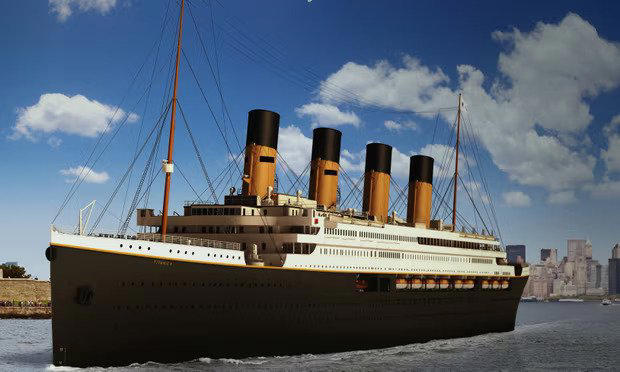

IMAGES
VIDEO
COMMENTS
Beam (Width) The Titanic had a beam (width) of 92 ft. (28 m). In comparison, modern cruise ships are much wider. For instance, Royal Caribbean's Icon of the Seas has a beam of 159 ft (48 m), and the Wonder of the Seas measures slightly narrower at 155 ft. (47 m). Even Royal Caribbean's smallest ship, the Majesty of the Seas, has a beam of ...
With accommodations for 6,680 passengers, the Symphony of the Seas also supports a crew that is 147% larger. The Symphony of the Seas clearly surpasses the Titanic in terms of size, but there's also a substantial difference in cost. When converted to today's dollars, the bill for the Titanic equates to roughly $400 million, less than half ...
3,998. Titanic Size Comparison. Compared to today's cruise ships, the Titanic just can't stand up. It even cost a tiny amount to build compared to today's cruise ships. At today's costs ...
A7: The cabins on modern cruise ships tend to be much larger and more luxurious compared to those on the Titanic. Passengers can expect spacious accommodations with amenities such as private balconies and state-of-the-art entertainment systems. "Discover the key differences between the Titanic and modern cruises.
People were astonished by the sheer size of the "unsinkable" Titanic. When it comes to Titanic's length, she was 882 feet long. In comparison, Wonder of the Seas is 1,187 feet long, which is around 35% longer. As the world's largest cruise ship, Wonder of the Seas holds 8,000 passengers. Keep in mind that Wonder of the Seas is substantially ...
Titanic: Approximately 882 feet in length and 46,328 gross tonnage. Modern Cruise Ships: Often exceed 1,000 feet with some over 200,000 gross tonnage. Titanic: Limited lifeboats, relying on visual spotting for navigation, lacked modern communication tools.
At about five times the size of Titanic, the world's largest cruise ship is Royal Caribbean's Icon of the Seas. Spanning 20 decks, Icon is the first in the Icon Class to be launched. A second ship, Star of the Seas, will launch in 2025 and likely take the title of biggest in the world. Size is everything with Icon, as she is 1,198 feet long.
The 20-deck-tall Icon of the Seas, by comparison, measures in at a whopping 250,800 gross tons, stretching 1,198 feet long and 213 feet wide. That makes the new ship twice as tall (excluding ...
The RMS Titanic had a gross register tonnage of 46,329 tons, 882 feet 9 inches long (269 meters), and 92 feet wide (28 meters). The Titanic's gross registered tonnage was 46,329 GRT. Modern ships are much larger than the Titanic. Modern cruise ships are on average 20% longer and twice as wide as the Titanic.
In comparison, the modern cruise ship version of the Titanic — aka the world's largest passenger vessel — is Royal Caribbean's Icon of the Seas at the time of publication. It is 1,198 feet long and measures 250,800 GRT — a staggering five times the size of the Titanic by volume. It also boasts more than twice the number of decks, with 20.
The Titanic's gross tonnage was 46,328 while the average ship in today's world would have a gross tonnage of around 77,000. So the Titanic was around 40% smaller than your average cruise ship today. Gross tonnage isn't anything to do with the weight of the ship, despite the word "ton" being in the term.
The tallest building in 1912 was just 390 feet high. Today it's 2,717 feet! Compare that to the Titanic's length of 883 feet vs the biggest cruise ship today length of 1,184 feet. Let's now compare the Titanic vs modern cruise ships on each major metric. For more context, we also measure her against the Symphony of the Seas.
By averaging the lengths of cruise ships from the major cruise lines, we can say that modern ships are about 20% longer than the Titanic. The total length of the Titanic was 882 feet (269 meters), whereas Royal Caribbean's longest ship reaches 1,196 feet (365 meters). The difference is somewhat smaller when we compare the Titanic with ...
Titanic's gross tonnage of 46,328 was a record for her day, even though it was smaller than most current cruise ships. Compared to the Titanic, this weighs more than 150%. Modern cruise ships, by contrast, have a weight of around 120,000. The world's biggest cruise ships have a combined gross tonnage of more than 230,000 tonnes.
Modern cruise ships are, on average, 20% longer than the Titanic and twice as high. The average Royal Caribbean cruise ship is 325 meters long, 14 decks high and has a gross tonnage of 133,000. In comparison, the Titanic was only 269 meters long, 9 decks high, and had a gross tonnage of 46,000. The sinking of the Titanic happened over 100 years ...
The Titanic was one of the largest ships of its time, with a gross registered tonnage of 46,328 GT. However, by today's standards, it would be considered quite small. In fact, the largest cruise ship today, Wonder of the Seas, has a gross tonnage of 236,857 GT, which is over five times larger than the Titanic.
The Titanic was significantly smaller than modern cruise ships, with a length of 882 ft 9 in compared to cruise ships that can be up to 1,188 ft long. The Titanic had a capacity of over 2,400 passengers and crew members, while modern cruise ships can accommodate over 6,000 passengers and 2,000 crew members.
The Titanic is one of the most iconic ships in history that fascinated people and left many to wonder how big was The Titanic compared to Modern Cruise Ship behemoths like wonder of seas.. The Titanic, once hailed as the largest and most opulent passenger liner ever built, now pales in comparison to the wonders of the sea that grace our oceans today.
The Titanic Compared To Modern Cruise Ships. When it comes to size, it's no contest - at the time of its construction, the Titanic was the largest ship constructed in the world, measuring 882 feet long, 92.6 feet wide, 175 feet tall, and with a gross tonnage of 46,329. In contrast, the Wonder of the Seas, currently the largest modern cruise ship in the world, measures 1,187 feet long, 210 ...
The Titanic Was the Largest Ship of Its Time. Let me begin with the fact that the Titanic was a large ship for its time. It was longer than the famous Lusitania (1906) by more than 100 feet.The Lusitania itself was 790 feet in length. Before construction of the ship, three berths at the Belfast shipyard had to be modified to accommodate the Titanic and its two sister ships, the Britannic and ...
Titanic Vs Modern Cruise Ships: Fare Comparison. Cruise fares always remain one of the major considerations among the folks. Well, over time, the world has gone through so many crises and money inflammation, that's why you may notice a substantial difference between the fare of the Titanic and the modern cruise.
The Titanic, once hailed as the largest and most luxurious ship of its time, now seems modest in comparison to the colossal floating resorts that grace our seas today. From the immense size, passenger capacity, and luxurious amenities to the advanced technology and eco-friendly innovations, modern cruise ships have redefined the concept of ...
The Size of Titanic Compared to Cruise Ships Titanic's Size and Dimensions. The RMS Titanic was a massive ship for its time, but compared to modern cruise ships, it is relatively small. The Titanic had a gross register tonnage of 46,328 tons, a length of 882.75 feet long (269 meters), and 92 feet wide (28 meters). ...
These graphics explore them. It sank 112 years ago Monday, but our obsession with the RMS Titanic continues. History's most famous ship slipped beneath the North Atlantic at 2:20 a.m. on April 15 ...
The vessel will weigh around 56,000 tons, measure 269 metres, feature nine decks and 835 cabins and cater for up to 2,435 passengers. Just like its namesake, Titanic II will have 1st, 2nd and 3rd ...